

Sepilok Orangutans: Ultimate Bucketlist Orangutan Experience in Borneo
By: Author Angela Price
Posted on Last updated: January 25, 2024

Seeing an orangutan in the wild has always been on my bucket list, so with that in mind, I booked a four-week trip to Malaysia primarily to visit the world-famous Sepilok Orangutan Rehabilitation Centre in Borneo and observe the Sepilok orangutans who call the forest their home.
I am lucky to have had many amazing animal encounters worldwide, but there was one animal experience I was desperate to have: to see an orangutan in its natural environment.
There are only two places in the world where this can be done: Borneo in Malaysia and Sumatra in Indonesia, so this was to be my once-in-a-lifetime chance to see an orangutan.
So what was visiting Sepilok Orangutan Rehabilitation Centre like, and did the orangutans come and say hello? Read on to discover how seeing the Sepilok orangutans made all my dreams come true.
This travel guide may contain affiliate links – please read my disclaimer and privacy policy for more information.
Table of Contents
Frequently Asked Questions about Sepilok Orangutan Rehabilitation Centre
Are you guaranteed to see orangutans at sepilok.
I will be honest and say that seeing orangutans come swinging through the jungle onto the feeding platform is the luck of the draw.
I visited three times in two days while staying next door at the Sepilok Nature Resort. I only saw six orangutans roaming freely, not including the juvenile orangutans who live in the outdoor nursery, of which I saw quite a few.
One orangutan came to the feeding station each day, and I saw one mother and child along the boardwalk on one of the days and then two orangutan friends on another.
The anticipation of seeing an orangutan is hard to describe. It’s like an adrenaline build-up, and when you see the trees rustling and catch a glimpse of orange, it is the most exciting feeling to experience.
However, you must be prepared not to see an orangutan, as they are wild creatures and live according to their own schedules!
Check out this video!
But guess what? The beautiful thing about the Sepilok orangutan rehabilitation centre is that it is not staged or forced. If the apes don’t want to come along and say hello, then they won’t. They are wild and free to do precisely as they wish.
Of course, it was disappointing, and even I felt a pang of sadness at not seeing any more than I did; however, every cloud has a silver lining, as we found out from one of the rangers that patrol the boardwalks.

Not seeing an orangutan is actually a good thing.
If the orangutans don’t come along at feeding time, it’s a good thing. It means they are coping in the jungle alone and don’t need human intervention.
So even though they know a new stash of bananas and other fruits and vegetables will be waiting for them twice a day, they don’t need it and are happy wherever they are in the forest, which means their rehabilitation has succeeded.
How many orangutans are in the Sepilok Rehabilitation Centre?
We were told that the estimated figure is around 85. The rehabilitation centre is in the Kabili Sepilok Forest Reserve, 43 sq km of virgin lowland equatorial rainforest, so the orangutans have a fair chunk of the jungle to live in.

Why are the orangutans at Sepilok?
When arriving at the Sepilok orangutan centre, the first place to visit is the educational room, which gives you plenty of information about the orang utan (man of the forest) and its plight.
Sepilok is the world’s leading rehabilitation centre for orangutans. It has worked tirelessly for the last 60 years to protect and preserve this ape species, which amazingly shares 97% of its DNA with us.
Most of the Bornean orangutans cared for at Sepilok are orphaned orangutans. They are left without a mother for one of many reasons. Deforestation, trafficking, forest fires, and human population pressures, to name a few. They are often found abandoned, alone, ill, or too young to forage and feed themselves.
Some have been kept as pets, and some are injured or displaced wild orangutans.
This is where the marvellous vets and volunteers at Sepilok step in to aid in the recovery and rehabilitation of the orangutans.

How do young and juvenile orangutans learn how to survive?
When baby orangutans arrive at Sepilok, they enter the indoor nursery, where they are cared for until they are strong and confident enough to be moved outside.
Once they are ready, they are moved to the outdoor nursery, which is open. There, they can choose whether to venture into the edges of the dense jungle. The area has feeding platforms and ropes so the orangutans can play together.

Younger orangutans are paired with an older buddy who can teach them the way of the orangutan, much like a child would be paired up with a friend at a new school.
This orangutan looked like one of the older juveniles with his thick fur coat.

Close bonds are formed, and some orangutans stay close to their buddy for the rest of their lives. We saw this happen with two older orangutans who we saw walking along the boardwalk.
I asked the warden if it was mum and child, and he said no, they were just two best friends helping each other through life. If there was a moment my heart melted, it was then!
I took a short video of the two best friends, and I felt that when the smaller one looked around at me, he was checking me out rather than the other way around; it was magical.
Can you observe the young orangutans at Sepilok?
Yes, and it is fascinating. You can watch the juveniles through a floor-to-ceiling window in the indoor viewing area. They are outside, and you can observe them interacting with one another, playing, eating and, most of the time, hanging by their toes or fingers from the ropes.
I visited the nursery viewing area on both days and saw different orangutans each time. To say I was mesmerised by them is an understatement.
I just sat and stared at them for about 30 minutes each time. I had to keep pinching myself, as I couldn’t believe I was in Borneo and finally with the orangutans!

The tiny babies are cared for in the indoor nursery 24 hours daily. This part of the centre is closed to visitors as they are susceptible and vulnerable to human diseases.
How close can you get to an orangutan?
The feeding platform is a fair way away from the viewing deck, so while you can see them clearly, getting close-up shots of the orangutan is tricky unless you have a powerful lens.

I was fortunate to meet up with a lovely couple from Australia staying at our resort who had a zoom lens, and Claire was kind enough to let me use a few of her images for this article.

If you are lucky enough to have an encounter with an orangutan as you move around the boardwalk, you need to keep a healthy distance away.
We met with an orangutan on two occasions, and a keeper made sure we kept moving along in time with the orangutan’s speed.

He made us aware that an orangutan, especially one with an infant, could react quickly if feeling threatened and that the ape’s strength could severely injure a human, and by the tone of his voice, he wasn’t joking!
Useful information about Sepilok Orangutan Rehabilitation Centre.
Where is the rehabilitation centre.
In Kabili-Sepilok Forest Reserve, Sabah, Borneo, Malaysia.

It is a 30-minute drive from Sandakan to Sepilok, so most independent visitors try to book themselves into one of several jungle resort hotels near Sepilok Orangutan Sanctuary . Tours around Borneo, which include visiting Sepilok, are also available with many local travel companies.
That said, if you are planning a quick visit after landing at Sandakan airport, a taxi can take you to the centre, or a bus from Sandakan runs around four times a day and takes around 45 minutes.
I stayed at Sepilok Nature Resort , which was next door to the centre. Not only was it a slice of jungle heaven, but because it was so close, we were fortunate to see two orangutans swing in while we were having breakfast. Watching wild Sepilok orangutans having breakfast in the trees while we watched from the ground was a dream come true!

When is the best time of year to visit Borneo?
Sepilok Orangutan Centre is open all year round. If you want favourable weather conditions in Borneo for your visit, the best time is in the summer months, June, July and August, when it is dry with only light showers.
That said, I visited Borneo in June and had quite a bit of rain to contend with, some even torrential.
I checked with the locals to see if this was normal, and they assured me it wasn’t. Unlike mainland Malaysia, where rain is almost always guaranteed during summer, in Borneo, it is the opposite, and the summer months should be the best time to visit.
When is the Sepilok feeding time?
Twice a day at 10 am and 3.00 pm. There is no real rush, as orangutans are slow eaters, so even if you arrive after those times, you will probably still get to see some action (if the orangutans show up).
However, it is best to arrive early to see the 30-minute presentation; visit the outdoor nursery first and then proceed to the feeding platform, which is about a 10-minute walk from reception.

How much does it cost to see the orangutans?
Your ticket will cost 30RM (£5) / ($6) for foreign tourists and will allow you to attend both feedings that day.
When is the Sepilok orangutan sanctuary open?
The centre opens at 8:30 a.m., and tickets go on sale at 9:00 a.m. for the morning session, which is 9:00 a.m.- 12:00 p.m., and again at 2:00 p.m. for the afternoon session, which is 2:00 p.m. until 4:00 p.m.
The centre closes for lunch each day between 12:00 p.m. and 2:00 p.m. If you arrive during these times, you won’t get in.

Can I take my belongings to the centre with me?
No. Before you are allowed to enter the jungle, you must put your bags, food, and water in a free, secure locker.

Can I take a camera with me?
Yes. However, if you are using a professional camera and lens, a fee is payable in addition to your entry ticket. Phone cameras can be used without a charge.
Are there any facilities at the centre?
There is a cafe, toilets and a car park close to the reception area.
How do I adopt a Sepilok orangutan?
During their rehabilitation, the animals rely heavily on the help of volunteers who work at the centre and also on donations from visitors. During my visit, I chatted with one of the volunteers, an English girl who had worked out there before and returned because she just loved the work the centre was doing.
After my visit and chatting with her, I adopted an orangutan called Archie, whom I had seen in the outside nursery. He was a juvenile who loved walking upright, just like a human!
He also had a habit of crossing his arms across his body, which made him look a bit like a boy band member; all he needed was a baseball cap with its peak turned to the back, and he’d be ready to go!
You can support the amazing work at the Sepilok Orang Utan Rehabilitation Centre in conjunction with the Sabah Wildlife Department. You can adopt a Sepilok orangutan by clicking the Orangutan Appeal UK adoption link. Strangely, its HQ is in Hampshire in the UK, not the Borneo jungle, as might be expected.
I am proud that my home country supports these incredible creatures living so far away.
Meet Archie, my adopted orangutan.

After you have been a sponsor for six months, you receive an update on your orangutan and some new photographs. It seems Archie is doing well and fending for himself in the jungle. Look how he has grown!

Are there any other animals at Sepilok Rehabilitation Centre?
While visiting the orangutans, you will see plenty of macaques who love to pinch the food put out for the orangutans. The two ape species seem to live in harmony, and even though we watched the macaques eat all the bananas before the orangutan had even looked at them, there were no hard feelings.
Sepilok is also a rehabilitation centre for other threatened and injured wild animals; however, you won’t be able to see them.
While we were there, we heard the trumpeting of an animal and were told a large elephant was being looked after by the centre but wasn’t too happy at the moment because he was poorly. To say his trumpet sounded like a dinosaur roar was an understatement!
Across the road from the centre is the Bornean Sun Bear Conservation Centre. This is another place doing incredibly vital work in rescuing and rehabilitating beautiful but vulnerable sun bears and giving them space to roam around the jungle.
Is Sepilok Orangutan Rehabilitation Centre worth visiting?
My answer is a big fat YES! Seeing Sepilok orangutans living out their best lives in a jungle environment is a bucket list experience I recommend to anyone travelling to Malaysia.
It is a privilege to see these mighty orange forest dwellers in one of the only places left in the world to see orangutans in the wild , and I am so happy that I could learn more about them and be in their company.
Of course, some organised Borneo trips take you deeper into the jungle along the Kinabatangan River to see Borneo’s wild animals. Still, we felt we were happy enough just to see the orangutan at the Sepilok Centre, as there is no guarantee that you will see any more on a river safari. Also, a lot of travelling is required to get deep into the Borneo jungle.
I hope this post has inspired you to visit Sabah and see the Sepilok orangutan rehabilitation centre yourself.
Did you find this post useful? Save this PIN to your travel boards for future travel to Malaysia.

Do you need to arrange travel insurance, car hire or accommodation? Please check out my resources page to help you plan your trip.
Are you looking for further travel inspiration for Malaysia? Please check out the following posts:
Discover Penang in 3-Nights: The Best George Town Travel Itinerary
Blue Mansion Review: The Best Heritage Hotel in Penang
Shangri-La Rasa Sayang Resort Review: Beachfront Luxury in Penang
Chew Jetty: What To See in Penang’s Historic Waterfront Village
Pinang Peranakan Mansion: A Tour of Penang’s Heritage Museum
7 Best Places to See Orangutans in the Wild
Getting Around Malaysia: The Best Sightseeing Road Transfers with Daytrip
Exploring Malaysia: 20 Best Places and Most Unique Experiences
Is Ipoh Worth Visiting? Here’s 13 Reasons Why You Should Visit Ipoh in Malaysia
Gua Tempurung: Explore the Limestone Cave in Perak, Malaysia
I would like to receive occasional updates and new travel posts.
Notify me of follow-up comments by email.
Tuesday 25th of July 2023
Definitely one trip I have been wanting to take my wife and kids on for a while. The information in this article has made my mind up to go. Love the video of the friends.
WhereAngieWanders
Thanks for the comment, I am please it has made your mind up to take your family to see the orangutans and the two friends in the video were adorable. If you have any questions that I can help answer please feel free to contact me.
Events & Festivals
Food to Try
Best Time to Visit
Weather & Climate
Airports in Borneo
Best Hotels in Borneo
Staying at an Iban Longhouse
Driving in Borneo
One Week in Borneo
Top Destinations in Malaysian Borneo
Sarawak vs. Sabah
Guide to Kuching
Visiting Kalimantan
Guide to the Derawan Islands
Brunei Travel Guide
Top Things to Do in Malaysian Borneo
Museums to Visit
Best Beaches
Where to Go Scuba Diving
Best Hiking in Borneo
National Parks
Where to See Orangutans
5 Places to See Orangutans in Borneo
With their ability to learn sign language and even to make tools, orangutans are considered one of the world's smartest primates. Orangutans in Borneo even begin to craft umbrellas from leaves when they know rain is coming!
Sadly, the orangutans in Borneo are struggling to survive in the wake of massive deforestation. Even an illegal pet trade threatens the species. Visiting rehabilitation centers not only offer a memorable encounter, but your visit also helps to support conservation efforts to protect one of Earth's smartest residents.
Learn more about the endangered orangutans, then read about where to find them in Borneo.
Semenggoh Wildlife Rehabilitation Centre
The Semenggoh Wildlife Rehabilitation Centre, just 12 miles from Kuching , is the best place to find orangutans in Sarawak. Unlike zoos which simply leverage orangutans as attractions, the primary mission of Semenggoh is to reintroduce orangutans back into the wild. The animals are not kept in cages; instead, they are allowed to roam freely within a large area.
Visitors to the Semenggoh Wildlife Rehabilitation Centre can join a group and hire a ranger for a forest tour in hope of finding wild orangutans in the trees. Alternatively, two daily feeding times nearly guarantee a spotting of the shy primates.
Kubah National Park
The Kubah National Park in Sarawak is located 13 miles west of Kuching. The Matang Wildlife Centre, nestled within the interior of the national park, is home to several resident orangutans. Visitors must hike three to four hours along the Ulu Raya trail through the national park to reach the wildlife center.
Sleeping in the Kubah National Park increases your chances of spotting orangutans; book the simple dorm-style accommodation through the Forestry Office in Kuching.
Sepilok Orangutan Rehabilitation Centre
Perhaps the most famous place to see orangutans in Borneo, the Sepilok Orangutan Rehabilitation Centre is a popular draw in East Sabah . Visitors can climb tall platforms to observe orangutans in the trees, although sightings are never guaranteed.
Fruit is placed on feeding platforms twice daily; shy orangutans brave a barrage of tourists' cameras to take the offering before retreating back into the forest.
Lok Kawi Wildlife Park
A great option for people without much time in Sabah, the Lok Kawi Wildlife Park is only 30 minutes away from the capital of Kota Kinabalu. The 280-acre wildlife center is home to several tigers, elephants, orangutans, and other protected animals.
While the animals are kept in large enclosures, every effort is given to make the setting as close to the natural habitats as possible.
To reach Lok Kawai Wildlife Park, take southbound bus #17 to the town of Lok Kawi, then hail a taxi to the park.
The Kinabatangan River
For a wilder approach to seeing orangutans in rehabilitation centers, make your way from Sandakan in East Sabah to the tiny village of Sukau . Boat cruises along the Kinabatangan River offer a chance to see a variety of wildlife including orangutans, proboscis monkeys, and even elephants.
Several small lodges along the Kinabatangan River offer accommodation and book boat tours. Boats are typically small speedboats run by knowledgeable guides who know where to look for orangutans. Lucky travelers get to see the primates along the riverbanks in a completely natural habitat!
How to Find Cheap Flights to Borneo
One Week in Borneo: The Ultimate Itinerary
The Top 12 National Parks in Malaysia
A Guide to Airports in Borneo
9 Top Destinations in Malaysian Borneo
The Top 8 Things to Do in Malaysian Borneo
Where to Go in Malaysian Borneo: Sarawak or Sabah?
Your Trip to Borneo: The Complete Guide
Guide to Sandakan, Malaysia's Gateway to Nature
Sukau in Sabah, Malaysia
The 12 Best National Parks in Borneo
The 10 Best Hikes in Borneo
10 Top Things to Do in Kuching, Sarawak
The 11 Best Hotels in Borneo
The Top 12 Things to Do in Malaysia
Eight Awesome Zoos in Southeast Asia

A Complete Guide to Seeing the Orangutans in Borneo
If you’ve been dreaming of seeing the orangutans in real life, then chances are Borneo is the place you’ve been imagining. And it sure sounds far-flung and hard to get to, but it’s surprisingly more accessible than you might think. A trip to Borneo can be done on a budget, but it can also be done in pure luxury. So this guide aims to cover everything you need to know about visiting Borneo – particularly Malaysian Borneo – including how to get there, where to go, what things cost and of course – where to see the orangutans in Borneo. Read on to find out more!
Where to see orangutans in Borneo?
First things first, it’s key to understand a little more about Borneo. Beautiful Borneo is the third largest island in the world, and by far the largest island in Asia. Borneo is home to three countries – Indonesia, covering the southern portion, Malaysia, covering the northern portion, and Brunei, occupying a teeny tiny 5,765km 2 (about 1% of the land mass!) and surrounded entirely by Malaysia.
Orangutans can be found in both Malaysian Borneo (split up as two Malaysian states called Sabah and Sarawak) and Indonesia (spit into the provinces of West, Central, South, East and North Kalimantan).
The only other place to see orangutans in the world is the island of Sumatra in Indonesia. So there are two species of orangutans – the Sumatran species and the Bornean species. Both have 96.4% identical DNA to humans!
And did you know that orangutans are the only great ape to be found outside of Africa? The others – gorillas, chimpanzees and bonobos are all found in Africa.
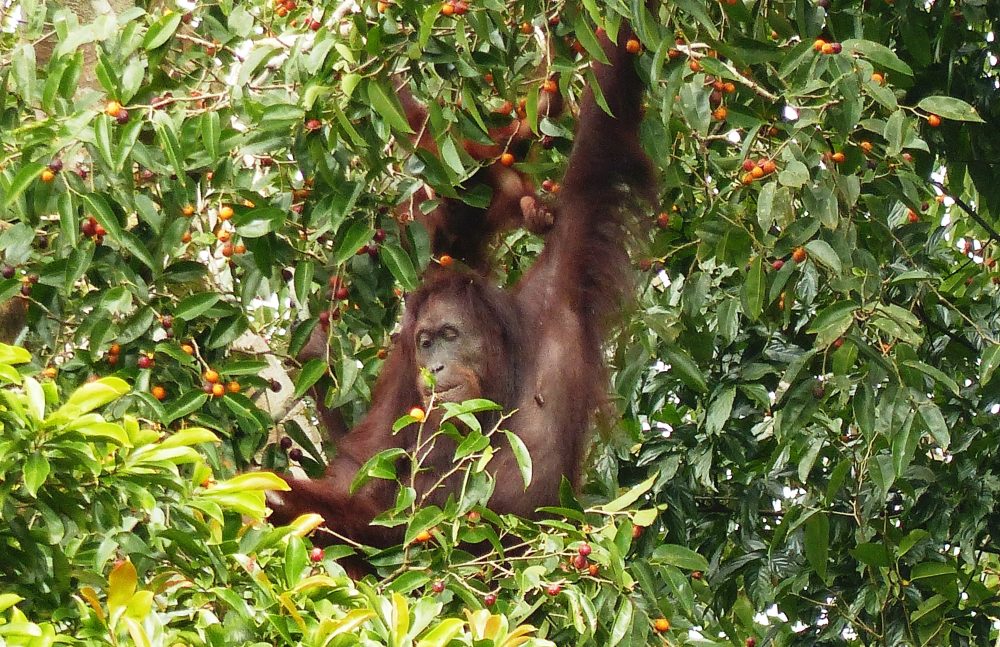
Malaysian Borneo or Indonesian Borneo?
One of the first decisions to make is deciding whether to go to the Malaysian part of Borneo, or the Indonesian part.
I did a lot of research before embarking on this trip. In the end, I opted for Sabah in the Malaysian part of Borneo in the north. There were a few reasons for this. For one I was flying into Kuala Lumpur, which had affordable and convenient connections onto Sandakan. And I’d read that animal sightings were more common as the area was smaller (covering only about 25% of the island). Tourism infrastructure is also more developed here, and I had identified some accommodation and tours that really met my expectations, and so, I was set on northern Sabah – specifically around the Kinabatangan River.
This part of Borneo is also home to Mt Kinabalu (one of the highest mountains in the world!), and also the vibrant city of Kota Kinabalu – two locations I was also very keen on seeing.
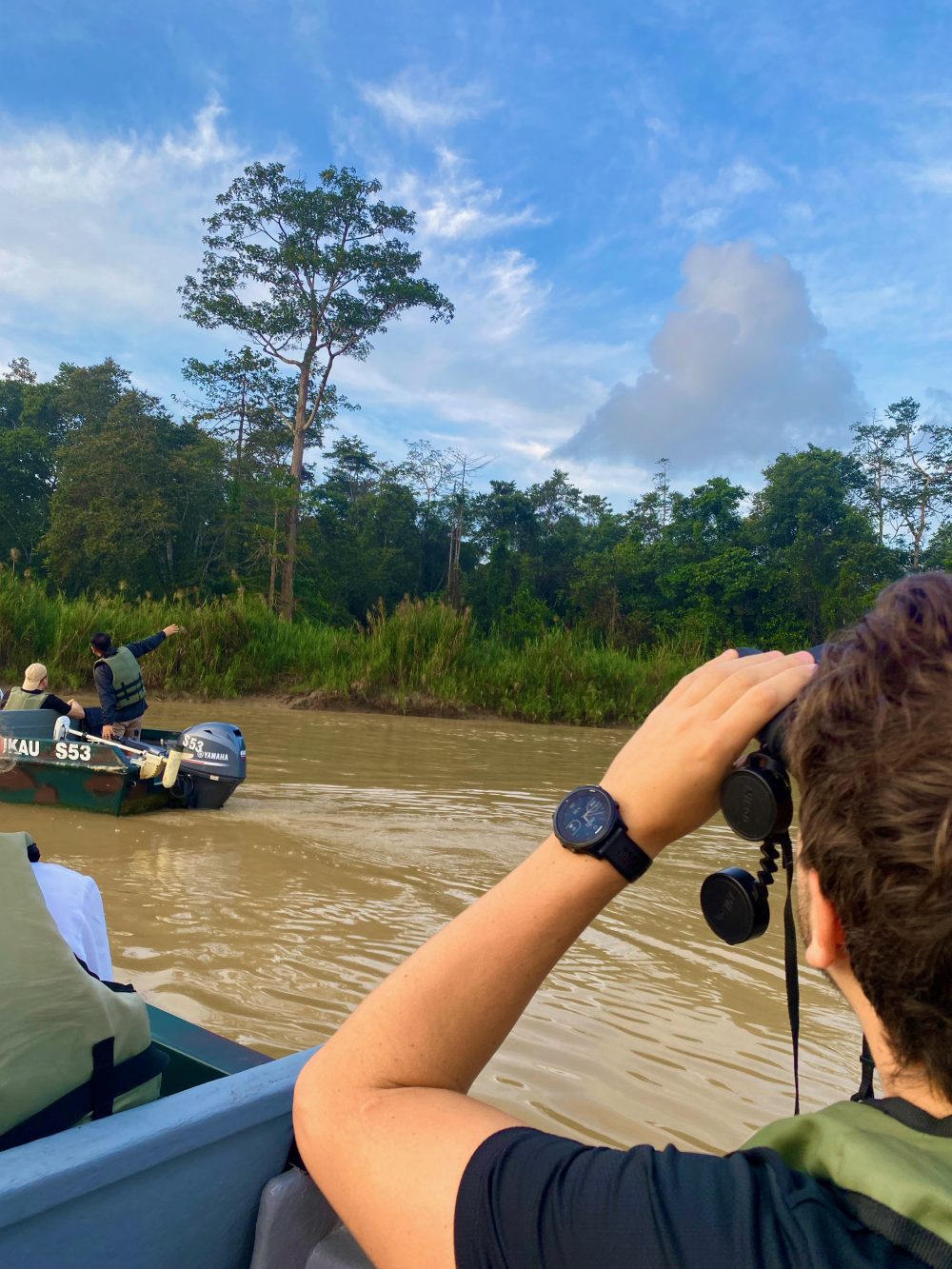
The state of Sarawak is slightly more challenging to get to – the main airport is Kuching. But Sarawak is home to 30 national parks covering its magnificent rainforest, mountains and coastline. Sarawak offers a deeper dive into indigenous tribes, traditions and cultures. I found we saw less of this in Sabah, which has a more established tourist setup compared to Sarawak.
Kalimantan Indonesia is even more far flung. It covers a whopping 76% of the island of Borneo, so it can be harder to see orangutans in the wild – especially as the tourism infrastructure is still somewhat limited here.
The Indonesian states and the Malaysian state of Sarawak both provide a complete adventure and incredible wildlife, but for the purpose of the rest of this guide, I will be focusing on Sabah.

Borneo Travel Guide: Useful Information
How to get to sabah, borneo.
The main way to arrive in Sabah is by plane. The two main entry points are either Kota Kinabalu, the capital, or Sandakan, the airport nearest the northern rainforest area.
We flew into Sandakan to begin our adventure. Then at the end of the week, we took a very quick internal hop from there to Kota Kinabalu, which is where we flew onwards to Manila .
Air Asia and Malaysian Airlines both fly to Sandakan from Kuala Lumpur multiple times a day, with the flight taking about 3 hours. This flight often costs as little as £30. You can also start your Borneo journey in Kota Kinabalu if arriving from other Asian cities such as Singapore, Taipei, Penang, Seoul or Hong Kong. Flights between Kota Kinabalu and Sandakan take about 40 mins and can be as cheap as £15 or so.
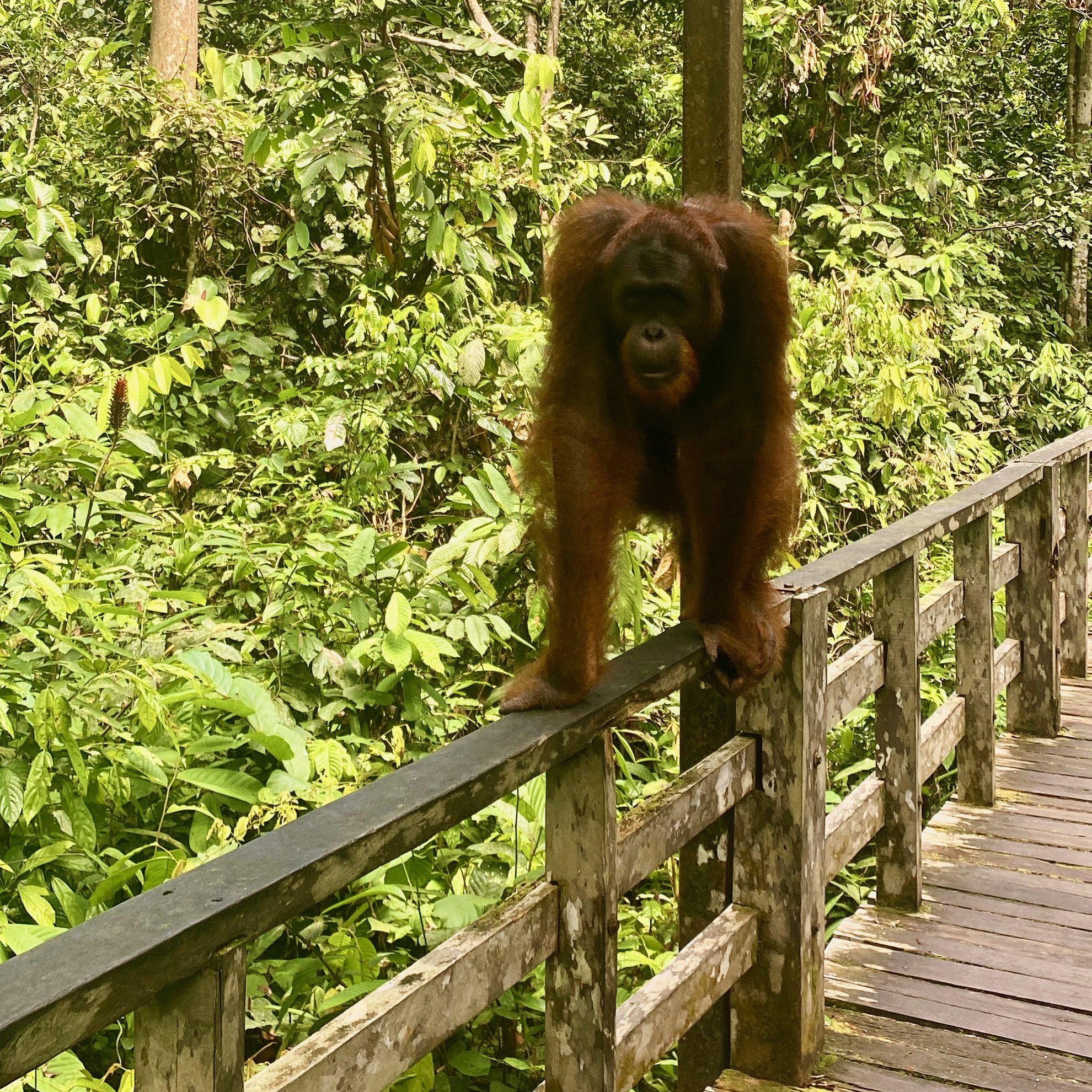
Malaysian visas, currency and budget
Visas to Malaysia are straight forward, and dozens of nationalities are eligible for visa-free entry. This includes EU countries, the UK, the UAE, Canada, the US, Australia, New Zealand, South Africa and Brazil.
The currency in Malaysia is the Ringgit. Malaysia is a little more expensive than other places in South East Asia, but a fair bit cheaper than Singapore!
I’ve written a detailed post about covering all essential information for visiting Malaysia here , which I recommend checking further information.
How to get around Sabah, Borneo
One of the game changing things about travelling South East Asia now, compared to my first visit in 2010, is the introduction of ride hailing apps. The main one in Malaysia is Grab – and my goodness, is it game changing. No standing around on roads trying to hail a local taxi and then haggling over short journeys.
Once we landed at Sandakan airport, we simply hopped in a Grab into the centre of town. We also used Grab in Kota Kinabalu from the airport to the port. It’s just like Uber and the journeys were always so inexpensive. It’s so easy to take Grab that it doesn’t really make sense to try and navigate local buses or use any other method.
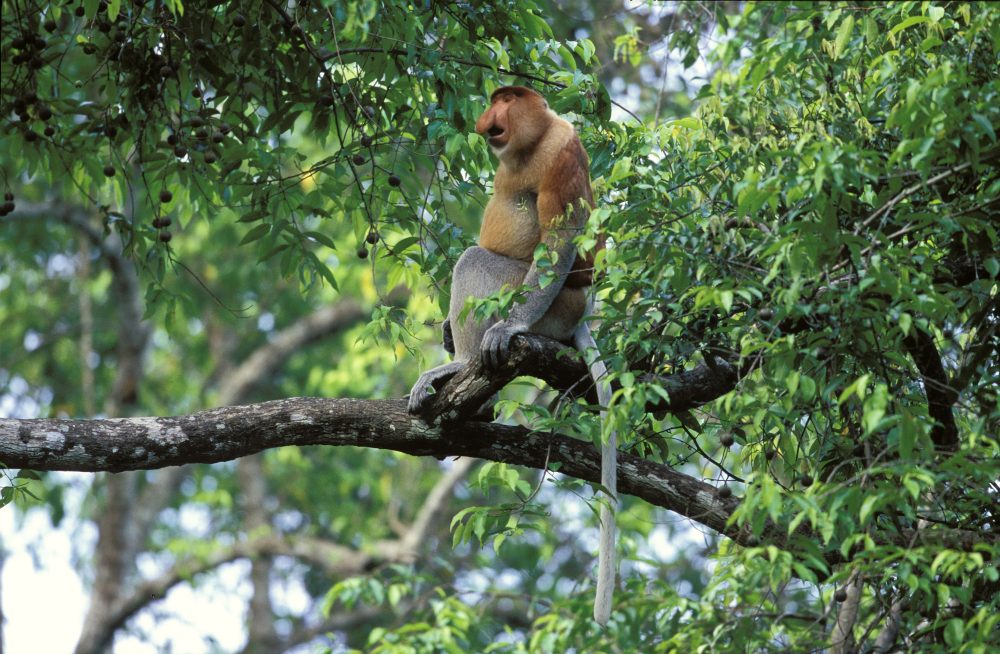
When is the best time to go to Borneo?
April to September is typically the best time to go to Borneo. Unlike the rest of South East Asia, June to August is particularly dry whereas the rest of the region faces frequent daily showers in these months.
However, November through to February is monsoonal in Borneo. When speaking to our guide, he described it as torrential and near pointless trying to visit in this time. He said these aren’t just tropical showers, but nearly all-day rain. It means most of the guides are out of work during these months, waiting for the peak season again. And similarly, this weather can make seeing the orangutans in Borneo difficult.
We went to Borneo in April and the weather was perfect. Hot and humid, with one downpour in 4 days (which was really refreshing, plus we were on a speedboat on the river!). A friend of mine went to Sandakan and the Kinabatangan River in February and said they did experience an awful lot of rain.
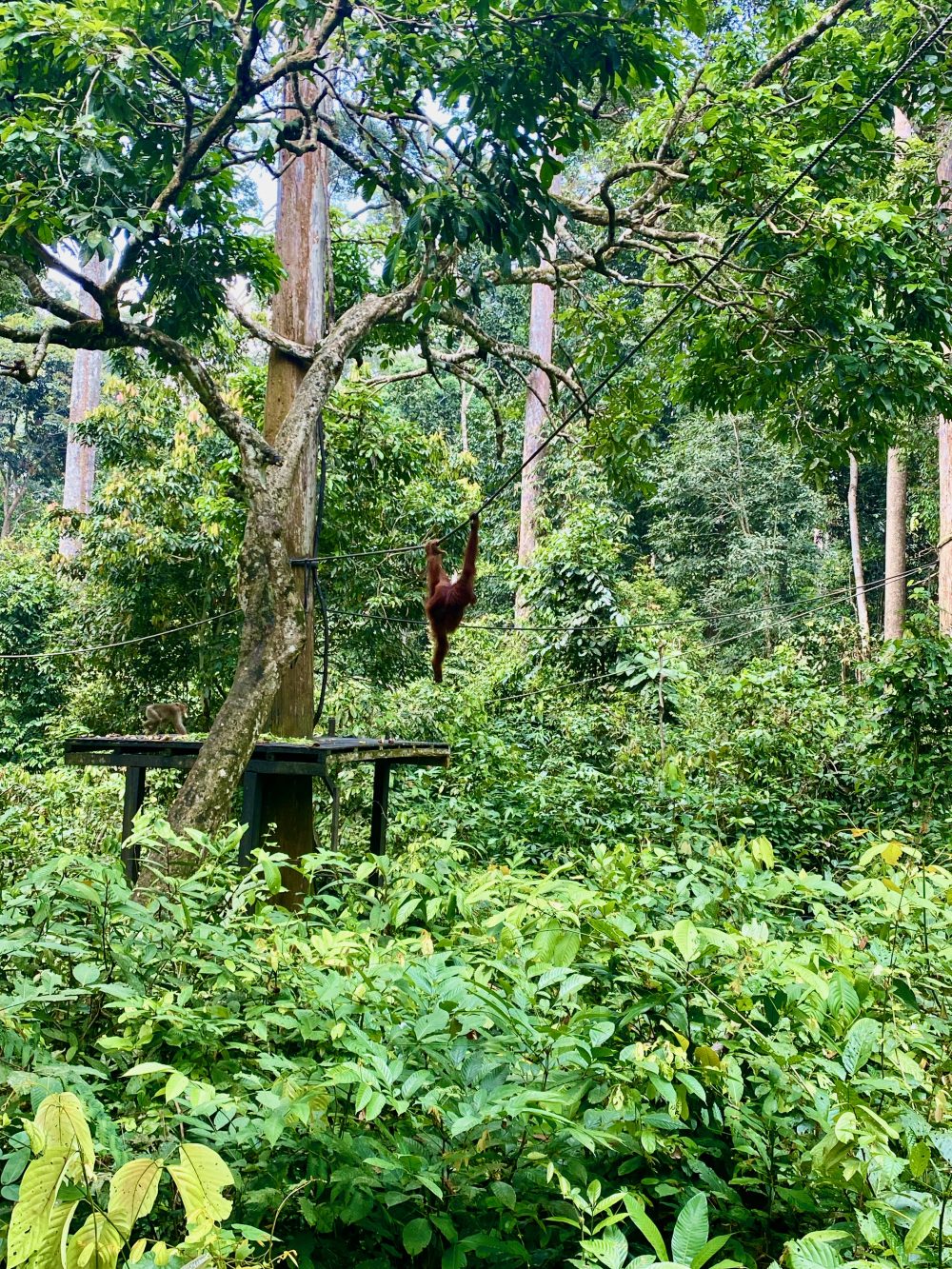
How long do I need in Borneo?
I would say you need a minimum of three days in the rainforest. I do know you can fly in and fly out from Kota Kinabalu into Sandakan in a day as part of tour, but I don’t recommend this. The adventure lies in exploring the rainforest after all!
Some people do visit Sandakan and just go to Sepilok, a small town 30 minutes away. Sepilok is home to several animal sanctuaries and centres. You need two days in Sepilok, ideally. But as you are guaranteed to see orangutans here, I see why you could in theory do just the day visit.
I would strongly recommend joining a tour and heading out along the Kinabatangan River. You need a minimum of two nights to do this. But we did a tour that took in Sepilok at the start and finish, and meant we saw all the key highlights in three full days. Amazingly, it was brilliant and we were so satisfied with our animal sightings along the river in this timeframe – and we also had plenty of downtime to relax. But, if we were to go back, I think I’d add in another lodge even deeper in the Kinabatangan River. After all, you have travelled a long way.
So, my final answer is – a minimum of five days in total – two days in Sepilok, two to three days deeper in the rainforest. And if you’re an animal fan, I’d add another 2 or 3 days onto that.
You are likely to need an additional night either side of any rainforest adventure because of flight timings and early starts.
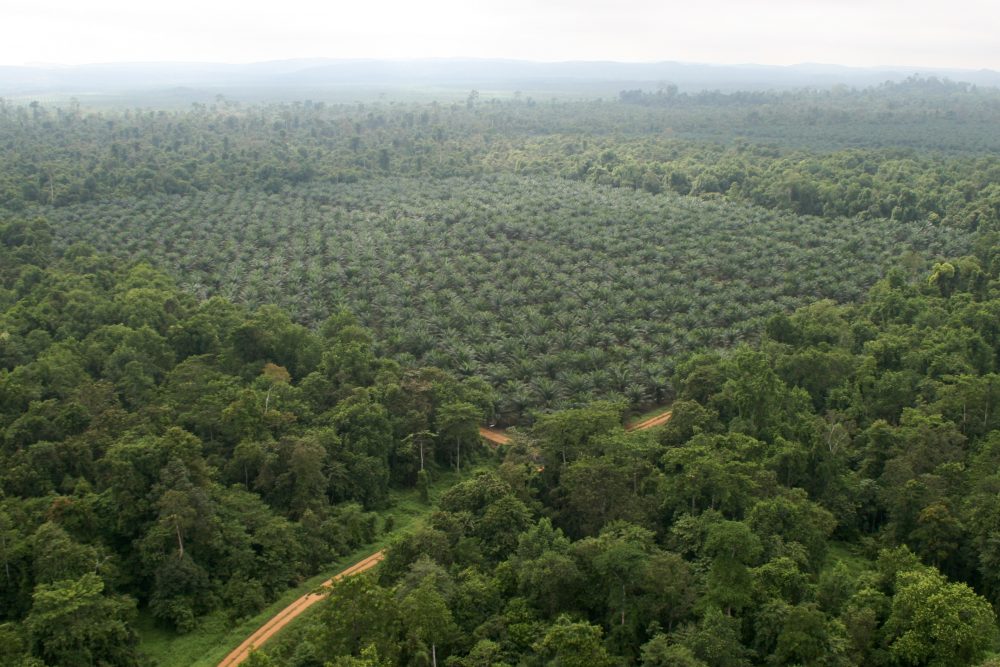
Our time in Sabah looked like this:
- Day 1: Landed in Sandakan 6pm in the evening, checked into local hotel
- Day 2: Picked up at 8am for day 1 of the tour (morning and lunch in Sepilok, speedboat along the Kinabatangan River to our lodge to arrive by 3pm, free time, evening safari and first night in the rainforest)
- Day 3: Full day in the rainforest at our lodge (morning river safari, free time, evening river safari)
- Day 4: Morning at the lodge before departure back to Sandakan. Back to Sepilok to visit the Rainforest Discovery Centre before checking into local hotel in Sandakan
- Day 5: Early departure from Sandakan airport to Kota Kinabalu, arrive 10am.
We met a couple in Sepilok’s Rainforest Discovery Centre who had visited 10 days in a row as they were passionate birders and absolutely loved the viewing areas!

What to bring on a trip to Borneo?
Bug spray, bug spray, bug spray! The mosquitos are in the millions, and the biting felt incessant, especially from about 5pm.
I would also say to bring some long, lightweight trousers and proper closed toe shoes.
Even in the dry season, there can be sudden downpours so when you head out in wildlife river cruises, the guides advise to take a hat, suntan lotion and a raincoat!
Where to visit in Sabah to see the orangutans?
So, we’ve got the logistics down, but where to see orangutans in Sabah?
As just mentioned, you are guaranteed to see orangutans in Sepilok. This small town is just 26km from Sandakan and is home to the Sepilok Orangutan Rehabilitation Centre. You will 100% see orangutans here. Nearby is the Rainforest Discovery Centre, another place where you have a high chance of seeing orangutans.
A trip along the Kinabatangan River – the second longest river in Malaysia – is another key place to spot orangutans where over 1,100 live. Yet it is significantly harder to spot them as they are rather elusive and the rainforest here is very dense.
We saw two orangutans at our lodge, far along the Kinabatangan River. However, we saw far more at the Sepilok Orangutan Rehabiliation Centre, and therefore, for close and intimate viewings, you have to go there. Plus, they are strictly arboreal (living in the trees) so you do have to be surrounded by the thick rainforest to have a chance of seeing orangutans.

Other areas in Sabah, Borneo to spot orangutans in the wild include Danum Valley, the Tabin Wildlife Reserve and Deramakot Forest Reserve. You can only visit these locations on longer trips to Sabah due to the added travel time to get there. If had had more time in Borneo, Danum Valley would have been my pick to add another 2 or 3 nights.
What other wildlife can you see in Borneo?
So of course, most people come to Borneo with the goal of seeing orangutans. But there’s actually a Borneo Big Five!
The wildlife animals in the Big Five include: the Pygmy Elephant, the Proboscis Monkey, the Rhinoceros Hornbill, the Estuarine Crocodile and of course, the Orangutan.
We were lucky enough to see all of these, except the Rhinoceros Hornbill, during our three days in Borneo. But other guests were even luckier and did see the Rhinoceros Hornbill!

On one of our afternoon river cruises along the Kinabatangan River, I saw a flash of black and then a swooping primate swinging between the trees. Our guide was seriously excited. He told us it was the Bornean Gibbon – a rare sighting and something he hadn’t seen in over 4 months!
I also loved the Proboscis Monkey. These are endemic to Borneo, which means they can’t be found anywhere else. They also really stand out due to their very large noses. In fact, their noses hang down their faces and are distinctive. It’s only the male proboscis monkeys that have this nose. And apparently, female proboscis monkeys prefer to mate with male proboscis monkeys with the larger noses…
This was actually the animal we spotted most frequently in the wild whilst cruising along the Kinabatangan River. We also saw dozens of long tailed macaques, many of which were very curious about us and caused the tall trees to swing all over the place.
Other animals to spot include the clouded leopard (extremely rare), the western tarsier, sun bear, the civet and the pangolin.
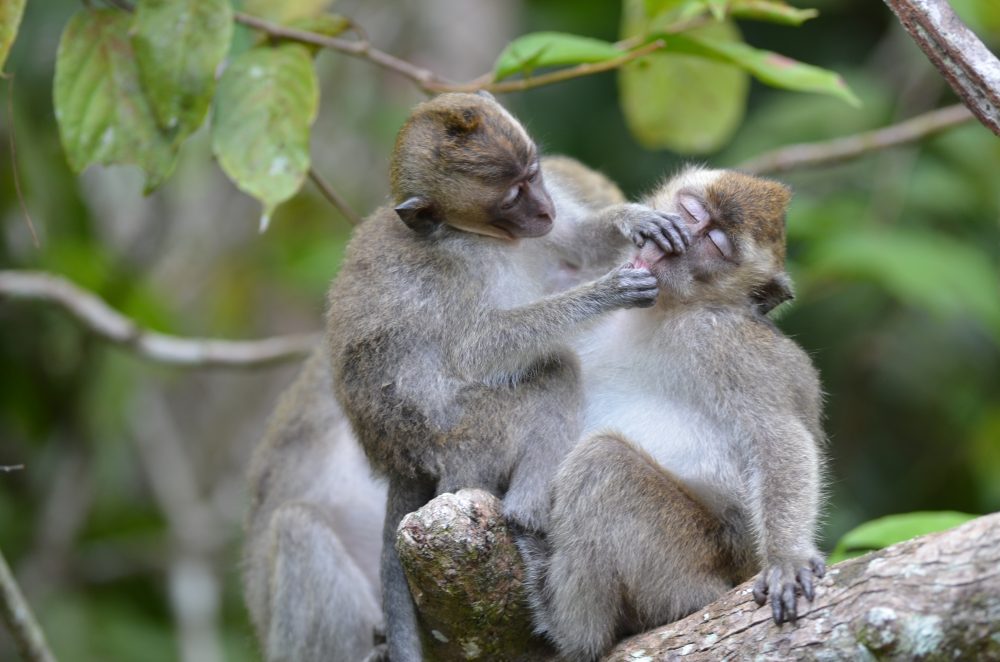
Should I explore Borneo on a tour or independently?
I would say that Sandakan to Sepilok is very easy (even just jump in a Grab). There’s plenty of accommodation options in Sepilok and the area is small and walkable. However, I don’t think you should even attempt to visit the Kinabatangan River independently. Firstly, I don’t know how you’d travel to such a remote location without using the speedboats of one of the lodges. I don’t think there are local boats to catch up the river. Secondly, to try and visit the rainforest independently means risking your safety (wild animals!). It also means not receiving the incredibly interesting and insightful information from your tour guides.
We arranged our whole rainforest adventure with Borneo Eco Tours (sometimes called BET). I couldn’t recommend this experience enough. You can book them for tours in both Sabah and Sarawak. We specifically did this tour here – Kinabatangan Wildlife Safari (by boat) 3D2N (code BB7D for booking). Whilst it wasn’t particularly physically challenging in any way, the tour was so efficiently organised. It really helped us achieve everything we wanted in Borneo.
It isn’t too cheap – MYR 2,820 per person, based on two people sharing. This is approx. £500 per person or USD$614. But it did take care of everything. From transport, accommodation, all meals, river cruises, and entry to the main sights in Sepilok. Plus of course, the excellent guides. That’s about £166 per person per day, which I felt was a fair cost for the experience.
You can book directly on their site here . Here you will be connected with one of their helpful customer service staff via email. They will help ensure you’re booking the best tour for you and advise on all other logistics – an invaluable resource.
Borneo Eco Tours own the most amazing lodge, located along the banks of the Kinabatangan River. It’s called Sukau Rainforest Lodge and is one of National Geographic’s Unique Lodges of the World.

Accommodation options in Sabah, Borneo
Sukau rainforest lodge.
As just mentioned, I personally stayed at Sukau Rainforest Lodge, which was about a 2.5hour speedboat from Sandakan, nestled along the Kinabatangan River. It was absolutely perfect, and the best luxury stay in this part of Borneo.
Your stay here is on a full board basis, so excellent buffet breakfast, lunch and dinners are included. Alcoholic drinks are an additional cost. The food was really impressive and hugely varied. We loved the Asian options and enjoyed the chance to try some more unusual dishes.
There are two room categories. The more affordable option is the superior room, tucked away behind the main social areas of the lodge. These rooms offer excellent facilities and very comfortable rooms.
The other option is a Borneo Villa, which is what we booked. We found the villa to be very luxurious and completely magical. We loved sitting by our balcony where all kinds of wildlife would swing by. Or even stomp on the roof of the villa! The Borneo Villas are tucked away down wooden boardwalks, meaning they feel really private and are completely surrounded by the rainforest.
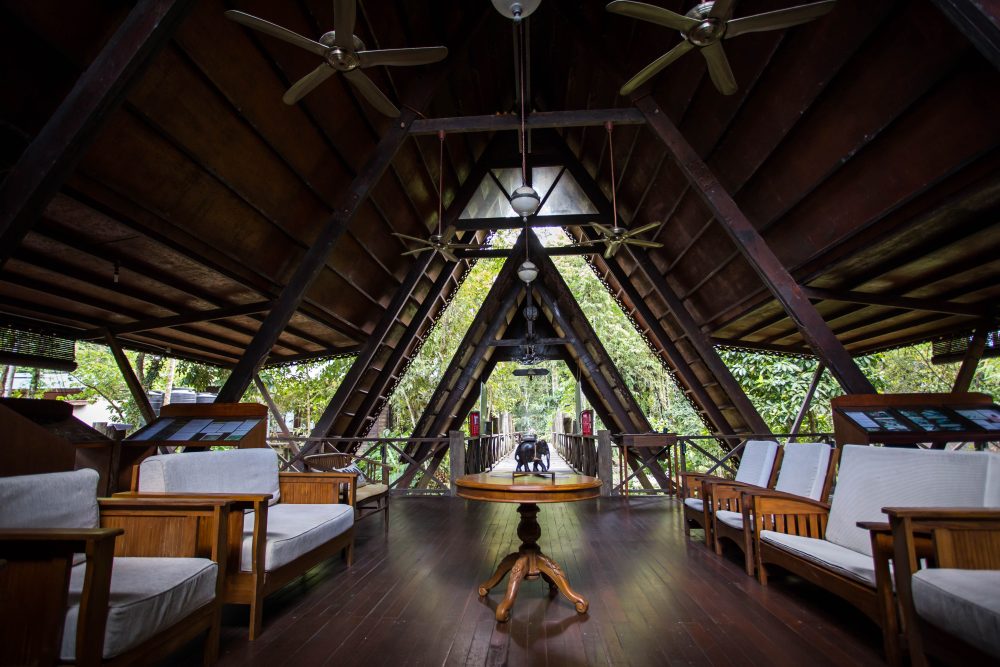
River wildlife safaris are conducted twice a day, with one at sunrise and one departing around 3pm. Each boat has a highly informative guide on board who will endeavour to spot as much wildlife as possible. There is also the option of a night cruise at a small additional charge, which goes out with a flashlight. We saw a lot of crocodiles and snakes during this cruise but no orangutans as they were fast asleep!
Also, there are a couple of delightful outdoor pools here, making for an all in all, wonderful and relaxing stay!
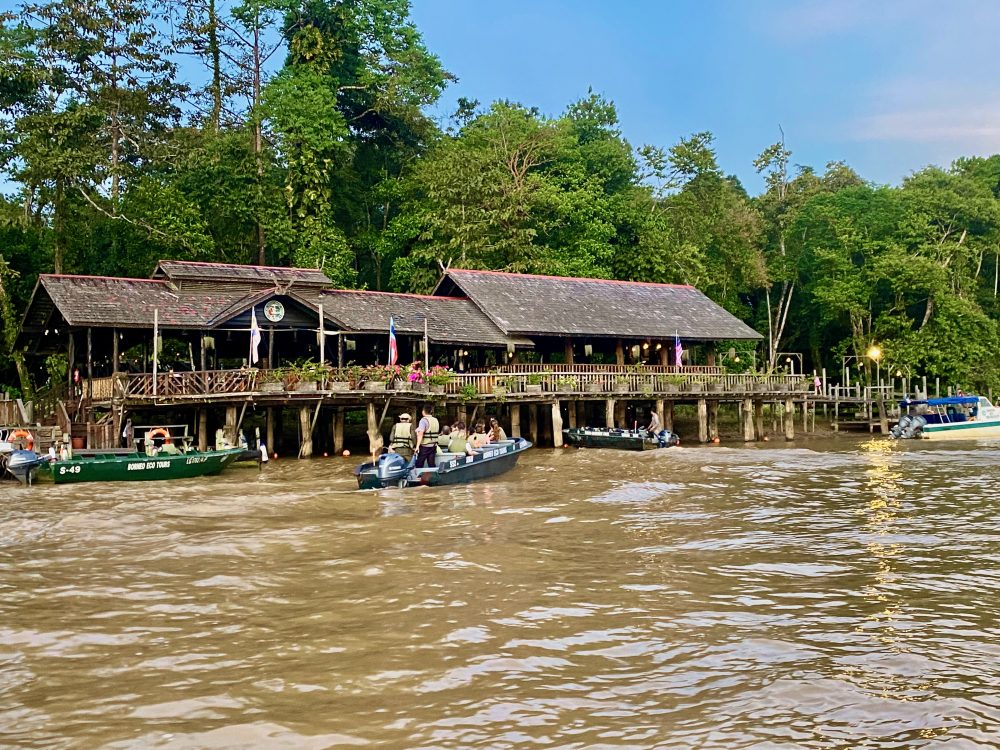
Other places to stay in Sabah, Borneo
Kinabatangan.
Along the Kinabatangan River are a few other lodges, which can be booked online without using a local tour company. I’ve listed a couple of suggestions below:
- Kinabatangan Wildlife Lodge (£50 per night)
- Borneo Natural Sukau Bilit Resort (£150 per night)
- Bilit Adventure Lodge (£252 per night)
- The Last Frontier Boutique Lodge (£308 for two nights, which is the minimum stay)
- Borneo Nature Lodge (£333 for a two day, 1 night package)
Back in Sandakan, a few suggestions include:
- The Elopura Hotel (£47 per night)
- Sabah Hotel (£48 per night)
- Hotel Sandakan (£16 per night)
We bookended our tour with a first night at the Elopura Hotel and a second night at the Sabah Hotel. The Elopura is located right in the heart of Sandakan Waterfront, so great for 1 or 2 nights if you want to experience a bit of local life. The room was great in Elopura and the hotel was heavily themed around movies, which was quite cool!
Sabah Hotel is located a little out of town, on a hill and a short taxi from restaurants etc. Sabah Hotel has a great pool area and lots of facilities, as well as several onsite restaurants, so I’d recommend staying here if you want a full day of relaxing.
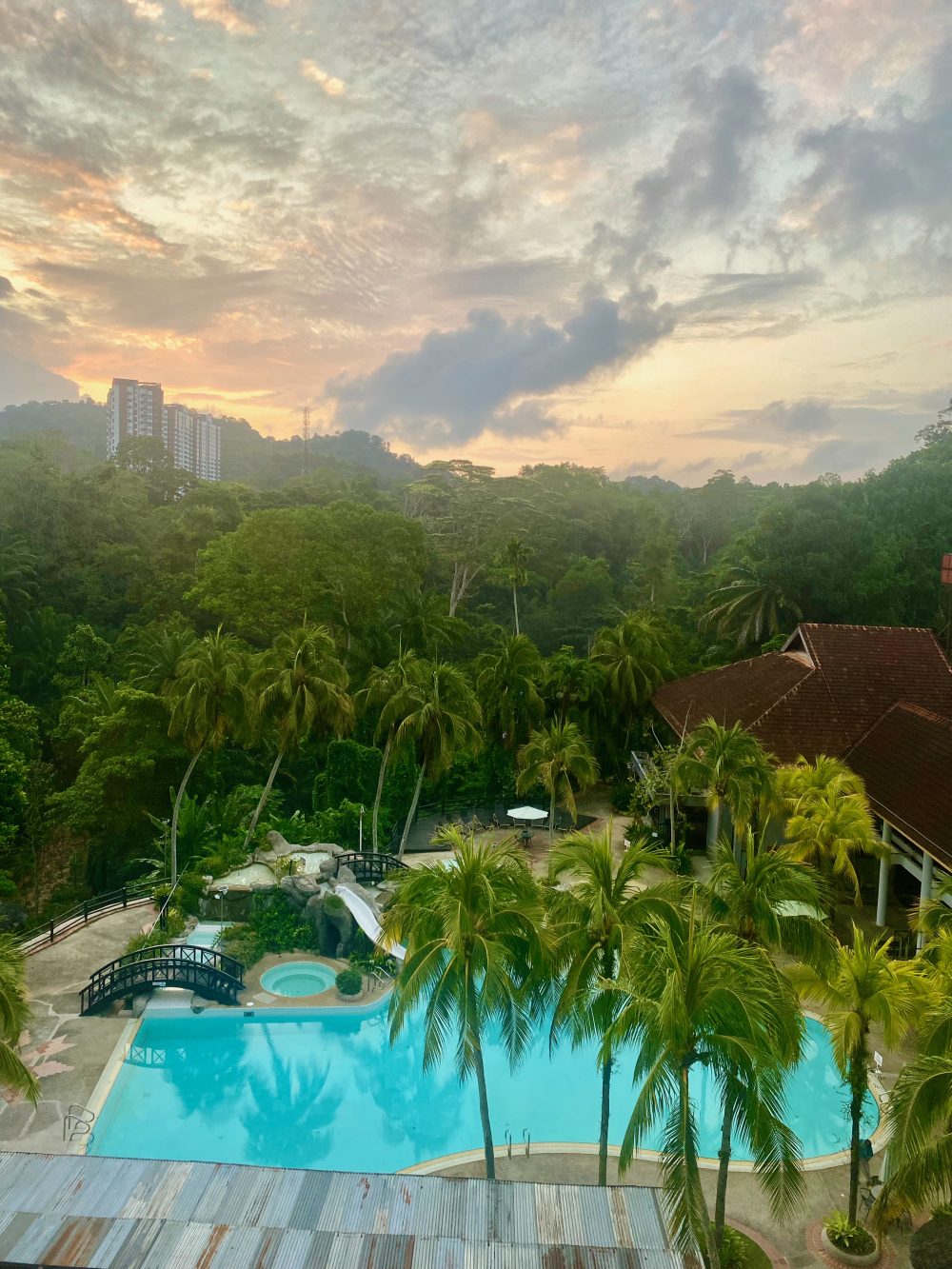
There are a lot of accommodation options in Sepilok, so perfect for exploring the various attractions here. Lots of the lodges and guesthouses are small and family run. A few options include:
- Sepilok Forest Edge Resort (£85 per night)
- Sepilok Jungle Resort (£30 per night)
- Nature Lodge Sepilok (£40 per night)
- Sepilok B&B (£27 per night)
- Paganakan Dii Tropical Retreat (£43 per night)
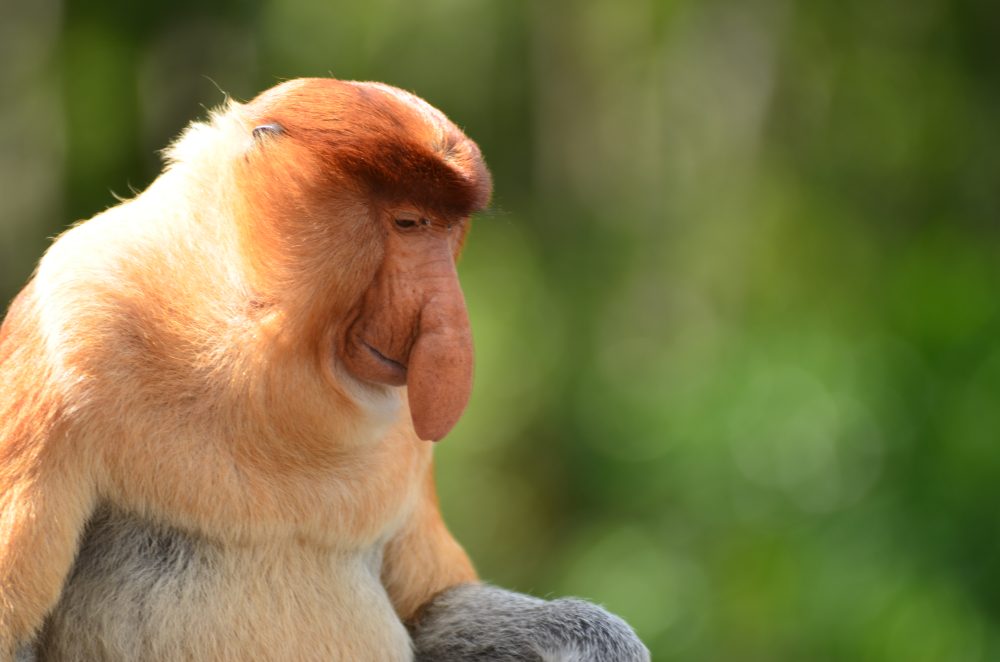
Where to See Orangutans in Borneo: A Guide
So, there’s my complete on where to see orangutans in Borneo. I really hope this blog post has helped in your research and planning for your trip to see the orangutans in the wild. It really is the most magical experience but does take a fair bit of planning to get there and to maximise your time.
As always, let me know if you have any questions.
If you’re planning a longer trip around Malaysia, or South East Asia, then make sure to check out my other posts here:
- Malaysia Travel Guide: The Best Places to Visit in Malaysia (including Borneo)
- Thailand Travel Guide: The Best Places to Visit in Thailand
- Vietnam Travel Guide: The Best Places to Visit in Vietnam
- Singapore Travel Guide: The Best Things to See and Do in Singapore
Disclaimer: This guide has no involvement from the local tourism board or a hotel .
Enjoyed my guide on where to find orangutans in Borneo? Pin it !
You may also enjoy:
The best vegan and plant-based cafes …, staying at the holiday inn mai …, the ultimate gili islands travel guide, philippines travel guide: everything you need …, leave a reply cancel reply.
Your email address will not be published. Required fields are marked *
Let’s connect

How to Visit the Sepilok Orangutan Sanctuary Borneo
It goes without saying that no visit to Borneo is complete without a visit to the famed Sepilok Orangutan Sanctuary Borneo. We have had the luck and privilege to visit the only two places on this planet where you have a chance to encounter and observe Orangutans in their natural habitat.
We visited Sumatra in June 2014, where we trekked for 2 days into the jungle and had several first hand encounters with the Sumatran Orangutan. More recently, we visited Malaysian Borneo in search of our second opportunity to see the great red apes.
Part of being a traveler that loves to observe wildlife is being a responsible and educated traveler.
Our first encounter happened while on our wildlife safari on the Kinabatangan River in Sukau, where we observed an adult Bornean Orangutan hanging high up in a tree.
We were not able to get close, but it was amazing to see this animal living peacefully in it’s natural environment. After leaving the pristine rainforests, we headed to Sandakan where we stopped over for a few days and made a visit to the Sepilok Orangutan Sanctuary Borneo.
Visiting the Sepilok Orangutan Sanctuary Borneo
Table of Contents
Sepilok Orangutan Rehabilitation Center
Having the opportunity to see Bornean Orangutans in their natural habitat is a special experience and one of the only places to do this in Sabah is at the Sepilok Orangutan Sanctuary Borneo.
This center is located outside of Sabah’s second largest city, Sandakan. Animal lovers from all over the World travel to this remote region for the chance to see these endangered primates during two of the centers scheduled feeding times on platforms within the reserve.
Located on a 43sq km equatorial rainforest reserve, the rehabilitation center focuses their efforts on preserving the endangered populations of the Orangutans in this region.
The Orangutans are wild and free to come and go as they please. You will not see cages or enclosures during a visit here and you are permitted to follow marked paths to the various viewing areas at the front part of the reserve.
Understanding the Rehabilitation Center’s Purpose
While you may see some adult Orangutans during a visit to the Sepilok Orangutan Sanctuary Borneo, the main purpose of the center is to rehabilitate young orangutans that have been orphaned due to illegal logging and deforestation and those who have been held illegally and kept as pets. The focus of this center is not tourism and there are some things your should understand about this before you make a visit.
This is not a zoo and sightings of the Orangutans is not guaranteed. While they do have specified feeding times, and it is likely that one or more Orangutans will show up for a brief visit, your visit could still be a gamble.
But this is the best part about the work that they are doing. As travelers and tourists, we need to understand the purpose of this facility and what the chances of not seeing them really means. For that, I will explain further.
The young Orangutans that are taken into this center undergo complete health checks before being entered into the rehabilitation program. Once this process is completed, the long road to rehabilitation is started which can take up to seven years for each Orangutan that comes through the program.
Due to being separated from their mothers, they have not learned the necessary and vital skills of survival which requires 24 hour care from the staff at the rehabilitation center, much like that of a human child.
When they have learned enough skills and maintain stable health, they are introduced to their peers and begin learning about social interaction and acquiring physical skills, such as climbing, swinging and foraging.
When their skills have reached an acceptable level, they have free reign in the reserve, yet they still occasionally rely on the feeding schedules they are used to and return to the center for meals.
~ Juvenile Viewing Area ~
The ultimate goal of the Sepilok Orangutan Rehabilitation Center is to successfully save and re-integrate the young Orangutans back into the wild so they may continue to help grow the endangered populations of Borneo.
So, why it is important to know all of this?
If you are someone that happens to pay a visit to the rehabilitation center during your travels and you do not see any Orangutans, you are witnessing the huge successes of the program at work.
This means the program is working and the Orangutans have been successfully re-integrated to the wild and no longer rely on the people or the centers schedule to survive on their own.
While it may be disappointing, it is actually a really beautiful thing and something that we kept in mind during our visit, despite the fact that we saw several young Orangutans during both feeding times.
After speaking to the Liason officer during feeding times, it was nice to have a background on what Orangutans we were seeing, how long ago they were released and how often they actually come in for the scheduled feedings.
After witnessing both feeding times, we were delighted to learn that we only saw one single Orangutan twice over the two scheduled times.
What You Can Do to Help
The Sepilok Orangutan Sanctuary Borneo is currently run by the Sabah Wildlife Department and does receives some funds from them but a large portion of funding comes from the entrance fees charged to the tourists who are allowed to visit the center and witness the feeding times.
Funds are limited and in past years the center has been unable to replace much of its outdated or overused equipment and staffing levels are often at a minimum.
The Orangutan Appeal UK , currently the only approved NGO (Non-Government Organization) approved to provide assistance to the rehabilitation center, has some great information on establishing fundraisers to help the cause and has ongoing projects that accept donations if you are looking to help.
Another popular way to help out and be interactive is to adopt a baby Orangutan . This route is more interactive, you can choose which baby Orangutan you wish to adopt based on their profiles.
Much like human babies, they all have different personalities and behaviors, so you can choose the one that you relate to best. With an adoption, you receive personal correspondence, updates on your Orangutan and many other bonuses.
It’s a great way to donate to the cause and follow the progress on these little guys.
Planning a Visit of Your Own?
You certainly shouldn’t miss a visit to Sepilok Orangutan Sanctuary Borneo if you are planning a trp to Borneo. Being able to catch a glimpse of these humble red apes is a special experience and by visiting the center, you are contributing to sustaining their species for future generations. Below is all the information you need to plan your own visit:
Location: Sepilok Orangutan Rehabilitation Center sits on the edge of the Kabili forest reserve, located 25km from the city of Sandakan where most people stay. Tours, buses and taxis make getting to Sepilok really easy.
Getting There: We took the local bus and made the visit on our own. There is a local bus that leaves from downtown Sandakan to Sepilok daily, this will drop you off right at the Sepilok Orangutan Rehabilitation Center. Be sure to catch Bus 14, which leaves hourly from the minibus station from 9:00 to 14:00. The last bus leaves the park at 16:oo, leaving you time to view both feedings if you catch the first and last bus. The bus costs 4MYR ($1.25USD) one way, per person.
Public Center Hours: The Sepilok Orangutan Rehabilitation Center is open from 9am-4pm daily and tickets are valid for the whole day. This means you can see the morning feeding and then have time before the next feeding to check out the Bornean Sun Bear Conservation Center or the Rainforest Discovery Center that are both within walking distance.
Sepilok Orangutan Rehabilitation Center Admission Cost:
- Non-Malaysian Adult: 30MYR ($9.50USD)
- Non-Malaysian Child: 15MYR ($4.75USD)
- Camera Fee: 10MYR ($3.00USD)
- Ticket Office Hours: 9:00AM-12:00PM & 2:00-3:30PM
Feeding Times: These are at 10am and 3pm, make sure you get there 15mins before hand so you have time to walk along the boardwalk to feeding. You also want to be early if you are a photographer or videographer to ensure you get a good spot, with good light and no people in your frame.
Photography & Video Tips: The feeding platform gives you a wonderful opportunity to film these endangered primates. However, you won’t be the only one there and if you are looking for an intimate experience with the red apes, think again. Here are some tips to help you capture better photos during your visit:
- Be early- more than the recommended 15 minutes, you want to beat the crowds and get setup before they start arriving. There is plenty of room for everyone, but for clear shots, you need to be strategically placed.
- Pack your lens hood and pay attention to the lighting conditions. Both the morning and afternoon feedings will give you different light conditions, both of which can be a challenge. Use the light to your advantage, but be sure you have setup in a place that will minimize glare and washout.
- Bring a telephoto lens . They will be close, but not that close. You will need a minimum of 200m zoom to get decent photos.
- Bring a tripod. Using a telephoto lens makes things more sensitive, so you want to be as still as possible and a tripod will allow you to capture clear photos when zoomed in further.
- Shoot in Shutter Priority mode (TV) to start off, this way you will capture the movement when they climb down from the trees to the platform.
More Orangutan Sanctuary Borneo Tips
Being located in the rainforest, a visit to the center will not be without insects. Pack a strong insect repellent to avoid being bitten. Also, pack a poncho or rain jacket , the weather can often be unpredictable and there is no shelter once you leave the office.
DO NOT BRING AN UMBRELLA , the colors can scare the animals, block the views of others and act as a lightning rod if a storm crops up.
If you happen to come across an Orangutan while in the reserve, please do not try to touch it. Human disease and virus can be transmitted to them very easily and what is a common cold to you may cause death if contracted by an Orangutan.
Additionally, they are very strong, have sharp teeth and could cause you bodily harm if provoked. Always keep a safe distance if you encounter an Orangutan.
If you only have time for one feeding, we suggest the afternoon feeding. There will be less people and no tour groups at this time. The whole experience will be more peaceful and enjoyable if you have to choose between the two times.
~ Afternoon feeding crowd during our visit, half the size of morning time ~
More importantly, enjoy your time spent at the Sepilok Orangutan Rehabilitation Center, it is one of only two places in the World to see these primates in their natural habitat. Give yourself time to watch the DVD and learn about the programs at the center and the efforts that are put forth in conserving this beautiful species during your visit.
More on Borneo:
- RTW Travel Recap: 2 Weeks in Sabah Borneo
- Wildlife Safari in Sukau Borneo
- Birding in Borneo on the Kinabatangan River
- Ultimate Sipadan Diving Guide (Read before you go!)
- Ultimate Travel Photography Gear List
- Photography Gear Every Adventure Traveler Should Carry
- RTW Travel Recap: 3 Weeks in Malaysia
Did you like this story? Share it!
Travel planning resources, about lina stock.
Lina is an award-winning photographer and writer that has been exploring the world since 2001. She has traveled to 100 countries on all 7 continents. Member: SATW, NATJA, ATTA, ITWA
20 thoughts on “How to Visit the Sepilok Orangutan Sanctuary Borneo”
Thanks for sharing. This is one destination in my bucket list requested by my daughter Charlotte :-)!
Hey Lina great article! Thank you for being so informative about the goals of the rehabilitation center. They are truly doing good work there. We actually just returned from a trip to Borneo and had the chance to visit the center too! It is an amazing place to see and it’s fun to see the little ones learning to play and wrestle. They have done a great job giving the orangutans free roam and making the people the ones inside the zoo. We had one of these young guys come visit us when we were looking at the sun bears across the street. The orangutans really do get to wander wherever they want!
Hi Adam, Thanks for stopping by. We really enjoyed our time at Sepilok, some really great photography opps too! I think it is a great program doing great things to keep that species from going extinct.
Hi there, thanks for your great post.
Does the 9am bus from Sandakan arrive early enough to be there 15 minutes early (or more), as you recommend?
If that is the first bus, then yes, you will get there just before the feeding. If you make your way straight out there, you should have enough time to get a good spot before the crowds come.
Great post. I would love to go here!
A wonderful post! So exciting that you saw an orangutan in the wild! I visited the rehab centre too a couple of years ago and was so moved by the great work that was being done out there (there’s a blog post on my site about it if you fancy reading) – I was so amazed by how incredibly intelligent the orangutans are too. Could have watched them for hours 🙂
Thanks for stopping by. It is always a pleasure to see an Orangutan, especially since they are endangered. We purposely made a visit to both Sumatra and Borneo (the only two places they exist in the Wild now) just to see them in their natural habitats. They are very special and like you say, highly intelligent animals. Glad you enjoyed the post!
Hi, I was lucky enough to work as a volunteer at Sepilok 10 years ago and have been back twice since to see some of my former charges. It really is the most amazing place doing amazing work to rehabilitate the orphaned OrangUtans. Your article has reminded again that I must go back to see the great works being done there. I adopt an OrangUtans every year too!
That’s really special that you volunteered at Sepilok. It is a great program they have there.
Thank you Lina nice article
You’re welcome Susan, was a great experience for us.
I visited Sepilok with my late Husband in. 2011, he adopted Ceria for me while we were there. We were both moved by the dedication and care given to these gentle animals and decided that once back home we would support the work of the Orangutan Apppeal UK. however, my Husband collapsed and died two days later while we were in Poring Hot Springs. I was devastated, but once home I remembered our pledge and have continued to support OAUK and have adopted, Chikita and Beryl since. This is in Syd’s memory as well as for me and the Orangutan, in the hope that their species will be preserved for future mankind.
Janet, firstly I’m sorry for your loss. Secondly, that is a great story and I am so glad you were able to share that passion with your husband. I agree, we need to be better educated about some of these species that may be gone soon. We have the power to prevent it.
What a wonderful and highly informative article Lina, I really enjoyed reading it. Thank you very much for posting the links to our website; we really appreciate the support (:(])
You’re welcome, thank you for your efforts!
Thanks for the interesting article. I visited Sepilok about 20 years ago and it was one of my favorite animal encounters. The work they do at the preserve is outstanding.
Glad you enjoyed the article. I am sure it has come a long ways in 20 years. While it’s not quite the same as encountering them in the rainforest, the work that they do is great for the species and a good opportunity to educate the general public about their plight. Thanks for stopping by!
Breath-taking stuff Lina! Your recount of seeing one of these chaps in the wild is just plain awesome. I for one love apes – sounds strange right? lol – and would be floored by visiting both the rehab center and if I could spot one of these orange/burnt siena guys in the wild.
Thanks for the inspired share and keep up the great work guys!
Hi Ryan, thanks for stopping in and reading about Sepilok. We enjoy seeing the apes too, guess we’re both strange? 🙂 Visiting the rehab center was a nice experience and a good way to learn more about the Orangutans. We learned a lot on our visit to Sumatra and did a fair amount of jungle trekking there to observe them in the Wild, which was unreal and such a cool experience. We did see Orangutans in the wild in the Kinabatangan River region, which was nice also. I hope you get a chance to see them in the wild some day!
Leave a Comment Cancel reply

Where to see orangutans in Borneo
Book your individual trip , stress-free with local travel experts
- roughguides.com
- where-to-see-borneo-orangutan
Plan your tailor-made trip with a local expert
Book securely with money-back guarantee
Travel stress-free with local assistance and 24/7 support
written by Joanne Owen
updated 26.05.2023
Love nature and wildlife? Borneo deserves to be shifted to the top of your travel wish-list. Located in Southeast Asia’s Malay Archipelago, the island is blessed with a bounty of unique plants, birds and animals, among them orangutans. Given that these endangered great apes are only found in two parts of the world, wildlife watchers will want to optimise opportunities to encounter them. With that in mind, read on to find out where to see orangutans in Borneo.
- The ideal destination for orangutan sightings
Best places to see orangutans in Borneo
- #1 Sepilok Orangutan Rehabilitation Centre
#2 Tanjung Puting National Park
#3 borneo orangutan survival foundation (bosf).
- Other destinations for orangutan encounters
Practical tips for seeing orangutans in Borneo
The ideal destination for orangutan sightings .
Politically divided between the Malaysian states of Sabah and Sarawak , Indonesia , and Brunei, Borneo is the third largest island in the world.
It’s also home to one of the world’s oldest rainforests, which is the ideal habitat for orangutans.
Asia’s only great apes, and the world’s largest arboreal mammal, orangutans spend pretty much their entire lives in the trees. This is reflected in their name — in Malay, orangutan means "man of the forest".
Overview of orangutans in Borneo
Orangutans, the island’s most famous forest residents are only found in two areas of the world — Borneo and the Indonesian island of Sumatra .
Orangutans live largely solitary lives in Borneo’s lowland forests. They make nests in trees to sleep and rest up in, between feasting on wild fruits.
Around a century ago, it’s thought there were over 230,000 orangutans in the world. These days, estimates put Bornean orangutan numbers around 104,700, making it an endangered species. The number of Sumatran orangutans is around 7500, which means they're critically endangered.
In more positive news after reading these sobering numbers, a number of foundations in Borneo are working to protect orangutans.

Orangutans in Borneo © Shutterstock
What other wildlife can I see in Borneo?
Borneo is home to 222 mammals (44 of which are endemic), 420 species of bird (37 endemics), 100 amphibians and 394 species of fish (19 endemics).
In addition to orangutans, Borneo's other primates include proboscis monkeys, macaques and gibbons.
Borneo is famed for its endangered pygmy elephants, and the elusive, endangered Sunda clouded leopard. Found in the mountainous interior, experts put their numbers between 5000 and 11,000.
Then there’s the Bornean sun bear. The world’s smallest, most arboreal bear, and the second rarest bear species (after the giant panda), sun bears have been given an “vulnerable” status.
Borneo’s birdlife is impressive, too. Notable species include hornbills, brahminy kites, crested serpent eagles, egrets, exquisite blue-banded and stork-billed kingfishers, and oriental darters.
Many of these wildlife wonders can be seen in the vicinity of the three best places to see orangutans in Borneo. Namely, Sepilok Orangutan Rehabilitation Centre, Tanjung Puting National Park, and Borneo Orangutan Survival Foundation.

Orangutan in Borneo ©Shutterstock
Borneo is one of the best places to see orangutans in the wild, bit it's also the world's third-largest island. So, where should you go? Three main locations in Borneo offer opportunities to see these amazing animals.
- Sepilok Orangutan Rehabilitation Centre
- Tanjung Puting National Park
- Borneo Orangutan Survival Foundation (BOSF)
#1 Sepilok Orangutan Rehabilitation Centre
Sepilok in the Malaysian state of Sabah is a rural, partly forested area that clings to some of Malaysia’s most celebrated wildlife, among them rhinoceros hornbills and, famously, orangutans.
A 3km turning south off the main road — 22km west up the main road from Sandakan — gives access to the Sepilok Orangutan Rehabilitation Centre.
Located at the end of the Sepilok road, the centre is open daily from 9am–noon and 2–4pm, with feeding times at 10am and 3pm.
Occupying a 43-square-kilometre patch of lowland rainforest, this is one of just a few such sanctuaries. Most of the orangutans here are victims of forest clearance. Many have been orphaned, injured or traumatized in the process.
While other orangutan residents have been illegally kept as pets, resulting in stunted survival instincts, the centre trains them to fend for themselves. This has led to many successful reintroductions to the wild.
The centre offers visitors a few different opportunities to observe orangutans. Firstly, a glass-fronted viewing gallery allows you to see them hone their climbing skills on a rope.
You can also walk trails through the trees, where guides will point out their nests.
Lastly, you can see them at a feeding station, where they’re offered only bananas to ensure they keep foraging. Don’t be alarmed if you see a poor turnout at the station – this can point to the health of the forest and its food sources.
Travel tip : our customisable Dazzling Kuching trip includes Sepilok Orangutan Rehabilitation Centre.
Other attractions near Sepilok Orangutan Rehabilitation Centre
The same turning off the main road also gives access to the Bornean Sun Bear Conservation Centre, and the Rainforest Discovery Centre.
Bornean Sun Bear Conservation Centre
Like orangutans, sun bears are vulnerable – either because their adorable, teddy-like appearance makes them attractive as pets, or because traditional medicine calls for their body parts.
Given that rescued bears need to relearn life skills, the Bornean Sun Bear Conservation Centre plays a vital role in protecting the species.
Opposite the Orangutan Rehabilitation Centre, the Bornean Sun Bear Conservation Centre is open daily from 9am–3.30pm and houses around forty bears in woodland enclosures. A small number of these can be viewed by the public.
Spotting scopes on the elevated boardwalks capture great close-up footage of the bears — ask staff to hold your camera against the eyepiece.

Sun bear © Shutterstock
Rainforest Discovery Centre
Located 2km down the Sepilok road and then 700m west along Jalan Fabia, the Rainforest Discovery Centre is open daily 8am–5pm.
At first sight, while the Rainforest Discovery Centre is a somewhat disappointingly landscaped version of the jungle, with an immaculate lake in the middle, its canopy walkway is impressive.
Here 347m of aerial bridges offer opportunities to see brightly coloured trogons and other birds.
If you sign up for the guided night walk (Mon–Fri only), you might just see flying squirrels, slow lorises and (more rarely) tarsiers.
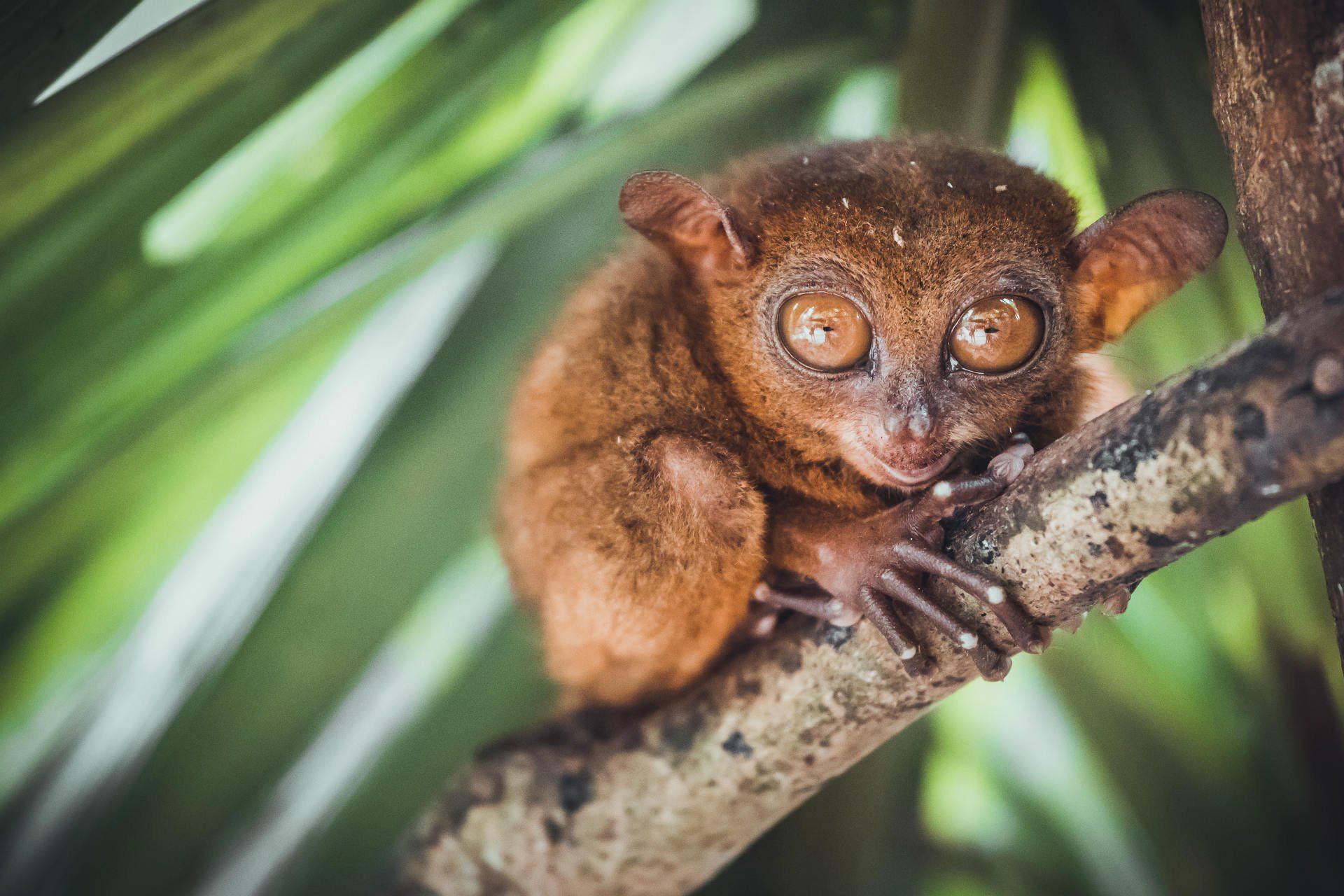
Get lucky, and you might see a tarsier in the Rainforest Discovery Centre, Borneo © Shutterstock
Located in Kalimantan , Indonesia’s name for its two-thirds share of Borneo, Tanjung Puting National Park’s orangutans are the region’s biggest tourist draw.
Your starting point is Pangkalanbun, which is accessible by air. Scheduled arrivals and departures ply routes to and from Pontianak, Ketapang, Banjarmasin, Jakarta, Semarang and Surabaya.
Once in Pangkalanbun, you need to obtain an entry permit at the park office. From there, hire a taxi for the 20-minute drive to Kumai. This riverside village serves as the entry point to the park, a UNESCO Biosphere Reserve.
At the harbour, either hire a klotok (local motorised boat) or a speedboat to go upriver.
A highlight of visiting Tanjung Putting National Park is the orangutan feeding sessions at one of three park outposts.
The first, Tanjung Harapan – directly opposite the Sekonyer River Ecolodge – cares for orphaned infants and new arrivals and has a visitor information centre.
Be aware that the most famous of the three, Camp Leakey, can be something of a circus during high season (June–August), with visitors who are less conservation-oriented clamouring to walk down jungle paths to see the red apes in action.
Older orangutans, sometimes with their offspring, can be found at Pondok Tanggui. During the feeding sessions at Camp Leakey and Pondok Tanggui, orangutans that hover near the stations are offered bananas and milk to supplement seasonal lack of food in the forest.
Allowing tourists the experience achieves an additional benefit — raising awareness of the plight of orangutans and the shrinking forests.
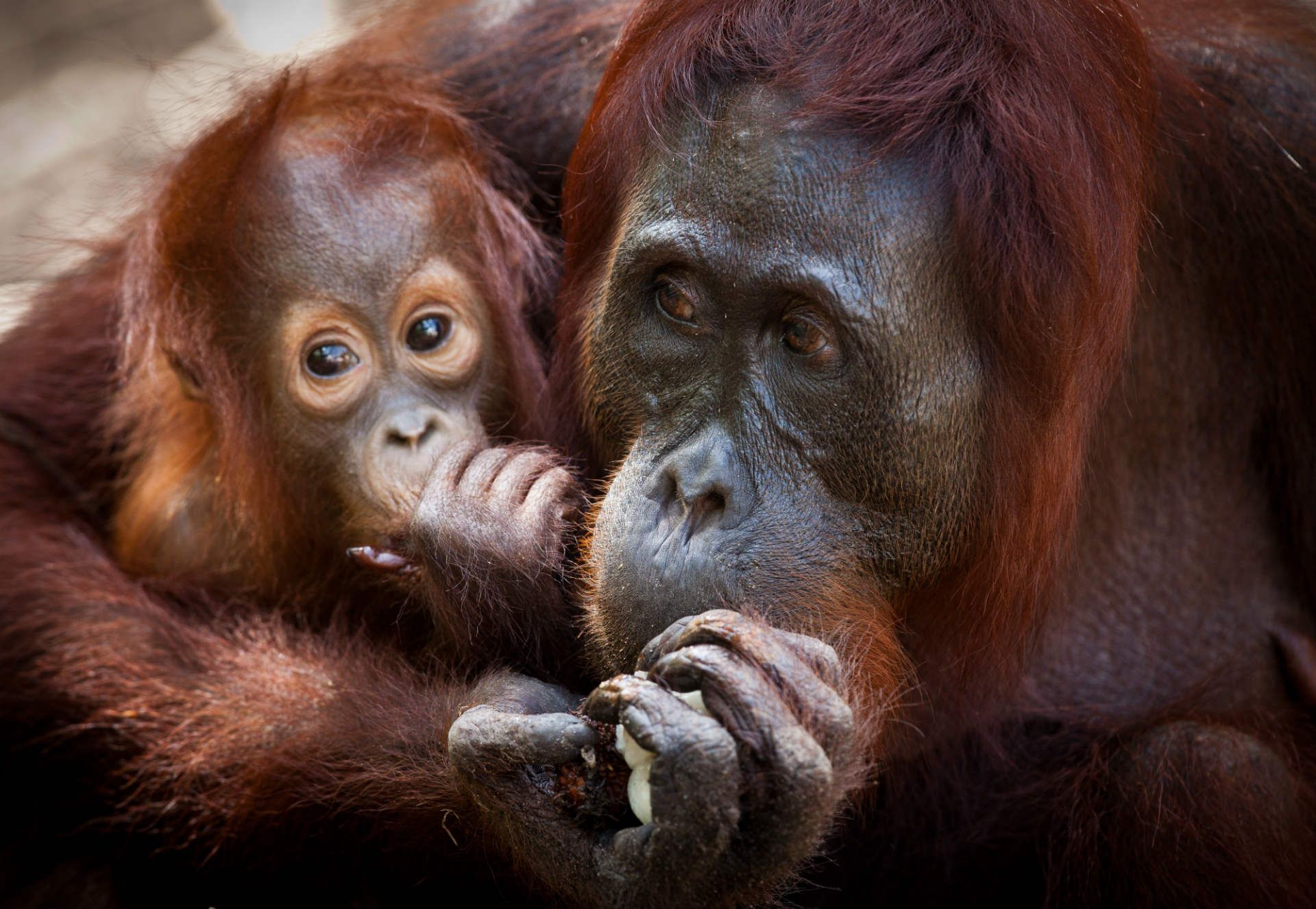
Orangutans in Kalimantan, Borneo © Shutterstock
Other activities in Tanjung Puting National Park
Unsurprisingly, Tanjung Puting National Park is all about the wildlife. Aside from orangutans, It’s home to the proboscis monkey and seven other species of primate, along with clouded leopards, civets, sun bears and several species of deer.
It also boasts over 230 species of bird (including hornbills, and many wetland species), two species of crocodiles, dozens of snakes and frogs, and the endangered Arwana (bony-tongue) fish.
The best viewpoints are from the river. At sunrise, proboscis monkeys begin their day’s foraging, occasionally belly-flopping into the water.
Dawn also sees birds especially active along the river.
Come late afternoon, groups of proboscis monkeys — one male and his female harem per tree — settle in for the night and are easy to spot.
Travel tip: for a sublime jungle river experience, ask your boatman to stop the engine for a while to allow the boat to drift quietly.
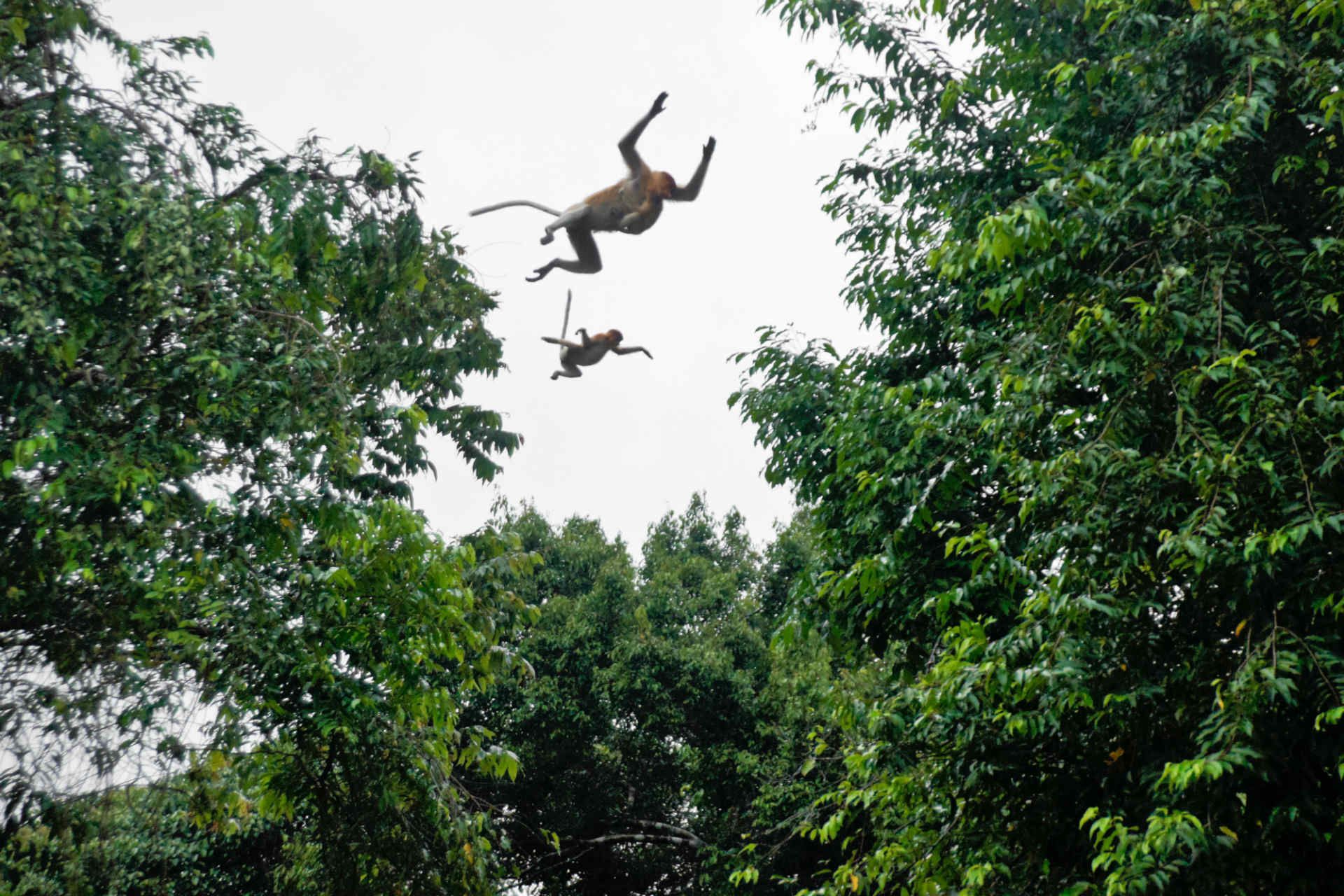
As well as orangutans, keep your eyes peeled for proboscis monkeys in Tanjung Puting National Park © Shutterstock
Related articles from the blog

The Borneo Orangutan Survival Foundation has a rehabilitation centre at Nyaru Menteng, 28km north of Palangkaraya, which can only be visited with a permit acquired in advance.
Home to over 300 orphaned and displaced orangutans, the visitor centre here is open on Saturdays and Sundays, from 9 am-5pm.
While visitors aren’t allowed to come into close contact with the orangutans at this site, you could opt to stay at Samboja Lodge to experience encounters while supporting BOSF’s work — all revenue goes to BOSF conservation projects.
A highlight of staying here is visiting the orangutan sanctuary islands — man-made islands where un-releasable orangutans live in a semi-wild environment.
The lodge also offers opportunities to enjoy thrilling canopy walks and jungle treks, boat trips up the wildlife-rich Black River, and visits to a sun bear sanctuary.
This is travel at its most rewarding, and responsible.

Orangutan © jaiman taip/Shutterstock
Other destinations for orangutan encounters
Danum valley.
About 90min from Lahad Datu by 4WD, the Danum Valley is “perhaps the last area of primary lowland forest in SoutheastAsia which remains truly pristine”.
That glowing description isn’t from a tour operator brochure, but from the South East Asia Rainforest Research Partnership, an international scientific collaboration that’s been based here since the 1980s.
Wildlife here includes bearded pigs, proboscis monkeys, elephants, over 320 species of bird and (you’ve guessed it) orangutans.
Although orangutan sightings are not guaranteed, there are several walking trails and a suspended walkway.
Batang Ai National Park
Located near Lubok Antu, an hour by boat from the dam, the little-visited Batang Ai National Park preserves an important area of rainforest that merges with the Lanjak Entimau Wildlife Sanctuary.
Only accessible with an official guide, who can be hired in Lubok Antu, orangutans are occasionally spotted on various trails.
Note that booking a boat to these trails will set you back a fair whack from the HQ, the park holds no residential or other facilities, and all visitors must be accompanied by a guide.
Matang Wildlife Centre, Kubah National Park
Some 20km west of Kuching, Kubah National Park is a rainforest reserve that’s considered to be one of the world’s richest sites for palm species.
Crisscrossed by trails, waterfalls and streams, with three modest peaks emerging from the lush forest, the park is home to Matang Wildlife Centre.
Here injured, sick or orphaned wild animals such as orangutans, gibbons and hornbills are rehabilitated before being returned to the wild.
Bohorok Orangutan Centre, Gunung Leuser National Park
Northwest from Medan, some three hours by road, a narrow road winds up the Alas River Valley to Gunung Leuser National Park.
Covered in dense jungle, this 8,000-sq km park is a UNESCO Biosphere Site.
In Bukit Lawang , on the eastern edge of the Gunung Leuser reserve, the Bohorok Orangutan Centre welcomes visitors.
Although the centre no longer rehabilitates the red great apes, you’re welcome to take a one-hour hike through the jungle to platforms used for the early-morning and afternoon feeding of wild and semi-wild orangutans.

Orangutans doing their thing in Borneo © Shutterstock
- Do your research and book trips or tours well in advance.
- Travelling independently? Check if you need a permit before visiting national parks.
- Wondering when's the best time to visit Borneo to see orangutans? Anytime between March and October should deliver decent sightings.
- When the rain lets up in April and May, and fruiting season kicks off, you have an increased chance of seeing orangutans at their most active.
- Borneo is hot and humid, so keep well hydrated when you’re out in the jungle.
- It’s advisable to wear long sleeves, trousers, and insect repellent.
- Leeches live in the lowland jungles, so you might want to tuck trousers into socks.

Borneo © Shutterstock
Inspired to see orangutans in Borneo for yourself? Get yourself The Rough Guide to Malaysia, Singapore and Brunei to help plan your trip.
Alternatively, if you’d prefer to forgo the hassle of planning, browse our customisable itineraries to Malaysia and Indonesia . For example, our Nature in Borneo trip includes incredible orangutan experiences.
Header image: orangutan in the jungle of Sabah, Borneo, Malaysia © jaiman taip/Shutterstock

Joanne is a Pembrokeshire-born writer with a passion for the nature, cultures and histories of the Caribbean region, especially Dominica. Also passionate about inspiring a love of adventure in young people, she’s the author of several books for children and young adults, hosts international writing workshops, and has written articles on the Caribbean and inspirational community initiatives for Rough Guides. Follow her @JoanneOwen on Twitter and @joanneowenwrites on Instagram.
- Nature & Wildlife
- Coasts & Islands
- National Parks & Reserves
- Off the Beaten Track
- Where to Stay
- Inspiration
- See & Do
- Travel Tips
- Where to stay
Planning your own trip? Prepare for your trip
Use Rough Guides' trusted partners for great rates
Find even more inspiration here
Ready to travel and discover malaysia, get support from our local experts for stress-free planning & worry-free travels.

Change location
- Call us tomorrow from 10am 01993 838 925 01993 838 120 or
- REQUEST A QUOTE
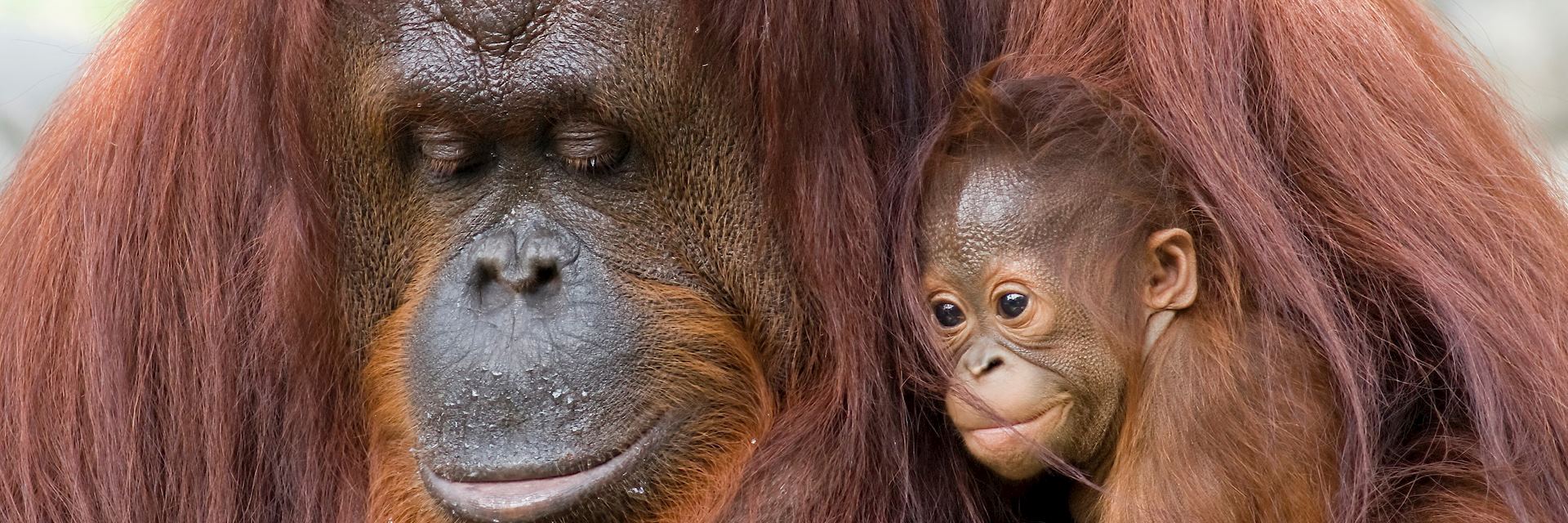
Seeing orangutan in Borneo: Malaysia or Indonesia?
By Borneo specialist Sophie
The first time you see an orangutan in the wild, it’s almost certainly because you’re in Borneo. The smells and sounds of the rainforest are around you — gibbons calling and cicadas singing. It’s quite the setting for seeing these animals play, swing and live among the treetops.
What’s maybe not quite so clear is where in Borneo? The island is part Malaysian, part Indonesian (with little Brunei wedged in the northern corner). And, combining the two into one orangutan-watching bonanza isn’t easy. Unless you have plenty of time, I suggest sticking to one country. Each side of the island has its own merits, and I don’t want to lean you one way or the other. Instead, I’m passing on my highlights for orangutan spotting on both sides of the border.

Borneo for orangutan spotting, in brief
Borneo has the Malaysian states of Sarawak and Sabah in the north, but the majority of the island is Kalimantan , part of Indonesia.
Sabah gives you the opportunity to visit a number of wildlife hotspots relatively close together. These include the Danum Valley , Kinabatangan River, Tabin Wildlife Reserve, Deramakot and the Sepilok Orangutan Rehabilitation Centre.
At Semenggoh in Sarawak you can see orangutans in a sanctuary, but rarely in the wild. It does offer a more rounded trip, though — you could visit an Iban tribe , for instance. With a network of domestic flights across Malaysian Borneo, it’s possible to combine both states in one trip focused on the orangutans of Borneo .
Finally, Tanjung Puting in Kalimantan is more adventurous feeling. The reserve fits into an island-hopping journey across Indonesia, particularly a trip combining Java and Kalimantan .
The only other island where you can see orangutans in the wild is Indonesian Sumatra , which lies to Borneo’s southwest. You could split your time here with Kalimantan on a grand tour of Indonesia .

Malaysian Borneo's orangutan highlights
Sepilok orangutan rehabilitation centre, sabah.
Sepilok is based just outside Sandakan, your most likely entry point into Sabah by air. It provides a good introduction to the orangutans before you head to the jungle. Here you’re almost guaranteed to see rescued youngsters and adults at close quarters.
Your visit starts with a short video that explains the orangutans’ lifestyle and the survival challenges they face. There’s an exhibition worth lingering over, too, but the highlight comes from watching the orangutans swing in through the trees for their daily banana rations. You can stay at the nearby resort to catch the morning feeding.

Kinabatangan River, Sabah
An hour’s boat ride from Sandakan brings you to the Kinabatangan River and the heart of wild orangutan territory. Cruising on a small boat along the river and its tributaries lets you cover more ground and get closer to the animals (possibly including pygmy elephants) without imposing on their habitat, as you would do crunching through the jungle on foot. This is also one of the most leisurely ways to spot orangutans.
The best times for seeing wildlife are early morning and before sunset. From your boat in the mornings, you’ll catch sight of proboscis monkeys, macaques and orangutans waking up and starting their day’s foraging. And, arguably the best birdlife in Southeast Asia flits and darts along the river.
Before sunset, orangutans make their nest for the night high in the treetops. It’s not unusual to see mothers with babies clasped to their bellies.
Night-time boat trips expose you to nocturnal wildlife, aided by a skilled guide and a powerful torch. It’s common to spot crocodiles’ eyes glinting from the water, as well as kingfishers perched along the banks and (no exaggeration) thousands of fireflies. I’ve also seen flying squirrels and owls.
I suggest staying at one of the lodges on the Menanggul Tributary in a simple wooden chalet.

Danum Valley, Sabah
One of the last patches of primary rainforest in Borneo, the Danum Valley shelters a sizeable population of orangutans within close reach of the luxurious Borneo Rainforest Lodge .
From the Kinabatangan River, it’s a five-hour drive to the lodge, which sits on a bend of the Danum River, giving you a ringside seat to watch any orangutans that venture down from the canopy for a drink.
The rooms here are as luxurious as you’d hope to find in the heart of any rainforest. I was also impressed by the knowledge of the resident guides. Your private guide will take you along trails in search of the orangutans, which number a healthy 500, helping you locate them in among the dense foliage. They’ll also point out the forest plants, whose uses extend from medicines to basket weaving.
Danum’s canopy walkway elevates you to life in the treetops, where you might spot bird species like Wallace’s hawk-eagle and the Bornean bristlehead. You can also join a safari vehicle to take you farther into the forest for possible sightings of pygmy elephants, several deer species, bearded pigs, and even clouded leopards and Malayan sun bears.

Tabin Wildlife Reserve
Tabin serves as an alternative to the Danum Valley where you have a great chance to see orangutans released from Sepilok. The lodge here is less impressive and sits on the edge of the reserve, but you’re in the best place for seeing leopard cats. There’s also a higher chance of seeing pygmy elephants, confined to a smaller territory than elsewhere.
Here, like Danum, the guides keep in touch by walkie-talkie, passing along any interesting wildlife sightings they encounter. I found it particularly exhilarating to track wildlife this way, anticipating an orangutan or elephant around the next corner.
Tabin also has several mineral-rich mud volcanoes and salt-water springs that attract a variety of nutrient-seeking hornbills, civets, orangutans and leopard cats. And, it’s worth noting that, unlike Danum, this is secondary rainforest and close to logging areas and palm oil plantations (although the ecology is more diverse as a consequence).
.jpg?q=79&w=800&h=266)
Deramakot Forest Reserve, Sabah
If you’re itching to escape the usual orangutan-seeker’s trail, look to Deramakot Forest Reserve . One of the first FSC-certified forestry reserves, this mixed dipterocarp rainforest has become a blueprint for how to run a sustainable commercial project to halt deforestation across Borneo.
Careful stewardship of the forest has encouraged a long list of wildlife, and it’s the only place you can potentially spot all five of Borneo’s cat species. There’s a healthy population of orangutans, as well as gibbons, sambars, macaques and pygmy elephants. Wildlife sightings can come thick and fast (though we can never guarantee them), unlike sightings of fellow visitors during your stay in this remote enclave.
It’s a four-hour drive from Sandakan, the nearest settlement, to the park headquarters. There’s no hotel, instead you stay in a simple (though air-conditioned and en suite) chalet that’s maintained by the forestry team. To explore, you and your wildlife guide drive deep into the forest in a 4x4, armed with a spotlight if you’re heading out after dark.

Semenggoh Wildlife Rehabilitation Centre, Sarawak
Laid-back Semenggoh offers an intimate wildlife-viewing experience — it’s also less well-known and quieter than Sepilok. That said, spotting any orangutans isn’t guaranteed, particularly when the trees are in fruit, preoccupying the orangutans with nature’s bounty.
The sanctuary’s location outside Sarawak’s capital, Kuching , makes it easy to combine visiting the two. You can also stop off on the way to staying with an Iban tribe , and cruises along the Santubong River could result in seeing Irrawaddy dolphins, proboscis monkeys and saltwater crocodiles.

Indonesian Borneo's orangutan highlights
Tanjung puting national park, kalimantan.
There's no other way to say it — getting to see orangutans in Indonesia is a challenge. Flights, boats and 4x4s are par for the course but, despite the challenges in reaching your end destination, the rewards far outweigh the effort. Orangutan sightings are all but guaranteed, and the park’s excellent rehabilitation reserve is much less frequented than those in Borneo.
In Tanjung Puting National Park , the (approximately) 5,000 orangutans are completely free to roam, supplementing their diet at feeding stations where you can watch.
Camp Leakey Orangutan Rehabilitation Centre gives you the opportunity to see at close hand the orphaned and rescued orangutans in its care.
Journeying along the Sekonyer River is your way of getting close to orangutans and other wildlife drawn to the riverbanks. The feeding stations are in clearings nearby the water, and your klotok (private boat) will stop at a pontoon so you can make the short walk to wait for the show to start. A ranger calls out to announce feeding time and the trees soon shake as wild orangutans swing past you.

I was surprised by how little attention they paid to humans. I watched for about an hour, during which Tom, a large male, took the lion’s share of the bananas, clearly intimidating the other orangutans. One cheeky gibbon did sneak onto the platform to pinch a few bananas but scarpered before Tom could react.
I suggest spending two or three days on your boat to boost the number of orangutan encounters you have. It can be basic on board, but you can choose an air-conditioned cabin above sleeping on deck under mosquito nets. Although, I loved the experience of sleeping out under the stars, listening to cicadas and waking to the splash of crocodiles in the water below. On one trip, a pod of Irrawaddy dolphins swam alongside our klotok.
You reach Tanjung Puting from the town of Kumai in southwest Kalimantan, where your flight will land and your guide and driver will meet you and take you to the jetty to board your klotok.

Supporting orangutan conservation
The threat to orangutans comes from many angles: illegal hunting and trading, habitat destruction for farmland and palm oil plantations, and encroaching humans.
Sepilok Orangutan Rehabilitation Centre is supported by Orangutan Appeal UK . This British-based charity also champions projects and initiatives across the country, and internationally. You can choose to ‘adopt’ an orangutan before you visit the centre, with a chance to see it when you arrive. The price of your adoption is ploughed back into Sepilok’s upkeep.
Start planning your wildlife spotting trip to Malaysian or Indonesian Borneo
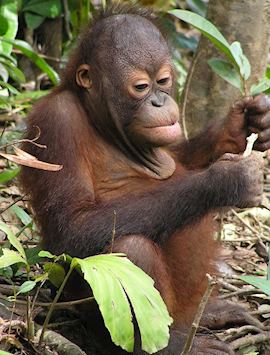
Orangutans & islands of Borneo
15 days from £3,440pp
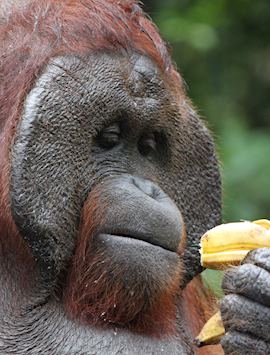
Heart of Indonesia: Java & Kalimantan
14 days from £4,770pp
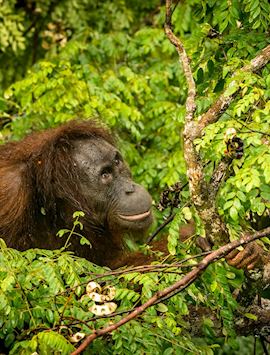
Wild Borneo tour
14 days from £5,150pp
Start thinking about your experience. These itineraries are simply suggestions for how you could enjoy some of the same experiences as our specialists. They’re just for inspiration, because your trip will be created around your particular tastes.
Further reading
- What to see in Borneo: our highlights guide
- The top 7 experiences in Borneo
- Borneo family holidays
- Honeymoons in Borneo
- Walking & trekking in Borneo
Plan your trip
Tell us about your plans and one of our specialists will plan a unique trip for you...
Request our brochure, The World Your Way

Order your digital copy via email.
- Central African Republic
- Democratic Republic Of Congo
- Indian Ocean
- Republic Of Congo
- South Africa
- Latin America
- Galapagos Islands
- North America
- Polar regions
- Arctic Canada
- Australasia
- Gorilla Tracking
- Grizzly Bears
- Polar Bears
- Puma Tracking
- Snow Leopards
- Blue Whales
- Bengal Tigers
- Siberian Tigers
- African Lions
- Spirit Bears
- Lowland Gorillas
- Experiences
- Jungle Holidays
- Bush and Beach Combinations
- Conservation Travel
- Natural World Heroes
- Work with Us
- Consumer Protection Overview
- Privacy Policy
- Press and Awards
- Client Reviews
- Expedition Leaders
- Specialist Leaders
- Expeditions for Change
- Journey to Natures Edge
- Country: Settings: Country:
- Currency: Currency:
- Call Us 01273 691642
- Destinations
- Gorilla Trekking
- EXPERIENCES
- Journey to Nature's Edge
Sepilok Orangutan Sanctuary

One of just four orangutan sanctuaries worldwide, Sepilok Orangutan Rehabilitation Centre (SORC) was founded in 1964 with the aim of rehabilitating baby orangutans and those saved from captivity. Arguably the best known in the world for its groundbreaking work in protecting these much-loved primates, it remains Sabah’s premier attraction for wildlife enthusiasts and travellers looking to explore Borneo’s natural wonders. Sepilok offers the best opportunity to witness the ‘man of the forest’ in a beautiful setting, occupying 15 square miles of virgin rainforest within the Kabili-Sepilok Forest Reserve – the only habitat in which the loveable primates are able to exist so comfortably.
A visit here is often cited as one of the highlights of our Borneo holidays.
Quick Facts:
- The orangutans: approximately 60-80 orangutans live freely in the reserve.
- Sanctuary in a nutshell: founded in 1964 and was the first sanctuary in the world to offer rehabilitation to orphaned orangutans.
- Other wildlife: doesn't just treat orangutans; have treated sun bears and rhinos as well as many other species.
Location and Activities
Located just 25 kilometres north of Sandakan, the primary goal of Sepilok may be orangutan rehabilitation, but it also focuses on public education, conservation projects and exercises as well as research and information on other endangered animals like the rhinoceros, making it an important centre for wildlife and ecology. During the tour, a boardwalk will take you to a viewing gallery and feeding platform where the orangutan are fed milk and bananas twice daily at both 10.00am and 3.00pm by the rangers that work within the park. They are deliberately fed bland foods in the hope that they will start to forage for themselves and become more independent, hopefully being released back into the wild. We would advise that you visit at one of the feeding times suggested to ensure that you get to see the orangutans during the height of their daily activity. Also attracted by the food during feeding hours, long-tailed macaques are known to frequent the centre’s grounds.
One of the biggest trappings when visiting Sepilok and the Sabah region of Borneo is to concentrate on Orangutans and Orangutans alone; this sanctuary offers the traveller an opportunity to truly appreciate the great biodiversity of this island in all its various forms. We recommend you spend more than one day taking advantage of the birding, trekking and trips along the river in the neighbouring areas of Sepilok to fully appreciate the other natural and wildlife attractions.
Sepilok Nature Resort is a uniquely positioned lodge, set in the heart of the tropical rainforest and bordering a lake that lies in the dense jungle. Offering comfortable timber chalets with hot and cold running water as well as air conditioning, we recommend our clients stay here to make the most of their time here, with all the creature comforts required after a long day in the jungle!
Fascinating and exciting to watch, these orange giant apes are also endearingly gentle, surprisingly flexible, intelligent creatures and will gaze at you with almost disconcerting frankness!
Contact us for a bespoke quote.
Leadership and Trustees
Our Work & Impact
Latest News
Orangutan Rescue, Rehab, Release
Illegal Wildlife Trade & Poaching
Get Involved
Ways to Raise
Our Partners
Restaurant Partnership
Educational Programs
Visit Borneo
Make a Donation
Adopt an Orangutan
Our Appeals
Leave a Legacy Gift
Our Work & Impact
Change content location:

Saving orangutans from extinction, together
Join our global movement.
Become part of our global orangutan community. Updates, events, offers and much more.
Adopt an orangutan
Ways to raise, our work & impact, life saving gifts.
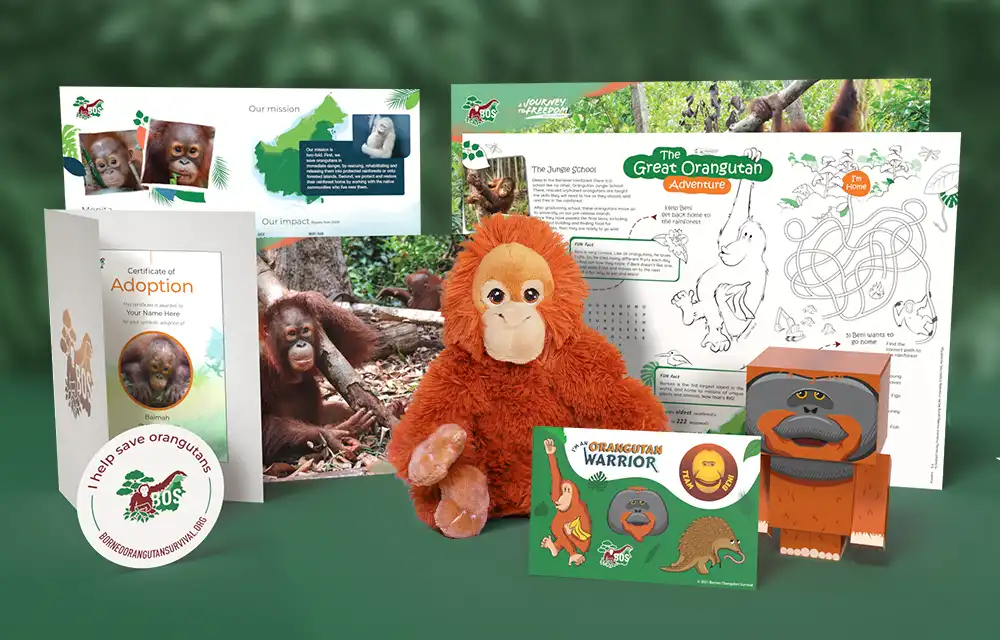
Adoptions that last
With your ongoing support, you become an integral part of your adopted orangutan’s journey back to the wild. With 3 exlusive packages, adoption is a gift that’s perfect for 2024 and beyond.

Supporting our life saving work
By donating you are ensuring the long-term survival of orangutans, and other rainforest species. We must protect and restore the Bornean rainforest.
Our Mission
Our mission is two-fold:
Conservation efforts protect habitats, promote biodiversity, and foster ecological balance, ensuring a sustainable future for all inhabitants, while mitigating climate change and preserving the rich tapestry of life.
orangutans in our care
ARE ORANGUTANS EMPATHETIC?
It was a usual day at the Nyaru Menteng forest school, where young orangutans were learning from one another while...
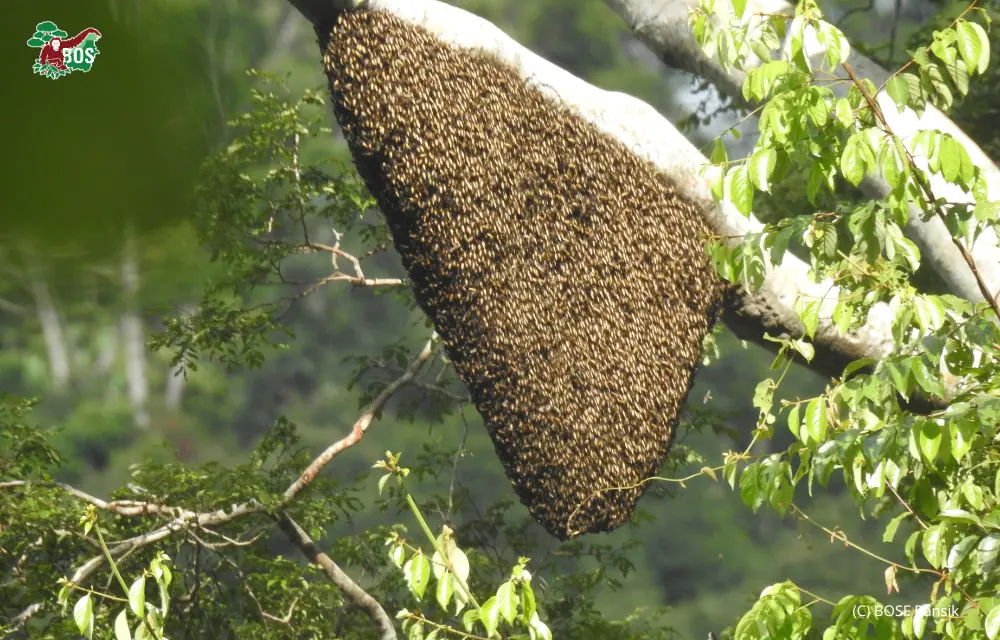
BEES TAKE OVER CAMP NLES MAMSE
Sweet, flavourful, and nutritious, honey is beloved by nearly everyone, but the same cannot be said for bees. As the...
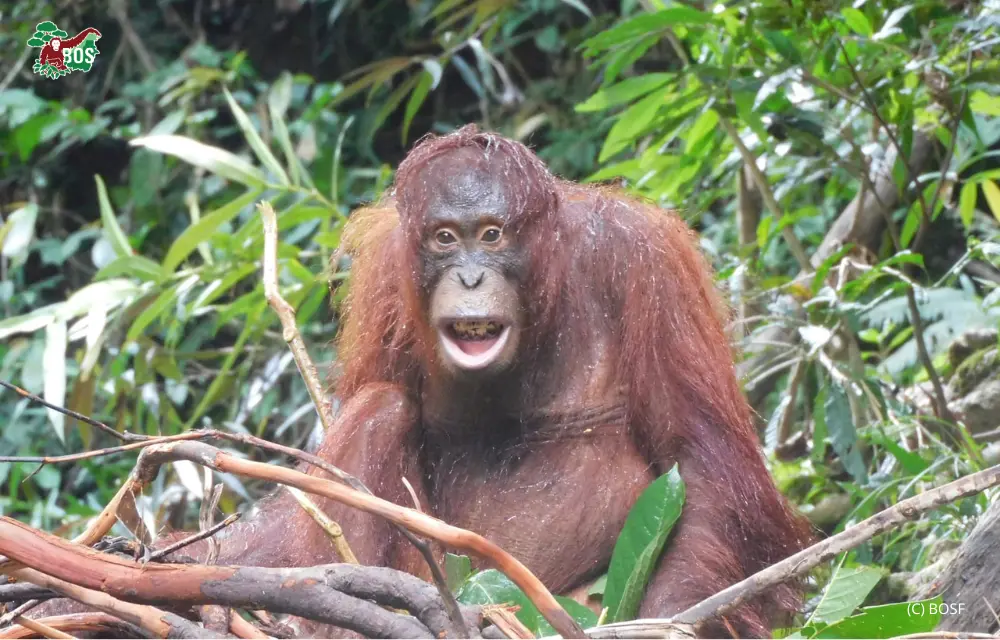

THE TALE OF SUCI’S RESILIENCE
Our Post-Release Monitoring (PRM) team at Camp Himba Pambelum in Bukit Baka Bukit Raya National Park (TNBBBR), Central...
Learn more about the work of BOS
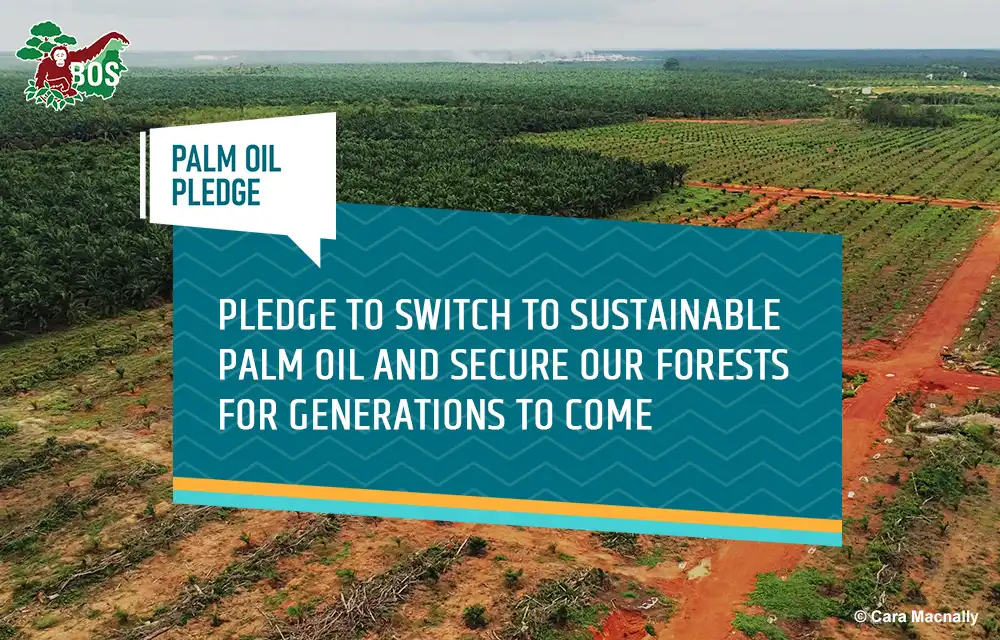
Sign the pledge now
Be part of the movement to save our forests and wildlife for future generations to come.

Sanctuary Islands
Give a better life to orangutans who cannot be released into the wild
In the Spotlight

This incredible show has it all, taking viewers on a roller coaster ride of adventures, heartaches, fun, friends, failures, and successes of all the orangutans who attend the BOS Foundation’s unique school.

Wildlife tourism has become a lucrative business worth around 250 billion dollars a year. These profits come at a cost. From the studio that brought you ‘Ivory Game’ comes a new and powerful documentary.

With your help, we plan to plant 400 more trees to help with reforestation efforts in BOSF’s Samboja Lestari rescue centre.
The gift that keeps on giving
Adoptions are a great way to support our work and make fantastic gifts! With your ongoing support, you become an integral part of your adopted orangutan’s journey back to the wild.
Or make a donation

- Privacy Overview
- Strictly Necessary Cookies
This website uses cookies so that we can provide you with the best user experience possible. Cookie information is stored in your browser and performs functions such as recognising you when you return to our website and helping our team to understand which sections of the website you find most interesting and useful.
Strictly Necessary Cookie is enabled at all times so that we can save your preferences for cookie settings.
If you disable this cookie, we will not be able to save your preferences. This means that every time you visit this website you will need to enable or disable cookies again.
This website uses Google Analytics to collect anonymous information such as the number of visitors to the site, and the most popular pages. Keeping this cookie enabled helps us to improve our website and services to you.
Turning analytics off would limit our ability to understand and improve our online services for people such as yourself, to find the information they are after.
Please enable Strictly Necessary Cookies first so that we can save your preferences!

The Great Orangutan Project
Volunteer with orangutans on this award-winning orangutan project at Matang Wildlife Centre in beautiful Borneo!
Situated within the tropical Kubah National Park, The Great Orangutan Project is a volunteer experience of major importance: not only is it the very first conservation experience started by The Great Projects, but it is one which we have seen grow from our flagship to a multi-award-winning orangutan sanctuary in Borneo, known the world over.
The project is based at the famous Matang Wildlife Centre and is home to an array of enchanting species. Animals such as sun bears, binturongs and macaques have all made their home here, but few have captured the heart of visitors quite like the orangutan has.
Critically endangered, the orangutan stands as a symbol of conservation, and its very existence here at Matang Wildlife Centre serves as a reminder that more must be done to combat the perils of an at-risk rainforest. Mass deforestation, mining, and forest fires each pose a significant threat to this most empathetic of animals, leaving many orangutans exposed to further threats such as hunting and the pet trade. Countless orangutans find themselves orphaned or severely injured as a result of these threats, and without a centre such as Matang to take them in, these orangutans would simply have nowhere to go.
As a volunteer, you will have the opportunity to assist at this most important of wildlife centres. From working to improve husbandry standards to providing enrichment for the orangutans, your time spent volunteering on The Great Orangutan Project is sure to be both enjoyable and worthwhile. Take the opportunity to leave a lasting impression on Malaysia’s captivating wildlife, working hard to provide a meaningful future not only for the animals at the centre, but also for the region’s wildlife for many years to come.
From £795.00
- Up to 12 Persons
- All Meals Included
- 7 - 28 Nights
- Set dates - enquire for details
- Minimum Age 17 (Or From 14 Years Old With An Adult)
Speak To A Travel Expert

On this project you will have the opportunity to engage in a wide variety of activities. Your main focus, however, will consist of providing enrichment and husbandry for the orangutans, sun bears, macaques, binturongs and other animals. Additionally, you'll have time to explore the areas surrounding the project - so why not see how you could spend your downtime by clicking here ?

The below itinerary represents a typical 2 weeks on the project, though if you join the project for 4 weeks, days 14 and 15 will become days 28 and 29. There is also a 1-week option available for select start dates and the itinerary can be viewed by clicking here .
Start Dates & Prices
To secure a place on this project a deposit of £195 is required at the time of booking, with the remaining balance due any time up to 60 days prior to your start date.
Select a duration below to see all available start dates. All dates shown are currently available for you to join this project! Please note, the 7-night durations only take place on select dates throughout the year and often become fully booked up to 6 months in advance.
- Accommodation

Volunteer Accommodation
(Note: These wooden houses are original structures from the construction of the centre in 1997. They are government owned and have undergone little maintenance over their years of wear and tear in the jungle. Please do not expect shiny, new and pristine lodgings – expect well-used, jungle chalets and an authentic Bornean experience!)

Meals & Beverages
On the first night, your welcome dinner will be provided at a restaurant in Kuching. Whilst at Matang Wildlife Centre, you will be responsible for preparing your own meals in the kitchen of the chalet that you are staying in (except for on your final day when you will enjoy a farewell BBQ with the team). You can either cook for yourself or, as volunteers often do, take it in turns to cook for the rest of the group so you get a chance to taste everyone's home cuisine. As part of the cost of the project, you will receive a weekly allowance for food and water and weekly supermarket trips are also included!
Project Details
When is the best time to volunteer.
As this project is based at a wildlife centre, there are orangutans, sun bears, and other animals here all year round, meaning there is no ‘best’ time to volunteer with regards to seeing wildlife.
However, the weather may have an impact on your preferred travel dates. Whilst it can rain all year round due to it being a rainforest climate, the distinctive rainy season is between November and February, making March to October a preferable time to volunteer. The two weeks from December 19 th and over the remainder of the Christmas period are particularly popular dates for our volunteers, so we recommend booking early if you wish to travel at this time of year.

Getting There
You will need to arrive into Kuching Airport on the start date of your project between 7am and 5pm. You will be met by a project representative in the arrivals hall and transferred to your first night’s accommodation at a guesthouse in Kuching. A welcome dinner is held for you on the first night, giving you time to get to know your fellow volunteers and the project staff.
On the final day of your project, a transfer can be arranged from the guesthouse in Kuching, where you will stay on your final night, back to the airport for RM30 (approx. £6).
Visa Requirements
Most nationalities do not need to obtain a visa in advance of travelling to Malaysia, as a free 90-day visa is issued on arrival. Please note, however, that visas are of your own responsibility and that you should check your own requirements with your country’s embassy.
Fitness & Skills
The construction work undertaken on this project can be quite physically demanding, often in humid conditions, so a moderate level of fitness is advised. You do not need any specific skills or experience, just a commitment to the project and its aims, the ability to work as part of a team and an upbeat, positive attitude towards the project and orangutan conservation.
Vaccinations
There are no specific vaccination or medical requirements needed to join this project and as such, the vaccinations you require will depend on your medical history. We, therefore, recommend that you consult your GP/Doctor regarding your own immunisation needs.
No Contact Policy
We are often asked whether or not volunteers will have the chance to touch or play with the orangutans whilst on this project. Our answer to this question is, and always will be no, and this is for good reason.
Orangutans are highly susceptible to human diseases, many of which are far more dangerous to an orangutan than they are to us. Also, an environment of constant change, with new volunteers going to the project every two or four weeks and being in contact with the orangutans would be very detrimental to the orangutans' well-being. With no consistency in their lives, behavioural problems arise. They also have a tendency to begin to trust humans which is damaging should they be released back into the wild, as they will become easy targets for poachers. Finally, an orangutan is around 7 times stronger than an adult male human so a no-contact policy is just as crucial for your safety as theirs.
That is not to say that you will have no interaction with the orangutans, it simply means that you will have no direct contact with them. You will still observe them on a daily basis and see how your contribution to their husbandry and enrichment makes a real difference to the lives of these apes. For more information, please view our article on hands-on contact with orangutans .

Experience The Great Orangutan Project
See what it's really like to volunteer on The Great Orangutan Project in Malaysian Borneo.

Volunteers Review Their Time on the Project
Caroline, Dave, Sarah and Charlie review their experience volunteering at The Great Orangutan Project.
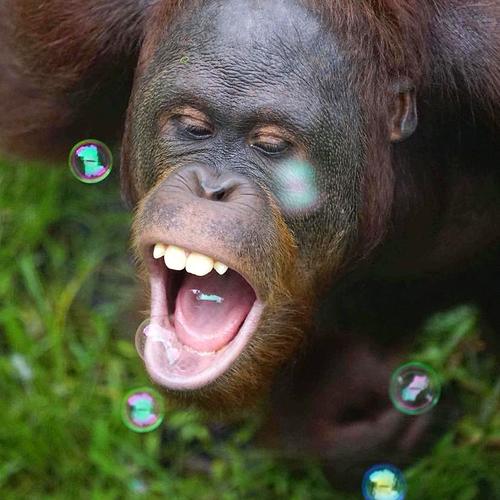
{{ review.review }}
Response from The Great Projects {{ review.response }}
What's Included
- Food allowance
- Arrival Airport Transfer
- Full orientation and support from the project managers
- A donation to the project
What's Not Included
- Travel insurance
- Departure Airport Transfer
- Soft drinks or alcoholic beverages

SIGN UP TO THE NEWSLETTER
Sepilok Orang Utan Rehabilitation Centre
The Sepilok Orang Utan Rehabilitation Centre (SOURC) was established in 1964 to rehabilitate orphaned orangutans. It has since grown from having just an outdoor platform to having an Outdoor Nursery viewing area. It is located within the Kabili-Sepilok Forest Reserve, making the area suitable for trekking and birding.
If you are coming from the Sandakan City Centre, SOURC is about a 40 minute (23KM) drive away. There are also many jungles lodges within a 1km radius of the area that one could opt for.
Generally visitors to Sepilok are able to see orangutans during the scheduled 10:00am and 3:00pm feeding session at the platform. Alternatively, some orangutans can be seen from the outdoor nursery. Have there been occasions where no orangutans have not shown up for feeding? Admittedly yes! And we give you this heads up, while not something that occurs frequently, the main reason the orangutans may not appear during feeding time, is because they managed to get food in the wild, especially during fruiting season. This is indeed a great feat in actual fact, as the whole purpose is to ensure these primates understand that their natural home is in the wild and not to be dependent instead on a conditioned environment.
“I have touched and hugged and orangutan. Why can’t I do so here?” Because many human diseases could affect orangutans who share 96% similarities in DNA, hence at SOURC, we request that visitors do not touch the orangutans, especially those who may appear on the boardwalk.
Adjacent to the Sepilok Orang Utan Rehabilitation Centre is the Bornean Sun Bear Conservation Centre .
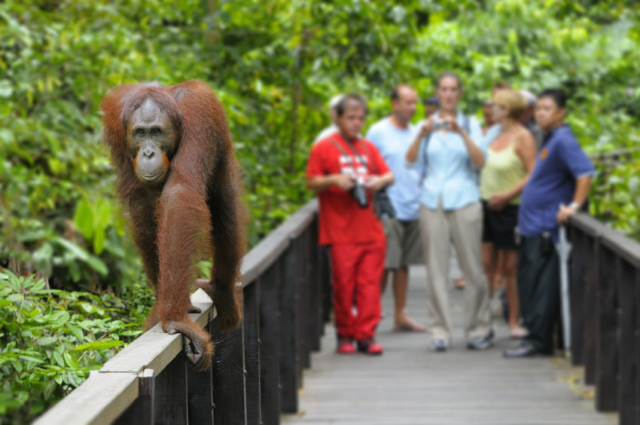
Product Contact
Sabah Wildlife Department Batu 14, Jalan Labuk Sandakan , Sabah WDT200, 9009 Sandakan, Sabah.
- +60 89 633 587
- wildlife.sabah.gov.my
Other Attractions around Sandakan
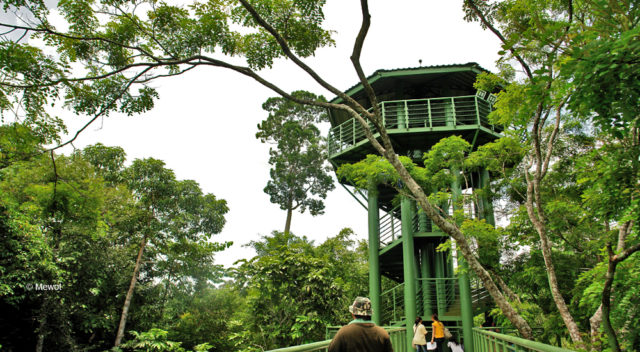

Orangutan Volunteer Program
© Sam Rios | No Beaten Track
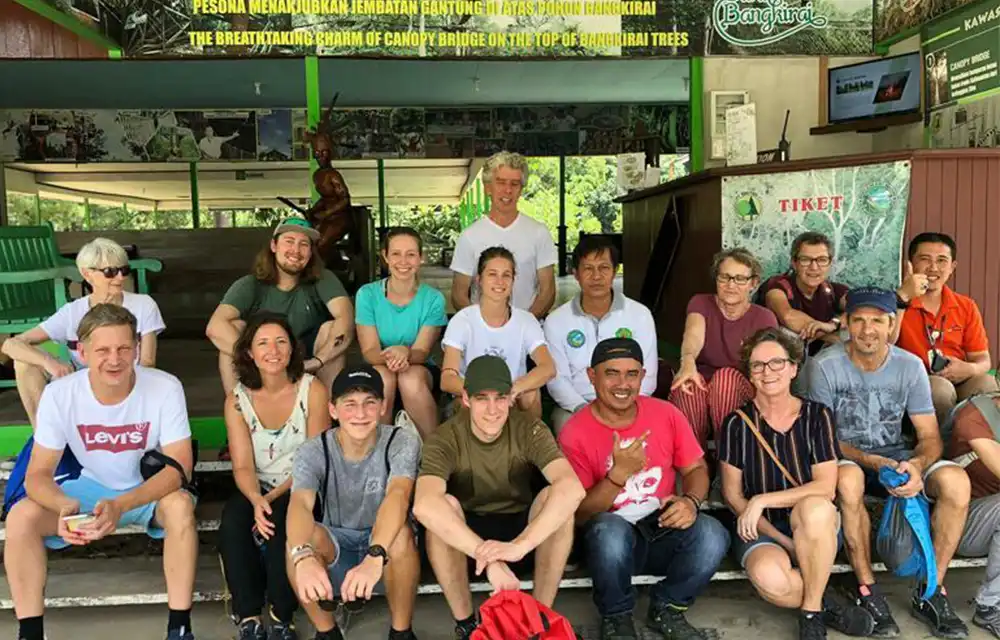
Join an official BOS Orangutan Volunteer Program
Spend two weeks in beautiful Borneo at Samboja Lestari, a sanctuary that cares for approx 125 orangutans and 72 sun bears. If you are passionate about protecting orangutans and want to make a practical difference, this program is for you.
Situated within the Bornean tropical rainforest, Samboja Lestari remains one of the best and most accessible places in the world to see orangutans, whilst respecting the fact they are wild animals. Apart from orangutans, our centre is home to an array of other enchanting species like sun bears, binturongs and macaques.
What to know:
- Available in English
- In Samboja Lestari, Borneo
- Availability: various dates whole year round
- 13 nights / 14 days
- All organic meals included
- Up to 10 people
Take this opportunity to leave a long-lasting impact on Indonesia’s wildlife, working hard to provide a meaningful future not only for animals at the centre, but also for the region’s wildlife for many years to come.
Volunteering
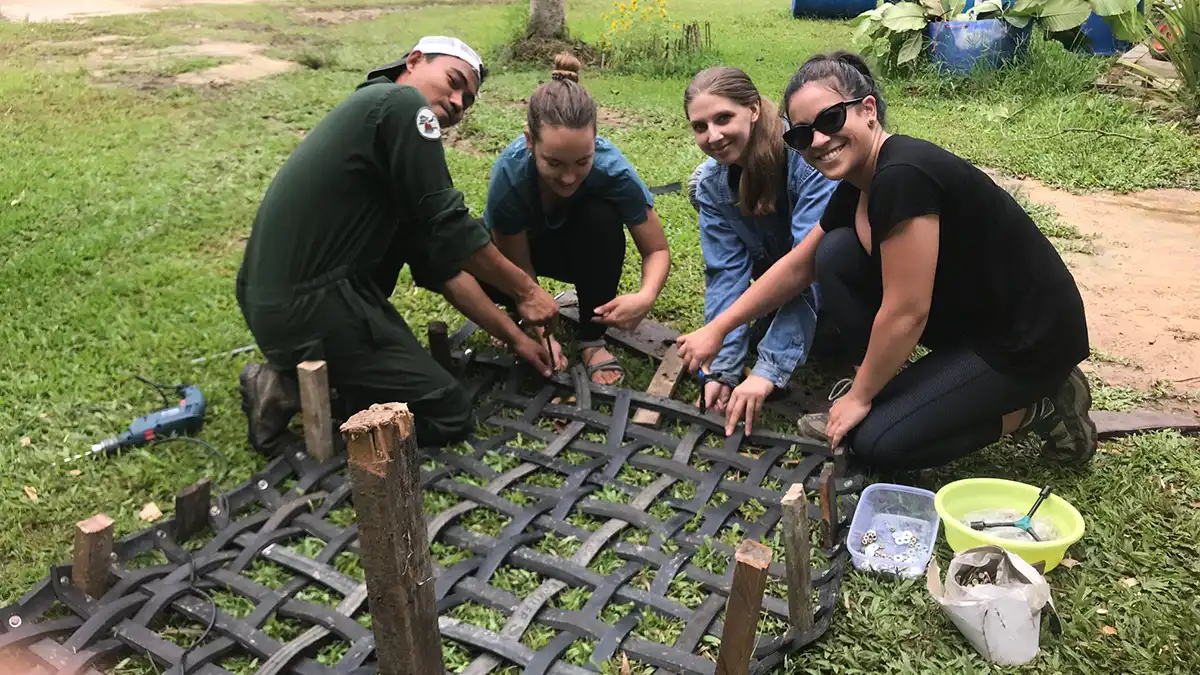
As an Orangutan Program Volunteer, you will be a key part of our enrichment and welfare program. Enrichment programs are vital for captive orangutans, teaching them how to forage for food, build, modify and use tools, increase agility and develop skills to survive in the wild. Take this opportunity to leave a long-lasting impact on Indonesia’s wildlife, working hard to provide a meaningful future not only for animals at the centre but also for the region’s wildlife for many years to come.
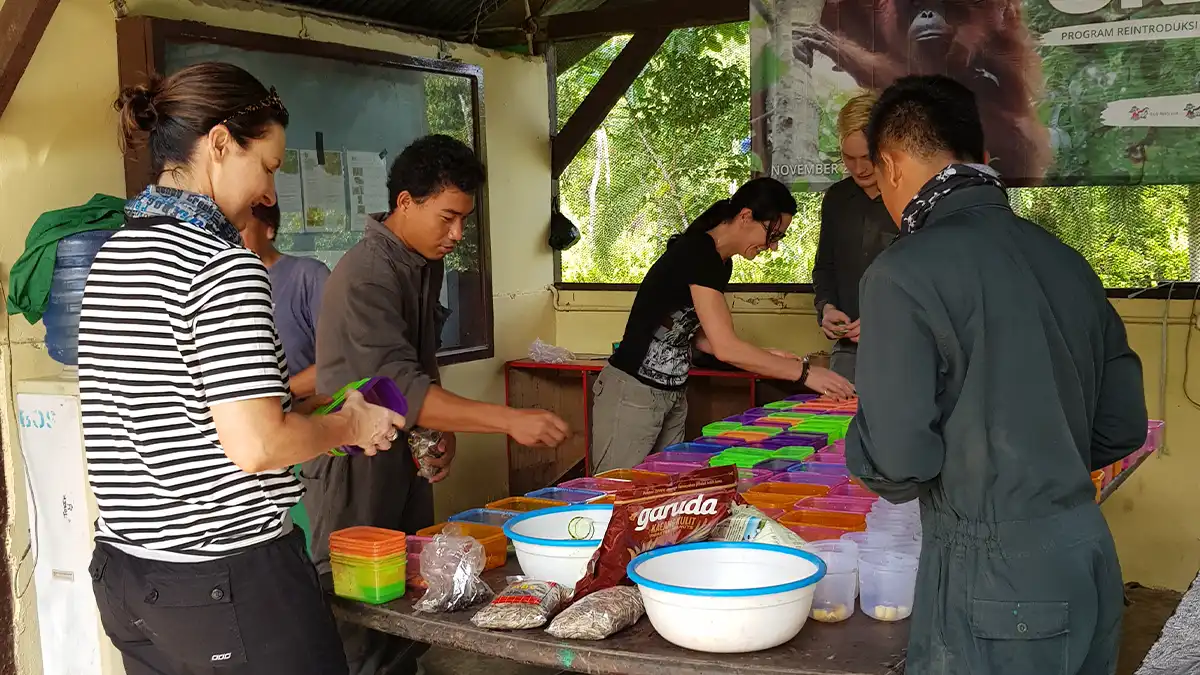
While in Borneo, you will help to make enrichment items for the orangutans that are being cared for at Samboja Lestari. These items really make a difference to the everyday lives of the orangutans, helping them to learn valuable skills that they will need when released into the wild. For those orangutans that unfortunately cannot be released, enrichment items help bring variety, diversion and enjoyment to their days.
Your activities in a nutshell
Orangutan Sanctuary
A highlight and extreme privilege of our program is touring Samboja Lestari Orangutan Sanctuary. Samboja Lestari (translated as " Samboja Forever") is currently a home to 127 orangutans that have been released into 6 islands around the lodge. Our detailed tour, will get you one-of-a-lifetime opportunity to deepen your orangutan knowledge but also observe the behaviour of rehabilitated individuals living within the complex.

Visiting Sun Bears
The BOS Foundation also looks after 69 sun bears, the smallest and definitely cutest bears in the world. You will get to see staff feeding the bears and learn more about our efforts to build large forested outdoor enclosures for them. At its core, we care for them in a similar way to how we care for orangutans, because for both it is not only about tending to their physical needs, but their social and psychological ones as well!
Canopy Bridge
See the rainforest from a different perspective by walking along the Canopy Bridge, 30 meters above the forest floor. A must-do activity!
Sungai Hitam Boat Cruise
Following a 30 minute drive from Samboja Lestari, you will take a leisurely boat ride along the Sungai Hitam river to see highly endangered proboscis monkeys and a river side village of houses built on stilts.
Sanctuary Islands River Cruise
Embark on a river cruise around the spectacular Sanctuary Islands! Orangutans spend time on these islands prior to their release and are given the space to put their forest skills (acquired through the rehabilitation programme) to the test. This will be a great opportunity for you to learn a little more about the project and the many successful releases BOSF have undertaken, as well as learning about some of the characters on the islands.
Tour of NM Rehabilitation Centre
See what your support has enabled us to achieve over the years by taking a guided tour of our Nyaru Menteng rehabilitation centre. Meet some of our local staff - the heroes who keep these centres running every day and who look after hundreds of orangutans in our care.
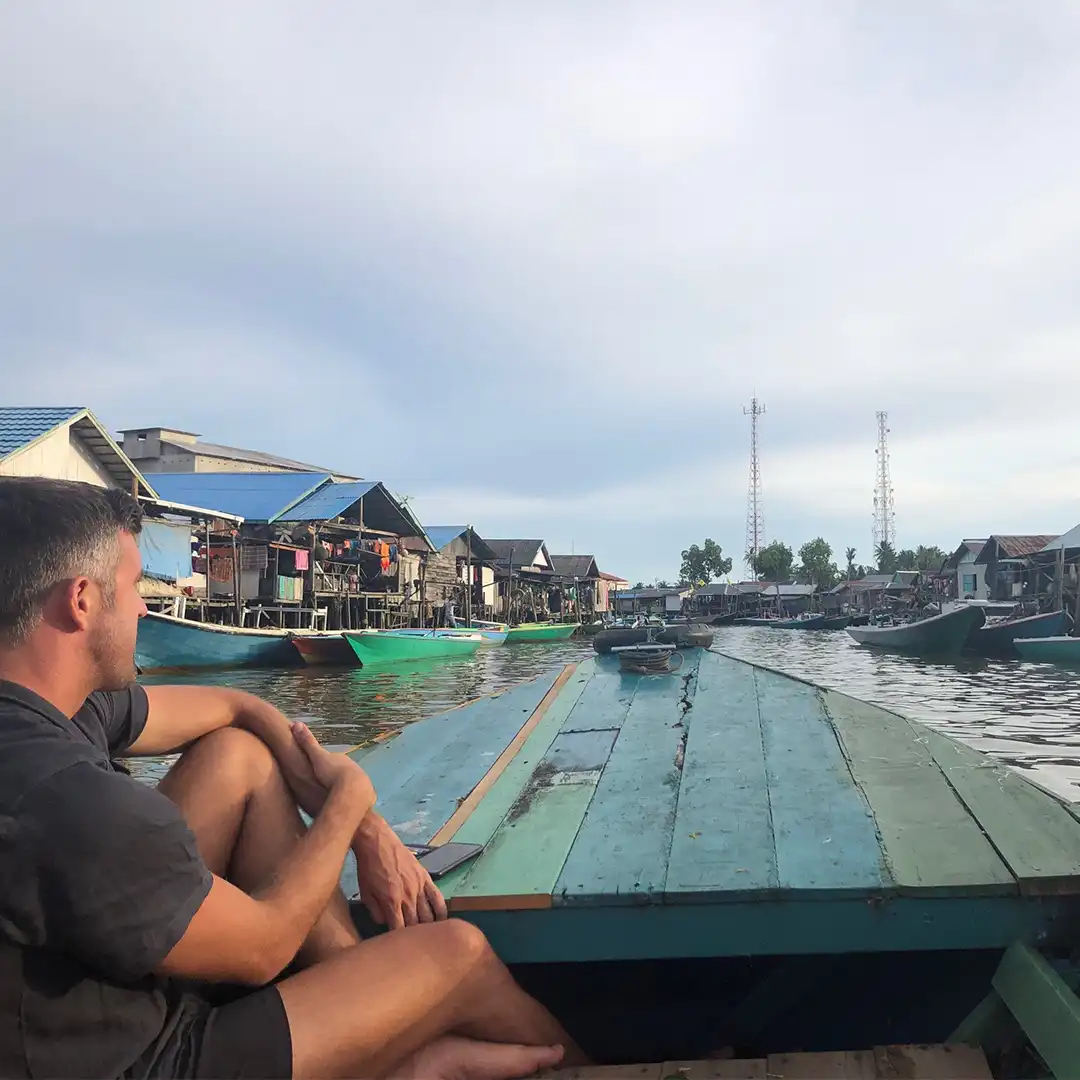
Accommodation
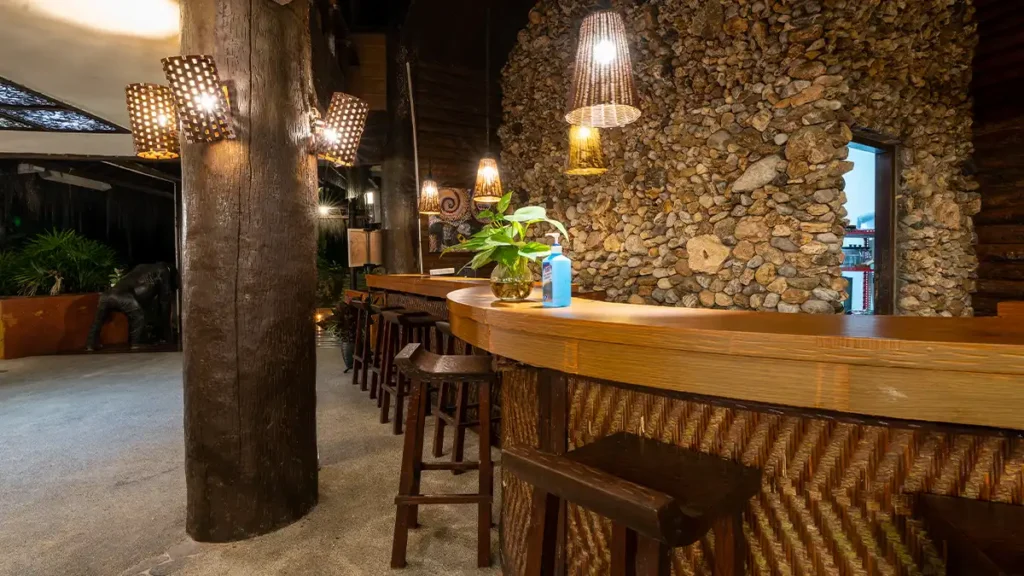
Estimated travel cost is based on the twin-share standard first floor rooms, with cold water and a lovely garden view. In the warm climate, the cold water is refreshing and cleansing to shower in after a hot, sweaty day. Single rooms and rooms with hot showers are available at an extra cost.
Wildlife that you may see
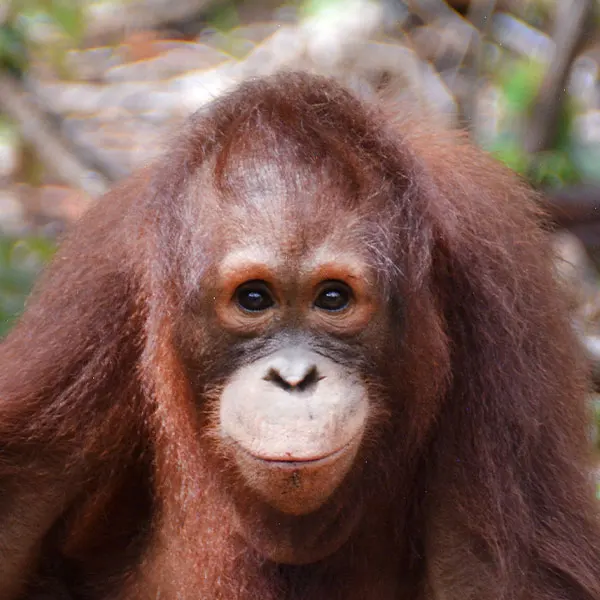
Pig-tailed macaque
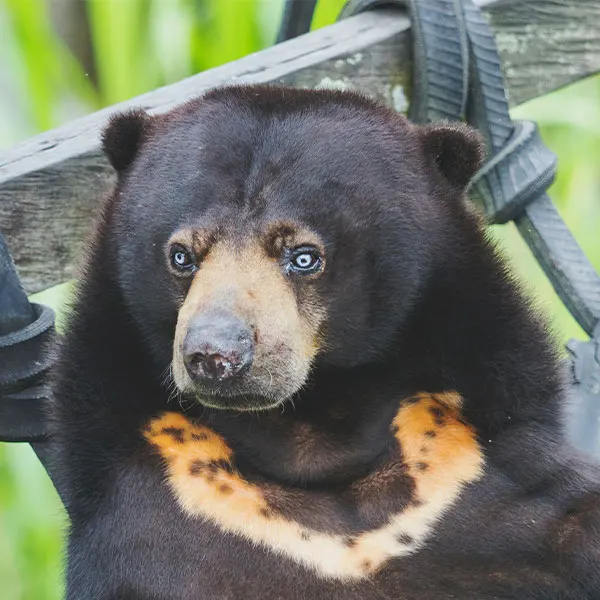
Probiscis monkey
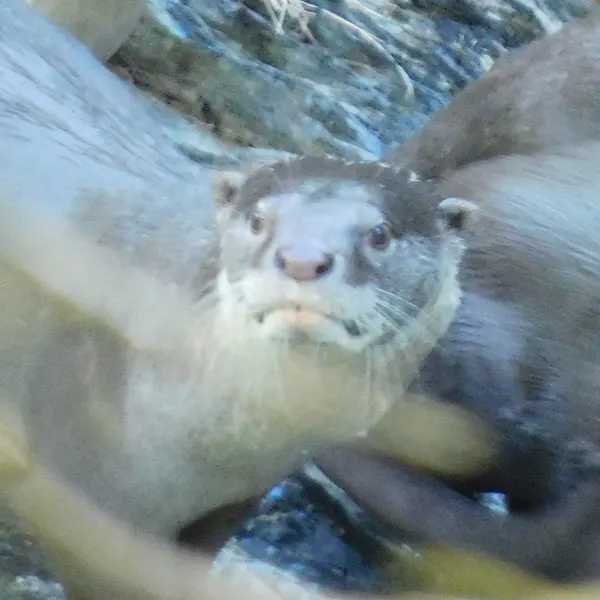
Asian otter

Water monitor
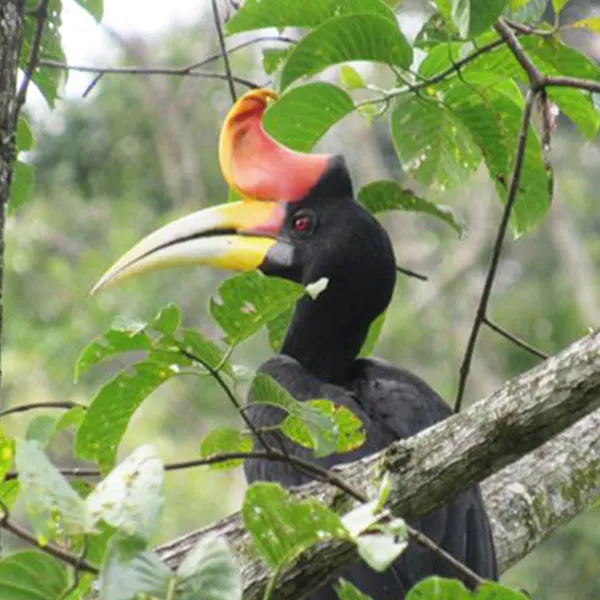
I loved walking through the forest, thevariety of plants, flowers, trees and animals. There was so much to discover. It was so peaceful and quiet – and still you could always hear different animal noises.
Thanks to the organizers of the program! What you and BOS achieve in general is unimaginable and to see it upclose is wonderful. I would also like to commend the staff at Samboja Lodge. Everyone is very friendly, motivated and seems very happy.
Email address
Phone number
Number of guests Number of guests 1 2 3 4 More
Select your date Select your date 6-19 October 2024 20 October - 2 November 2024 3-16 November 2024 17-30 November 2024 1-14 December 2024 5-18 January 2025 19 January-2 February 2025 2-15 February 2025 16 February-2 March 2025 2-15 March 2025 6-29 March 2025
Accommodation preferences Accommodation preferences Space in a twin room Shared space with a partner/friend Book a private room
Country of residence
Any further information?
Marketing communications Marketing communications I want to subscribe to Borneo Orangutan Survival and I agree to receive marketing updates
Further info
Covid-19 & health requirements
Allergies & dietary requirements.
Considering that the program takes place within a rainforest, the weather can naturally be unpredictable. Please note that we may be prevented from doing some of the activities if this is the case. Replacement activities will be offered during these times.
What's included
Full board accommodation, breakfast lunch and dinner, transportation from/to the airport.
What’s excluded
Costs of the obligatory health tests, other travel costs (especially flights), activities & tours, insurances, vaccination, and alcoholic beverages.
Recommended flights
Any flights arriving in Borneo on the first day of the program and departing after program finishes. Let us know if you are planning to arrive/depart on different days.
Please remember that airfare is not included. The airport shuttle is only included on the day the program begins and ends. An extra fee will be added if you arrive or depart on alternative days.
Cancellation policy
Please note that unless the program is cancelled, your deposit is non-refundable as costs need to be paid for in advance.
If you have any queries or like to chat about the best options for you, please contact us through [email protected]

- Privacy Overview
- Strictly Necessary Cookies
- 3rd Party Cookies
This website uses cookies so that we can provide you with the best user experience possible. Cookie information is stored in your browser and performs functions such as recognising you when you return to our website and helping our team to understand which sections of the website you find most interesting and useful.
Strictly Necessary Cookie is enabled at all times so that we can save your preferences for cookie settings.
If you disable this cookie, we will not be able to save your preferences. This means that every time you visit this website you will need to enable or disable cookies again.
This website uses Google Analytics to collect anonymous information such as the number of visitors to the site, and the most popular pages.
Keeping this cookie enabled helps us to improve our website and services.
Please enable Strictly Necessary Cookies first so that we can save your preferences!

Orangutan tours in beautiful Borneo
Make a difference to borneo's wildlife, travel through the wild untamed lands of beautiful borneo with orangutan trekking tours, imagine a place that is spiritual and wild, colourful and mysterious, and full of tantalising secrets. this is beautiful borneo..
- Wild Orangutans
- Bornean bearded Pigs / Wild Boar
- Black handed Gibbons
- Proboscis monkey
- Highly experienced tour guides
- King Fishers
- Amazing plant diversity
Our Difference
We have spent most of our lives in the jungle and rivers of borneo. growing up in this environment lead to us becoming wildlife and culture tour guides, supported by our family’s deep knowledge and understanding of the area..
Our Adventure Tour packages have been carefully designed to build an awareness of ecotourism while taking safety and impact on the environment into consideration. We also like to help our trekkers design customised itineraries, perfect for visiting the orangutans and going beyond!
Whether you are wanting to relax and unwind, be educated on the issues affecting Borneo’s wildlife, or turn up the pace and take on the all of the experiences that Borneo’s wildlife has to offer, you will be in great company. We look forward to making your trip the experience of a lifetime!
Our Tour Packages
Our adventure tour packages have been carefully designed to build an awareness of ecotourism while taking safety and impact on the environment into consideration., tour options.
4 Days & 3 Nights
5 Days & 4 Nights
Photography tour
Or choose your own!
Who are our tours for?
People who care about and enjoy:
- Eco tourism
- Walking and treks
- Photography
- Making a difference
“Once you travelled, the voyage never ends, but is played out over and over again in the quietest chambers. The mind can never break off from the journey.”
“Twenty years from now you will be more disappointed by the things you didn’t do than by the ones you did do.”
Our tour guides take amazing photographs of the wildlife and tours. The following are just a glimpse into some of the incredible experiences you will have on an Orangutan Trekking Tour.
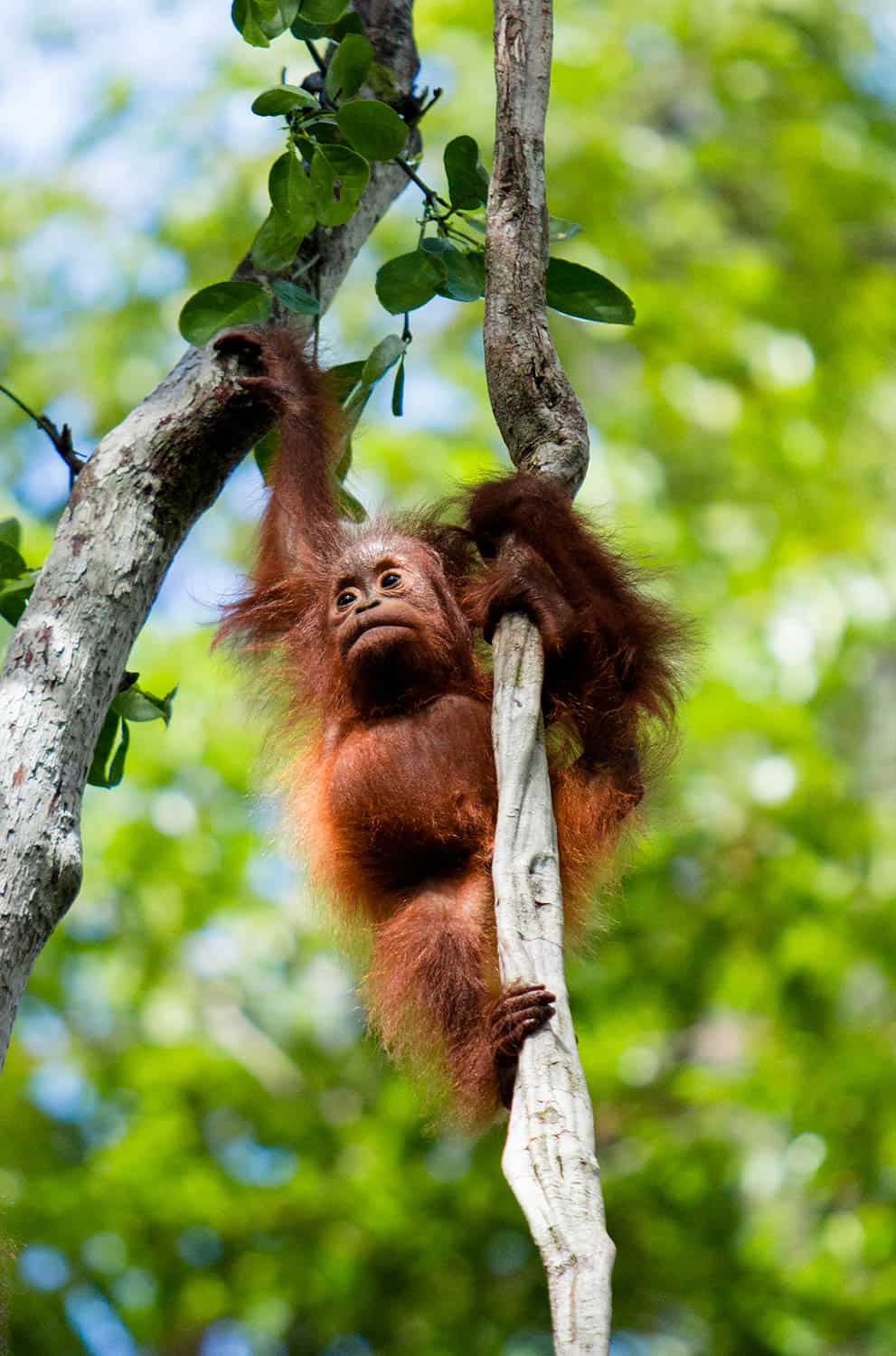

Project Borneo
Conservation. Animal welfare. Ethical volunteering & tours
Join us in Borneo and do something amazing - or scroll down to see how we make the world a better place

Project Borneo at a Glance
Our work with endangered species in Borneo began with Project Orangutan in 2006, and the scope of the charity has expanded steadily ever since. Our hugely successful ethical volunteer and tour programmes are at the heart of what we do, providing essential hands-on-deck - as well as unforgettable experiences. At the same time a creative approach to sustainable fundraising has resulted in 4 partner businesses which help support us financially, meaning we don’t rely on donations alone.

Animal Welfare Volunteering
Our volunteer programme, based at the Matang Wildlife Centre, cares for orangutan, sun bears, hornbills, sambar deer, clouded leopards and many other endangered species indigenous to Borneo.

Fundraising Businesses
We have 4 joint-ownership business (two hotels and two bars) which not only generate vital income for the charity, but also help raise awareness amongst tourists and locals alike.

King Louis; the Plush Orangutan

Animals of Borneo Poster - digital download

Ohm - digital download

Sun Bear T-shirt

Monkee Bar / Orangutan Project T-Shirt

Orangutan, Rainforests and Tribes Tour

2-Week Volunteer Programme

4-Week Volunteer Programme
Sepilok Orangutan Rehabilitation Centre
Established in 1964, Sepilok was the first centre in the world to dedicate itself to the rehabilitation of orangutans.
Key information
About Sepilok Orangutan Rehabilitation Centre
The world-renowned orangutan conservation facility located in the state of Sabah, Malaysia on the island of Borneo.
The centre's primary mission is to rehabilitate and provide a safe haven for orphaned and injured orangutans, one of the world's most endangered primates.
Orangutan Appeal UK has been actively supporting the centre since 2001, ensuring its continued success in rescuing, rehabilitating and conserving orangutans. Explore our pages to discover the extraordinary work we do in collaboration with Sepilok to safeguard the orangutans' future.
Owned and run by the Sabah Wildlife Department, the centre is located in the Sepilok-Kabili Forest Reserve, which covers an area of 43 sq km. Facilities include a clinic, treatment ward and nurseries.
Today around 60 to 80 orangutans live independently in the rainforest reserve and approximately 25 orphaned orangutans are housed and cared for in the nurseries. If you visit Sepilok, you will have the opportunity to enter the rainforest reserve and hopefully observe some of the orangutans in their wild habitat. These orangutans enjoy the freedom to roam as they please. They are provided with supplementary food which is given to them daily. This additional food is purposefully designed to be monotonous so as to encourage the apes to forage for themselves.
In addition to their rehabilitation work, Sepilok is considered by the Wildlife Department to be a useful educational tool for both locals and visitors alike, but they are adamant that the education must not interfere with the rehabilitation process and so visitors are restricted to walkways and are not allowed to approach or handle the orangutans.
Visitors can learn more about the conservation efforts being undertaken to protect this critically endangered species from Orangutan Appeal UK's Liaison Officer and in the newly updated visitor information centre.
Areas of protected forest, like the Sepilok-Kabili Reserve, help to mitigate the impact of deforestation on orangutans. Orangutans become isolated and vulnerable as a result of logging and forest clearing. Female orangutans with young are often killed by poachers who will take infants and sell them. The Malaysian Government has clamped down on illegal trading, outlawing all such practice and imposing prison sentences on anyone caught keeping them as pets.
Youngsters kept in captivity often become sick or suffer neglect which in some cases extends to cruelty. Whilst some of the orangutans raised as pets can never be returned to the wild, others can be rehabilitated; it is a long and expensive process, taking up to seven years but one that, centres such as Sepilok, take on without question.
Once rescued and taken to the safety of Sepilok, orangutans are quarantined to avoid the spread of illnesses to the other inhabitants of the centre. Every new arrival has a thorough health check in the on-site clinic which boasts a number of excellent facilities, thanks to funding from Orangutan Appeal UK.
Depending on their age and ability, they are then moved to either the indoor or outdoor nursery. The indoor nursery mostly houses the youngest orangutans at Sepilok - especially those that have been orphaned or have serious health concerns. Here they will learn the basics of how to be an orangutan. Things like tree climbing, nest building and foraging will be encouraged here. Due to the vulnerability of these orangutans, this area of the centre is not accessible to the public.
Older, more advanced orangutans live at the outdoor nursery which is on display to the public via a purpose built observation building. Here you are able to watch them eat and play throughout the day. The orangutans in this nursery have free access to the forest which they can explore using ropes. This system has been a successful way of introducing the older individuals to a more independent lifestyle which will hopefully lead to release.
Tickets to Sepilok
You can buy tickets (cash only) from the counter between 09:00 to 11:00 and 14:00 to 15:30. It costs 30RM for foreign tourists, the ticket allows you to attend both feedings that day. You can't pre-book tickets.
Opening times
The centre is open 365 days a year. Open daily from 9am to 4pm. Feeding platform and outdoor nursery opening hours are: 09:00 to 12:00 (Fridays 09:00 to 11:00) and 14:00 to 16:00.
Presentation and film times
Join our Liaison Officer before entering the reserve to hear fascinating insights about Sepilok and what to expect from your visit. Daily at 08:45, 09:00, 10:30 and 14:00.
Feeding times
Food is available for the orangutans at the main feeding platform at 10:00 and 15:00, and at the outdoor nursery at 9:30 and 14:30.
Photography
There is a camera fee of RM10 (approximately £2) should you wish to take your camera to the feedings with you. Please note that cameras with over 600mm lens will incur a fee of RM1000 (approximately £180).
FAQ's about Sepilok Orangutan Rehabilitation Centre
If you can't find the answer to your question below, please email us at [email protected] and we will do our best to help.
How do I get to the Centre?
From Sandakan: There are usually four public buses which come directly to Sepilok (at 9:00, 11:30, 14:00 and 17:00) and four returning back to Sandakan (at 06:00, 10:30, 12:30 and 16:00). The bus journey takes around 45 minutes and costs 4RM per person. We advise you check the times and locations locally, as we are not able to guarantee this information. Many of the hotels nearby can also arrange a shuttle service. It is very easy to take a taxi too. Taxis from Sandakan airport take around 20 minutes to get the centre and cost approximately 50RM. The best way to order one is via the Grab app which you can download here .
From Kota Kinabalu: The journey takes 5 hours by bus stopping at junction ‘Jalan Sepilok’, a 2.5 km walk from the centre. However, there are frequent flights from KK to Sandakan which take around 45 minutes with return prices starting from as little £30 GBP.
Am I guaranteed to see an orangutan?
These orangutans are living wild in the reserve and come back for a free feed should they wish - for this reason sightings cannot be guaranteed. The numbers of orangutans which come to the feedings differs on a daily basis and as they are wild and free to travel in the reserve it can never be guaranteed that any will come for the feed at all, especially during the fruiting seasons when naturally growing food is in abundance, and if it is raining. Although this can be disappointing for those hoping to see the orangutans, the truth is if no orangutans come, then it is a positive thing - it means they are not reliant upon the feeding to survive and are living a free and natural existence in the reserve. Although sightings at the feeding platform are not guaranteed, visitors also have the opportunity to observe some of the adolescent orangutans currently on their final stage of rehabilitation. Here, people can watch through specialist protected facilities as the young orangutans train on the ropes and trees as they begin transitioning back into the wild. However, if it is raining the orangutans at the outdoor nursery may have to be kept indoors, this is to prevent the spread of diseases such as Melioidosis, which is found in soil and water. The health and wellbeing of the orangutans is paramount.
Can we touch the orangutans?
'Hands on' contact with the orangutans is not permitted, and is in the best interest of the orangutans. Orangutans are very susceptible and vulnerable to human diseases, and therefore exposure is strictly regulated to reduce as far as possible any potential infection. In addition, human contact is kept to a minimum, not only for the safety of the orangutans but to avoid unnecessary risks to visitors (orangutans are very strong and as wild animals can be unpredictable).
To ensure their best possible chance of survival once they are eventually released back into the wild, dependence or familiarity with people is strongly discouraged.
Is there anyone who can answer my questions that I have at the centre?
Orangutan Appeal UK has a Liaison Office at the Centre, who is usually there all day from Monday to Friday and also on Saturday mornings. S/he will be very happy to answer your questions and point out various characters from the feeding platform.
What can I expect from my experience at Sepilok?
Visitors, having seen the educational (although optional) DVD, can explore the orangutan information centre before making their way through the forest to the viewing platform. From here they can witness the successfully rehabilitated orangutans living wild in the reserve coming for a free feed. It's an incredible experience, as the trees begin to shake, and a flash of orange appears. A ranger will arrive with fruit and sugar cane to place on the feeding platform, approximately 60 feet from the viewing platform. The orangutans that come for this free feed are wild and therefore can be dangerous, so there are staff on hand to make sure interactions do not occur, for the safety of both visitor and orangutan. Because they are wild, it can never be guaranteed that many will come for the feed, if any at all (especially during the fruiting season). This is where some people leave disappointed, but the truth is if no orangutans come, then it is a positive thing - it means they are not reliant upon the feeding to survive. You will however have a magical experience in the forest surrounded by the sights, smells and sounds of Borneo.
How can I donate towards the care of the orangutans at the centre and orangutan conservation?
Please visit either our Donations page or why not adopt one of the orphaned orangutans before you go. You may even get to see your adopted baby when you visit. Adopting one of the young orangutans is an excellent way to help us raise funds for our current projects and get something back in return for your support. Visit our Adoptions page for further details or give us a call on +44 (0)1590 623443. You can also adopt or give a donation when you are at the Sepilok. Please speak to our Liaison Officer who will be happy to help you. If they are not available please complete an adoption leaflet from the desk in reception area and place it in the slot on the desk along with your donation.
Can I buy food at the Centre?
There is currently no onsite cafe at Sepilok.
Can I buy souvenirs at the Centre?
There is a small, privately owned gift shop at Sepilok which is open 09:00 - 12:00 and again between 14:00 - 16:00. You can also buy souvenirs from our online shop.
Is there anywhere to store luggage at the centre?
Yes, there are lockers available for the use of visitors; there are two sizes and the larger one will hold a large backpack. Larger suitcases and luggage can be stored in the luggage area however these would not be in a secure locker. NO bags, food or drinks are not allowed into the forest reserve so please use the lockers for all of your possessions.
Can I volunteer at the Centre?
Orangutan Appeal UK does not have the jurisdiction to place volunteers at the centre or to arrange work placements.
If we have adopted one of the babies can we go and see them?
No visitors are allowed to see the babies in the indoor nursery, which is where the younger orangutans on our adoption scheme live. Sepilok's primary concern is the rehabilitation of orphaned, injured and ex-captive orangutans. For this reason, the indoor nursery area where the young orangutans who are very prone to human illness and at a crucial stage in the rehabilitation process, are not accessible by the visitors. However, the outdoor nursery is available for public viewing through specialised facilities which prevent the risk of contact between visitors and the orangutans. The outdoor nursery is where the juvenile orangutans on their final stage of rehabilitation before release are situated; here the public are able to observe their daily training sessions.
Useful Links
- Take a virtual tour of Sepilok and the surrounding area with Google Street View
- For more information about the governmental department that owns the centre visit the Sabah Wildlife Department
- Further information about Sepilok can be found at Sabah Tourism
- You can follow Sepilok Orangutan Rehabilitation Centre on Instagram for updates and announcements
- To watch the 8-part series Meet the Orangutans, which was filmed at Sepilok and produced by Animal Planet you can download it from Google Play or iTunes
Sign up to our newsletter
We'll email you our latest newsletter which is released twice a year in February and August
Also opt in to our news updates?
Privacy policy
By using this website, you are agreeing to our use of cookies as described in our privacy policy .

Wildlife discovery
Visit orangutan borneo.
Explore and Meet Orangutan Species on Borneo Island,

10+ years experience as tour guide

Friendly tour guide

flexible itinerary

Super Fast Booking
A glimpse of, orangutan heavon on earth.

Our tour packages
The best recommendation.

classic orangutan tour (3d2n)
3 days, 2 night.

Houseboat tour (4d3n)
4 days, 3 night.

Houseboat tour special (7d6n)
7 days, 6 night.
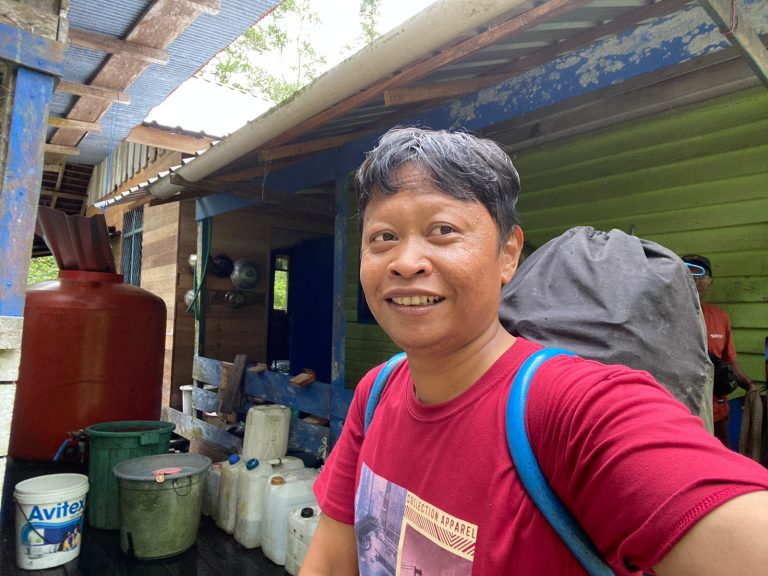
Experiencing quick break by visiting Tanjung Puting National Park to see Orangutan Borneo is such a blessing I feel the need to share with many other people, that’s why I have been focusing my energy building a team to help other people get the same feeling like I did the first time.
Our Founder

Thomas & Nella

Christy, Poe & Annie
Join & enjoy, tour to borneo island, meet orangutan wildlife with our professional guide.
We are an agency that provide tour packages to Visit Orangutan in Borneo, that’s why we name ourself such as that. With long history of providing guiding service, we are very familiar with Tanjung Puting National Park.
What are you waiting for? Come Visit Orangutan Borneo with Us
You will have wonderful experience.
Payment processor

connect with us

For wildlife, adventure & culture lovers
Sunbear sanctuary.
Visit one of the most threatened bear species in the world. You can experience the sunbear, which is native to the tropical rainforest in Borneo, from special viewing platforms.
In Samboja, near the orangutan sanctuary and the canopy bridge, you can visit one of the most threatened bear species in the world. The sunbear, which is native to the tropical rainforest in Borneo, is the smallest species of bears in the world. They are threatened and displaced from their natural habitat by human activity. At the sunbear sanctuary, the often called ‘honey bear’ finds shelter.
You can observe these unique bears from special viewing platforms and learn about their life, habitat and behaviour.

The sunbear sanctuary is nearby the Borneo orangutan sanctuary, canopy bridge, black river and biking and trekking trails. If you want to enjoy these adventures, why not stay overnight at one of the beautiful lodges at Bukit Bangkirai or the Samboja lodge?
What to see and do?

Tree planting and research

Cut the weeds with a machete and find the best places to plant different varieties of native trees. A fulfilling and educational activity to restore the habitat of Borneo’s wildlife.
Fishing Semayang lake

Join the local fishermen and go fishing on Semayang lake in the estuary of Makam river. Enjoy the sunset at one of the largest lakes in the country.
Swimming swamp buffaloes

Witness hundreds of Borneo swamp buffalo on their morning swim in the river. It is a spectacular daily routine and part of the buffalo farming in the Mahakam upriver area.
Bird watching

In the rainforest of Kutai Kartanegara you have beautiful possibilities for bird watching. For example in the wetland areas of Black River in Samboja or the nature reserve of Muara Kaman, upstream the Mahakam.
Spot the rare river dolphin

Ride a boat in the beautiful Borneo nature reserve of Muara Kaman and go on the look out for the rare river dolphin. In the meantime, enjoy proboscis, long tail monkeys and exotic birds ashore.
Boating black river

In the immediate vicinity of Bukit Bangkirai, you can experience the Borneo jungle by boating the rainforest river of Sungai Hitam. This is the so-called Black River, one of the wetland areas in East Kalimantan.
Biking trails

When you prefer to go by bike instead of by foot, you can rent an all terrain bike (ATB) and explore the rainforest through some exciting biking tracks.
Jungle trekking

To add to your Borneo adventure, you can go for jungle trekking at Bukit Bangkirai. There are various nature trails available which lead you to the heart of Borneo jungle.
Canopy walk

At Bukit Bangkirai, you can enjoy the tropical rainforest of Borneo through a canopy bridge at a height of 30 metres from the ground!

Borneo Orangutan Survival

Visit the Borneo Orangutan Survival sanctuary. An experience of a lifetime, to get up close with these beautiful primates and find out how they are prepared to return to their natural habitat.
Pin It on Pinterest

Animals Around The Globe (US)
Best Places to See Orangutans
Posted: April 17, 2024 | Last updated: April 17, 2024
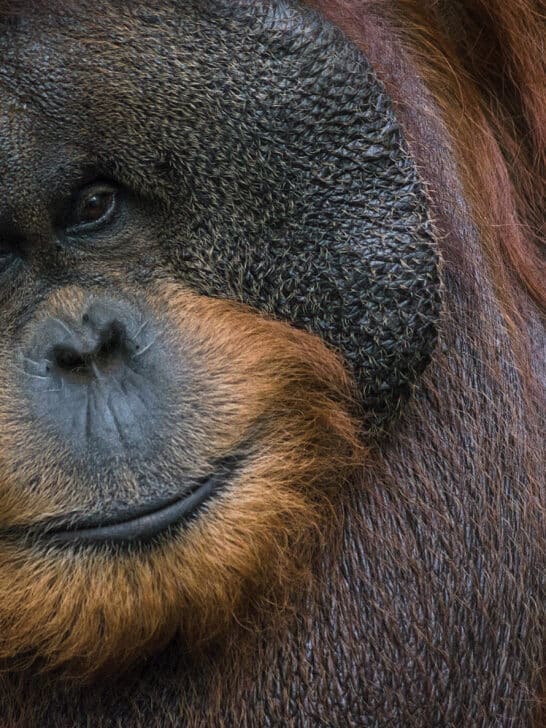
Are you looking for the Best Places to See Orangutans? We have searched everywhere for you to find the best places to see Orangutans in the wild.
Orangutans belong to the great apes , along with gorillas and chimpanzees . Surprisingly, orangutans are the only great apes that are not found on the African continent.
Are you a fan of the African Continent? Look at our blog, All about Mountain trekking with the Gorillas .
In their social behavior, they are very similar to humans and surprise their observers again and again with their behavior: Orangutans grab, brood and even powder themselves.
Visually, the orangutans are the least similar to humans among all apes – and this is what makes them so fascinating!
Key Points :
Just have a look at the outline and jump to whatever part appears as the most interesting one for you.
This article is intended to introduce you to the way of life of orangutans and ultimately to help you admire them up close.
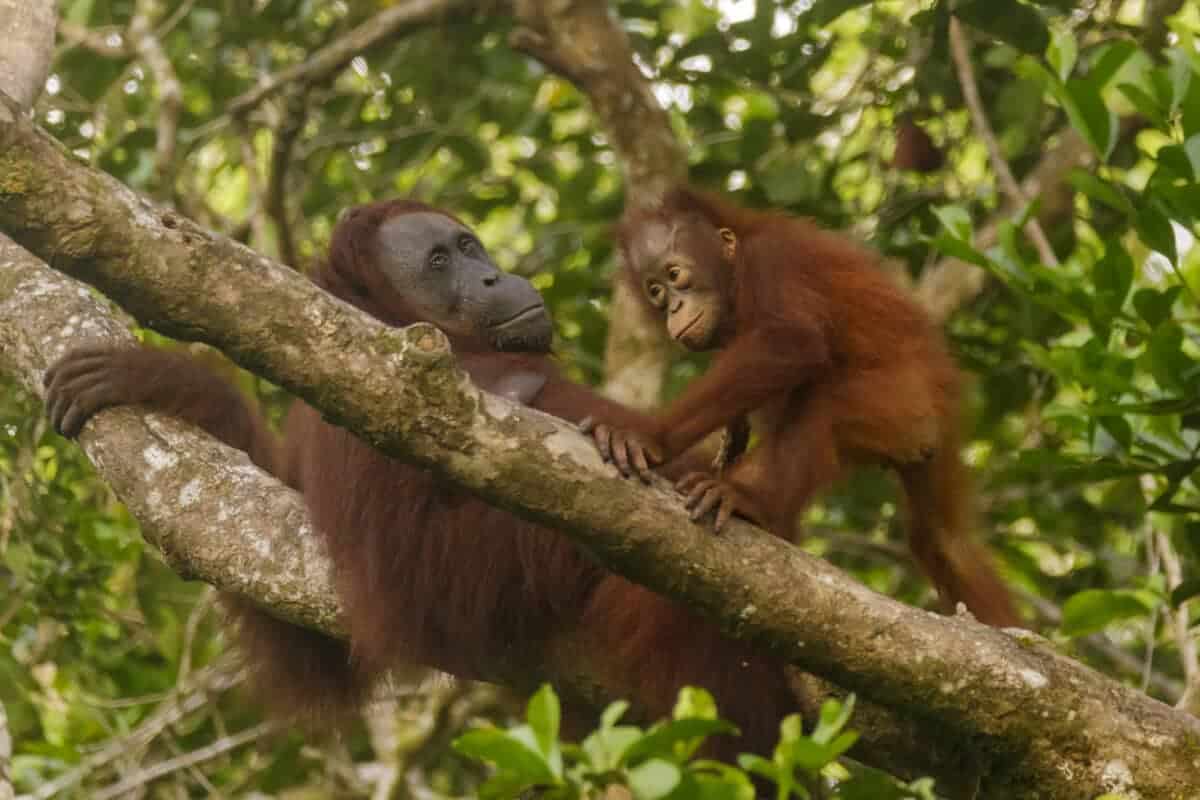
Image via Thomas Fuhrmann, CC BY-SA 4.0 <a href="https://creativecommons.org/licenses/by-sa/4.0">https://creativecommons.org/licenses/by-sa/4.0</a>, via Wikimedia Commons
- Orangutans are part of the great apes family, along with gorillas and chimpanzees.
- They are the only great apes not found in Africa.
- Orangutans are classified as endangered as of 2023.
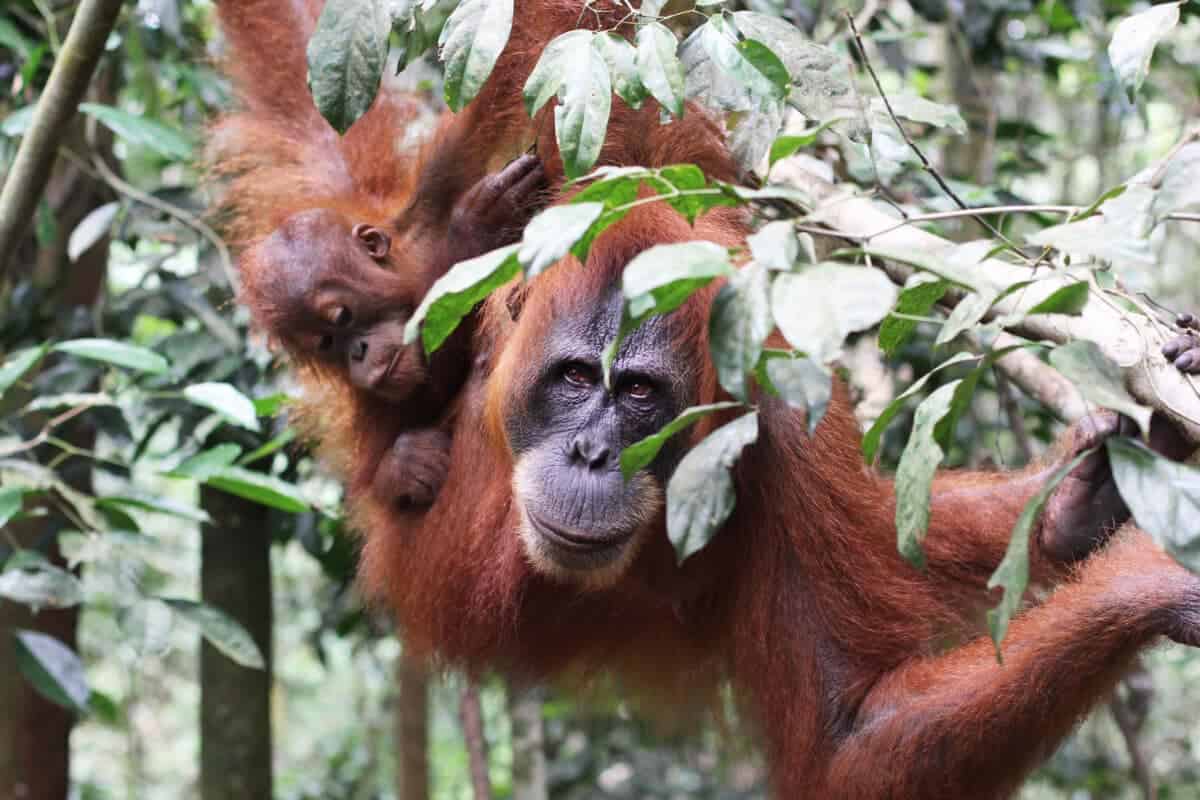
General Facts about Orangutans
A female gets her first young at age 15, which she looks after for up to eight years with close contact. Orangutans give birth to a maximum of four children during their lifetime – one reason why it is so challenging to maintain their population. In the wild, Orangutans live up to 50 years. So there are many Best Places to See Orangutans.
Orangutans reach a size of 1.25 to 1.5 meters and have an impressive wingspan of up to 2.25 meters. In terms of weight, there is a clear difference in sexes: males weigh 50 to 90 kilograms, almost twice as much as females, who weigh 30 to 50 kilograms.
Their arms are very long, the hands hook-shaped, the thumb short and close to the wrist, the legs short and very flexible, and the feet hand-like. This physique offers the optimal conditions to move high and freely up in the trees.
Granted, high up in the trees, you won’t be able to keep up with the orangutans.
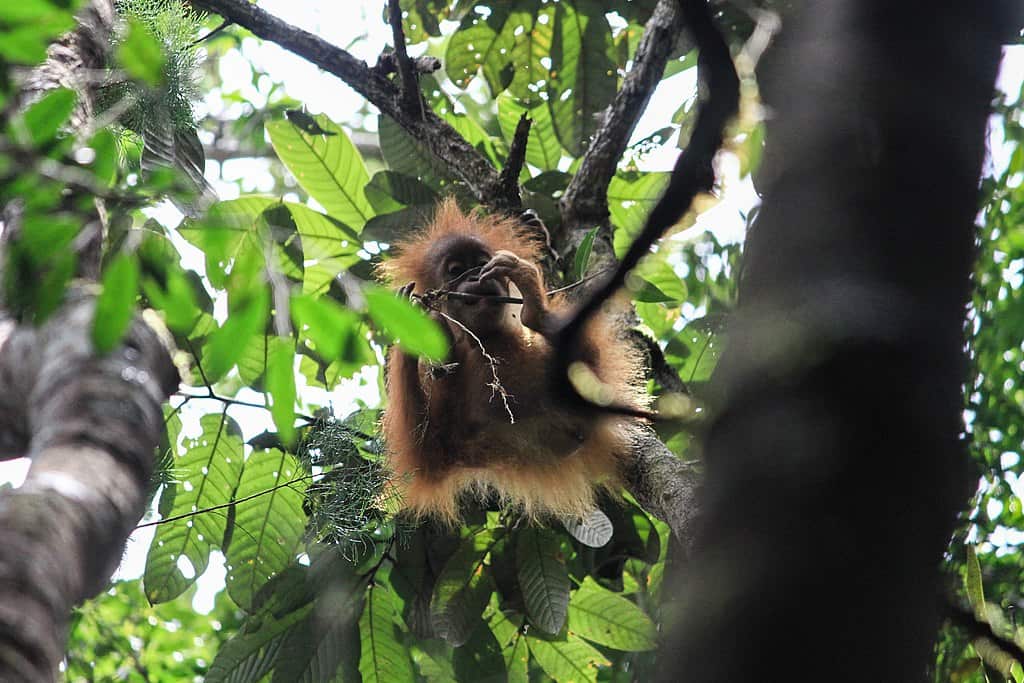
Social Behavior of Orangutans
Orangutans are quieter than other apes. More noticeable sounds are the loud cries of the males to mark their territory. Little is known about other vocal expressions or communication by means of facial expressions and postures.
Apart from the close bond between child and mother, orangutans are usually found individually. Interactions between conspecifics take place but are largely unexplored. When two males collide, this can lead to a dispute. The females, on the other hand, behave more peacefully and have even been observed to search for food together, studies show.
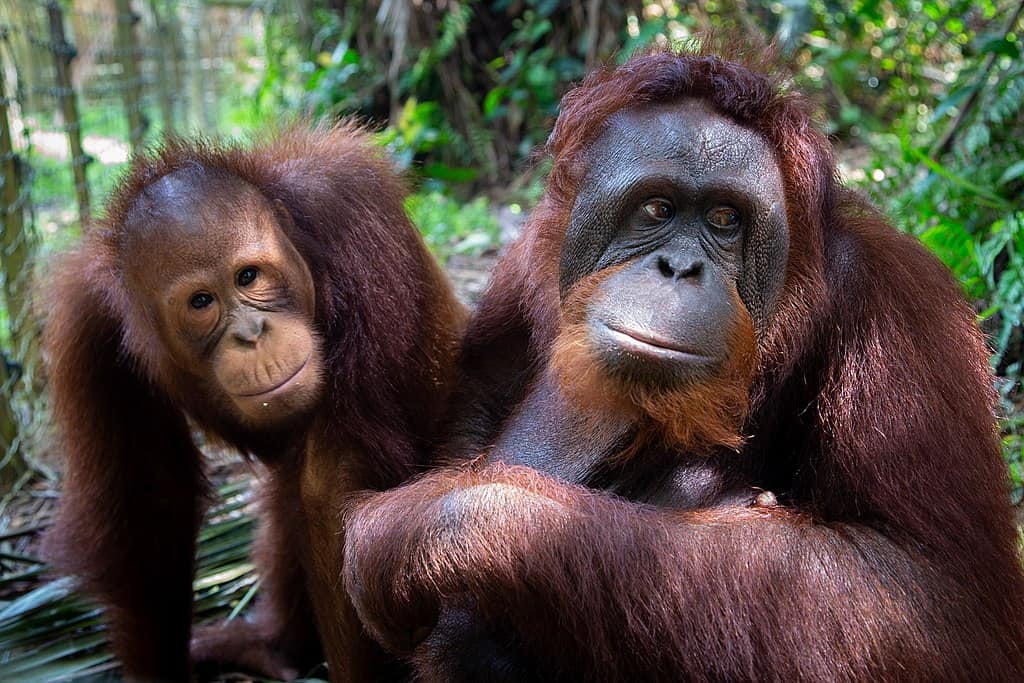
Tapanuli orangutans were not discovered as a separate species until 2017 and live on the Indonesian island of Sumatra. Their small distribution area can be seen on the map. The species lives in a narrowly limited distribution area, which is a forest area south of Lake Toba. Before the species was biologically defined, the small population of Tapanuli orangutans was counted as Sumatran orangutans.
There are generally three different types of orangutans: Borneo Orangutans , Sumatran Orangutans and Tapanuli Orangutans . All three species live on Borneo and Sumatra, two huge islands.
Orangutan learn everything they need from their mum. Image via Bruce Poon, CC BY-SA 4.0 https://creativecommons.org/licenses/by-sa/4.0 , via Wikimedia Commons
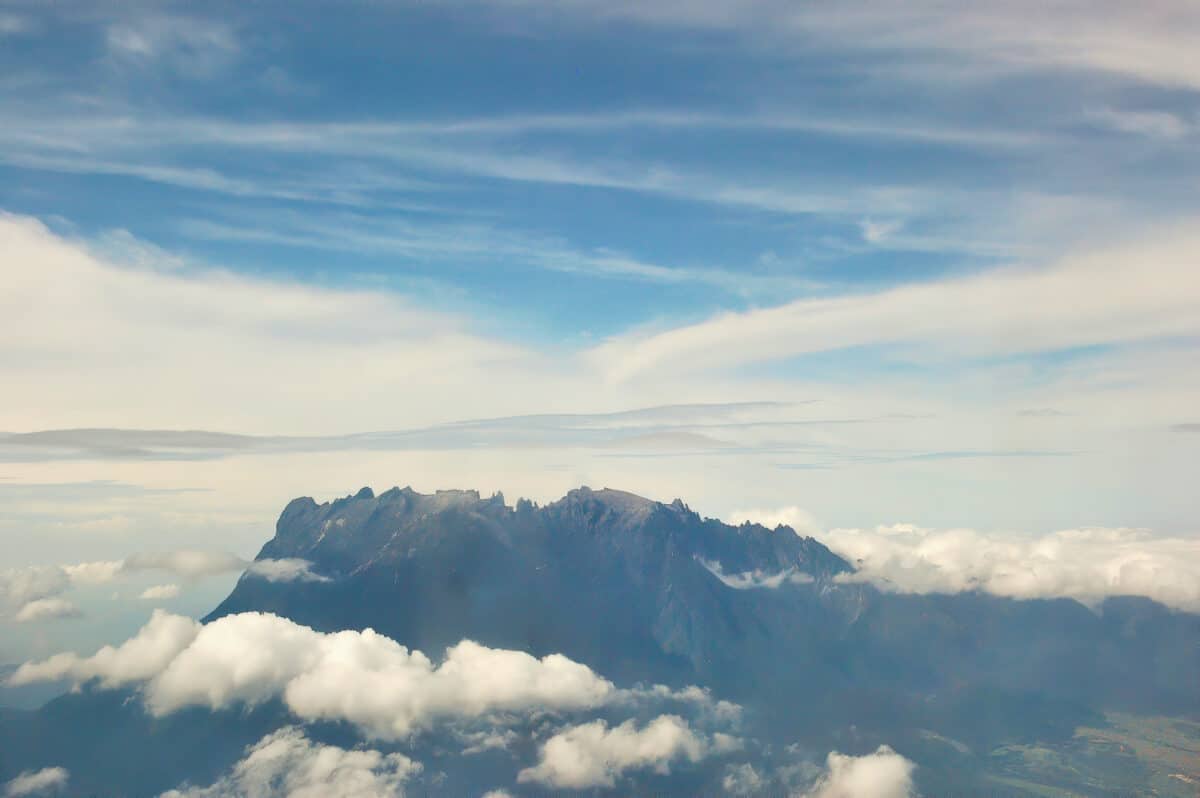
In the middle of it all is Gunung Kinabalu. With 4,095 meters, it is the highest mountain in Southeast Asia. The city is practically surrounded by the rainforest and so the national park is only about 70 kilometers away. This is a stone’s throw away for an island the size of Borneo. The best way to get there is by bus, where you also get to know local people!
You will probably arrive at the airport of Kota Kinabalu, Malaysia. From there, you can start your discovery tour of Borneo. Kota Kinabalu is the capital of the state of Sabah and the gateway to Kinabalu National Park. Here you will find the oldest rainforest in the world, with an area of 75,370 hectares and a thousand different animal and plant species.
But, as just mentioned, Borneo is enormous – twice the size of Germany. So how are you supposed to find your way around there and, more importantly: How to climb with Orangutans ?
So when you are there, you get to see things that are not found anywhere else. Borneo orangutans for example. Borneo Orangutans can be found best in the south of the island, but even in the northeast of Borneo, you might meet the calm creatures climbing in the trees. A great place Where to See Orangutans.
On average, the sun shines on Borneo five hours a day. The rainforest on the equatorial island is one of the oldest in the world. There exists a rich treasure of different plant and animal species. Many of these plants and animals are endemic, which means that they are only found in the form of Borneo.
Most of Borneo belongs to Indonesia, other parts belong to Malaysia and even Brunei. The island is cut in the south by the equator and therefore has a predominantly tropical climate with high humidity. On the sizeable southern part of the island, there is no rainy season and the average temperature fluctuates around 27 degrees Celsius. The best time to travel is from March to September. April and July are considered the best months to travel because of the more moderate climate. Another reason why it’s so great to see Best Places to See Orangutans.
Borneo is home to the largest population of the species of orangutans. It is the third largest island in the world, the largest island in Asia and offers paradisiacal views.
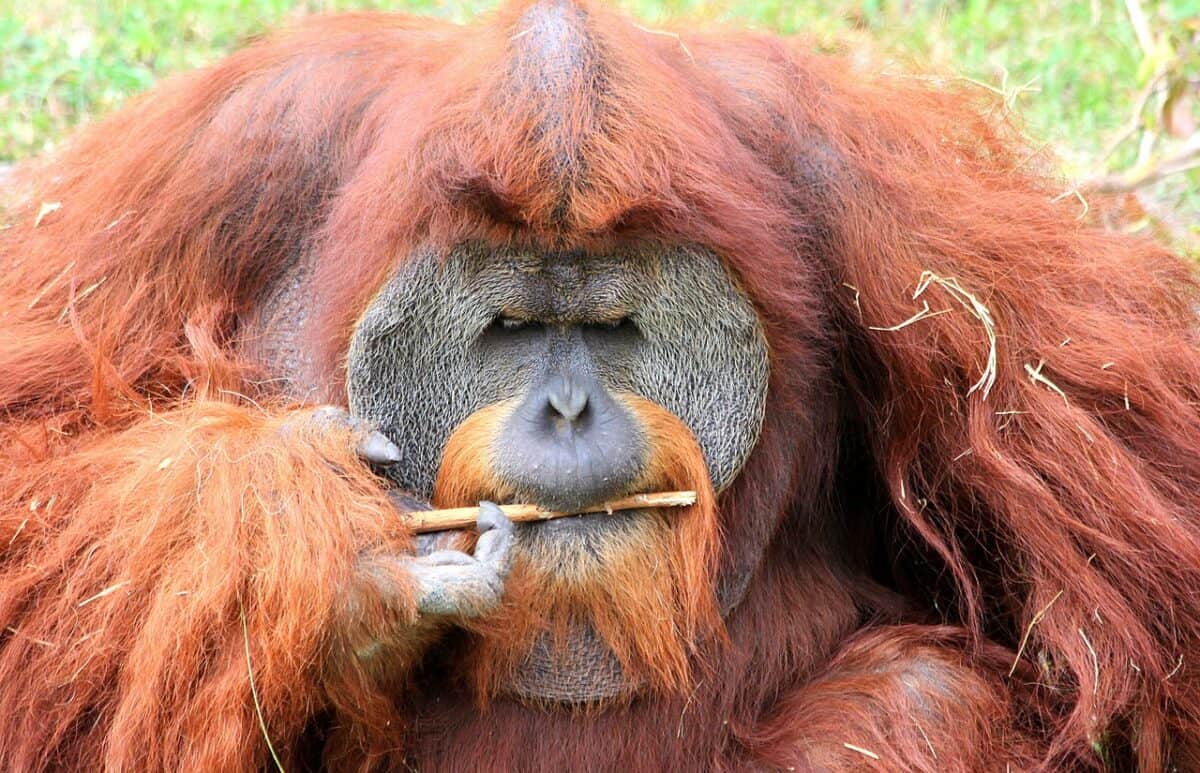
Endangerment of Orangutans
To read more about other highly endangered species, read this blog post .
On-site, you can visit the different animal protection stations and interact with orangutans.
- – Reforestation of destroyed rainforest on Borneo
- – Orangutan reintroduction projects
- – Environmental education in Indonesia and Germany
- – Support for the orangutan sanctuary in Pasir Panjang on Borneo
- – Support of the orangutan reintroduction centre in Jantho on Sumatra
To maintain the populations of the great apes, various projects are supported:
In Java, it has already become extinct, and on Borneo and Sumatra, it is facing the same fate: according to estimates by the World Conservation Union IUCN, there are still around 104,700 orangutans on Borneo and around 13.846 on Sumatra. The WWF estimates that the number of orangutans in Borneo is now much lower, at around 54,000.
The forests are cut down for timber production or to use the area agriculturally, e.g. for palm oil plantations. The orangutans need treetops in the rainforest because this is where they build their nests and look for food. As we have learned before, orangutans have few offspring in the course of their lives. This makes it particularly difficult to maintain populations.
The fact is, these beautiful, impressive animals are threatened with extinction!
More for You
Judge Agrees to Give Donald Trump Access to Private Information
18 Life Rules Jesus Gave Us to Live By
Top 24 Short Actors Who Made a Big Impact
25 Beloved Movies We’ll Never Let Our Kids Watch
Police open investigation into American Idol star Mandisa’s death aged 47
The Only Way You Should Store Butter, According to Land O'Lakes
Ketanji Brown Jackson's New Warning To Supreme Court
Plane forced to land after filming melted windows
5 Things You Need To Stop Doing If Your Car Has An Automatic Transmission
Patrick Mahomes explains why he may not play in the NFL for as long as Tom Brady
29 Ridiculous Lies That Hollywood Has Managed to Mainstream
'Unhealthy dose' of pesticides found in popular produce, new report reveals
Kyrie Irving reacts to Team USA snub: "I grew up in a time when we actually had to try out for USAB"
How to Clean Your iPhone’s Charging Port the Right Way
Colossal prehistoric snake discovered in India
Taylor Swift's ‘The Tortured Poets Department' is Messy, Unguarded And Undeniably Triumphant: Critic's Take
Costco Finally Sells the $25 Lodge Product I Use for Breakfast, Lunch, and Dinner
20 TV characters who died because the actor who played them died in real life
8 Shoes to Wear with Leggings This Spring That Aren’t Sneakers
25 human foods you should never give your dog—and 25 foods you can

IMAGES
VIDEO
COMMENTS
the facts. At Samboja, you can visit the Borneo Orangutan Survival (BOS) sanctuary. An experience of a lifetime, to get up close with these beautiful primates. The BOS Foundation is currently taking care of around 750 orangutans in a conservation area of some 80 km2. The orangutans have been rescued from areas of conflict, where they lost their ...
1. Sepilok Orangutan Rehabilitation Centre (Pusat Pemuliharaan), Sandakan. Orangutan coming in for feeding at the Sepilok Orangutan Sanctuary. Perhaps the most well-known orangutan sanctuary in Borneo is the Sepilok Orangutan Sanctuary located just 25km outside Sandakan, to the west of the Sabah region of Borneo.
When is the best time of year to visit Borneo? Sepilok Orangutan Centre is open all year round. If you want favourable weather conditions in Borneo for your visit, the best time is in the summer months, June, July and August, when it is dry with only light showers. ... When is the Sepilok orangutan sanctuary open? The centre opens at 8:30 a.m ...
Andrew Watson/Photolibrary/Getty Images. View Map. Address. KM 20, Borneo Highland Road, 93250 Kuching, Sarawak, Malaysia. Phone +60 82-618 325. Web Visit website. The Semenggoh Wildlife Rehabilitation Centre, just 12 miles from Kuching, is the best place to find orangutans in Sarawak.
Orangutan Sanctuary. Samboja Lestari Orangutan Sanctuary is one of Indonesia's most prestigious and renowned orangutan rehabilitation and rescue centres. The emphasis is on the rehabilitation and release of orangutans, many of whom were rescued from atrocious situations. Our Sanctuary also includes a 58 hectare area for over 70 resident sun ...
A trip along the Kinabatangan River - the second longest river in Malaysia - is another key place to spot orangutans where over 1,100 live. Yet it is significantly harder to spot them as they are rather elusive and the rainforest here is very dense. We saw two orangutans at our lodge, far along the Kinabatangan River.
Getting There: We took the local bus and made the visit on our own. There is a local bus that leaves from downtown Sandakan to Sepilok daily, this will drop you off right at the Sepilok Orangutan Rehabilitation Center. Be sure to catch Bus 14, which leaves hourly from the minibus station from 9:00 to 14:00.
With that in mind, read on to find out where to see orangutans in Borneo. The ideal destination for orangutan sightings. Best places to see orangutans in Borneo. #1 Sepilok Orangutan Rehabilitation Centre. #2 Tanjung Puting National Park.
The Great Projects are proud to offer the opportunity for you to visit the orangutans in Borneo on any one of our many orangutan projects: spend time at the Samboja Lestari Orangutan Sanctuary to volunteer with our arboreal cousins; pay a visit to the world-famous IAR Sanctuary in Indonesian Borneo; or make a difference when visiting orangutans ...
Explore Our ProgramsOfficial VisitorsVolunteer With UsJournalists & Media ProfessionalsProfessional VolunteersResearchers. BORNEO ORANGUTAN SURVIVAL (BOS) FOUNDATION. Jalan Kumbang No. 31. Bogor 16128. West Java, Indonesia. PHONE. (0251) 8314468. EMAIL. [email protected].
Sabah gives you the opportunity to visit a number of wildlife hotspots relatively close together. These include the Danum Valley, Kinabatangan River, Tabin Wildlife Reserve, Deramakot and the Sepilok Orangutan Rehabilitation Centre. At Semenggoh in Sarawak you can see orangutans in a sanctuary, but rarely in the wild.
A visit here is often cited as one of the highlights of our Borneo holidays. Quick Facts: The orangutans: approximately 60-80 orangutans live freely in the reserve. Sanctuary in a nutshell: founded in 1964 and was the first sanctuary in the world to offer rehabilitation to orphaned orangutans.
Nyaru Menteng Sanctuary in Borneo. Find out why the world's largest orangutan rehabilitation centre needs your help. Nyaru Menteng Sanctuary in Indonesian Borneo offers a step-by-step programme for orangutans to return to the wild as well as employment opportunities for local people and agricultural alternatives for a sustainable future.
3. Gunung Leuser National Park. This vast park shelters some of Asia's greatest and most endangered mammals, including the orangutan, elephant, tiger and rhinoceros. With mountain peaks soaring to 3,400m above the dense jungles and rivers, this is a magnificent backdrop for your orangutan tour.
In the Spotlight. This incredible show has it all, taking viewers on a roller coaster ride of adventures, heartaches, fun, friends, failures, and successes of all the orangutans who attend the BOS Foundation's unique school. Wildlife tourism has become a lucrative business worth around 250 billion dollars a year. These profits come at a cost.
Volunteer with orangutans on this award-winning orangutan project at Matang Wildlife Centre in beautiful Borneo! Situated within the tropical Kubah National Park, The Great Orangutan Project is a volunteer experience of major importance: not only is it the very first conservation experience started by The Great Projects, but it is one which we ...
Sandakan. The Sepilok Orang Utan Rehabilitation Centre (SOURC) was established in 1964 to rehabilitate orphaned orangutans. It has since grown from having just an outdoor platform to having an Outdoor Nursery viewing area. It is located within the Kabili-Sepilok Forest Reserve, making the area suitable for trekking and birding.
Join an official BOS Orangutan Volunteer Program. Spend two weeks in beautiful Borneo at Samboja Lestari, a sanctuary that cares for approx 125 orangutans and 72 sun bears. If you are passionate about protecting orangutans and want to make a practical difference, this program is for you. Situated within the Bornean tropical rainforest, Samboja ...
Gallery. Our tour guides take amazing photographs of the wildlife and tours. The following are just a glimpse into some of the incredible experiences you will have on an Orangutan Trekking Tour. Travel through the beautiful untamed lands of Borneo. Our orangutan trekking tours have been carefully designed to build an awareness of ecotourism.
Project Borneo at a Glance. Our work with endangered species in Borneo began with Project Orangutan in 2006, and the scope of the charity has expanded steadily ever since. Our hugely successful ethical volunteer and tour programmes are at the heart of what we do, providing essential hands-on-deck - as well as unforgettable experiences.
The world-renowned orangutan conservation facility located in the state of Sabah, Malaysia on the island of Borneo. The centre's primary mission is to rehabilitate and provide a safe haven for orphaned and injured orangutans, one of the world's most endangered primates. Orangutan Appeal UK has been actively supporting the centre since 2001 ...
Houseboat tour special (7d6n) 7 Days, 6 Night. book now. Experiencing quick break by visiting Tanjung Puting National Park to see Orangutan Borneo is such a blessing I feel the need to share with many other people, that's why I have been focusing my energy building a team to help other people get the same feeling like I did the first time.
You may like. TikTok video from Amber | Solo Travel🌍 (@awaywithamberr): "Seeing orangutans at Sepilok Orangutan Sanctuary in Borneo - a completely ethical programme and an unreal experience🦧🧡 #fyp #orangutan #orangutansanctuary #borneo #malaysia". The Champion - Lux-Inspira.
Sunbear sanctuary. In Samboja, near the orangutan sanctuary and the canopy bridge, you can visit one of the most threatened bear species in the world. The sunbear, which is native to the tropical rainforest in Borneo, is the smallest species of bears in the world. They are threatened and displaced from their natural habitat by human activity.
Borneo is home to the largest population of the species of orangutans. It is the third largest island in the world, the largest island in Asia and offers paradisiacal views. Sharks, lions, tigers ...